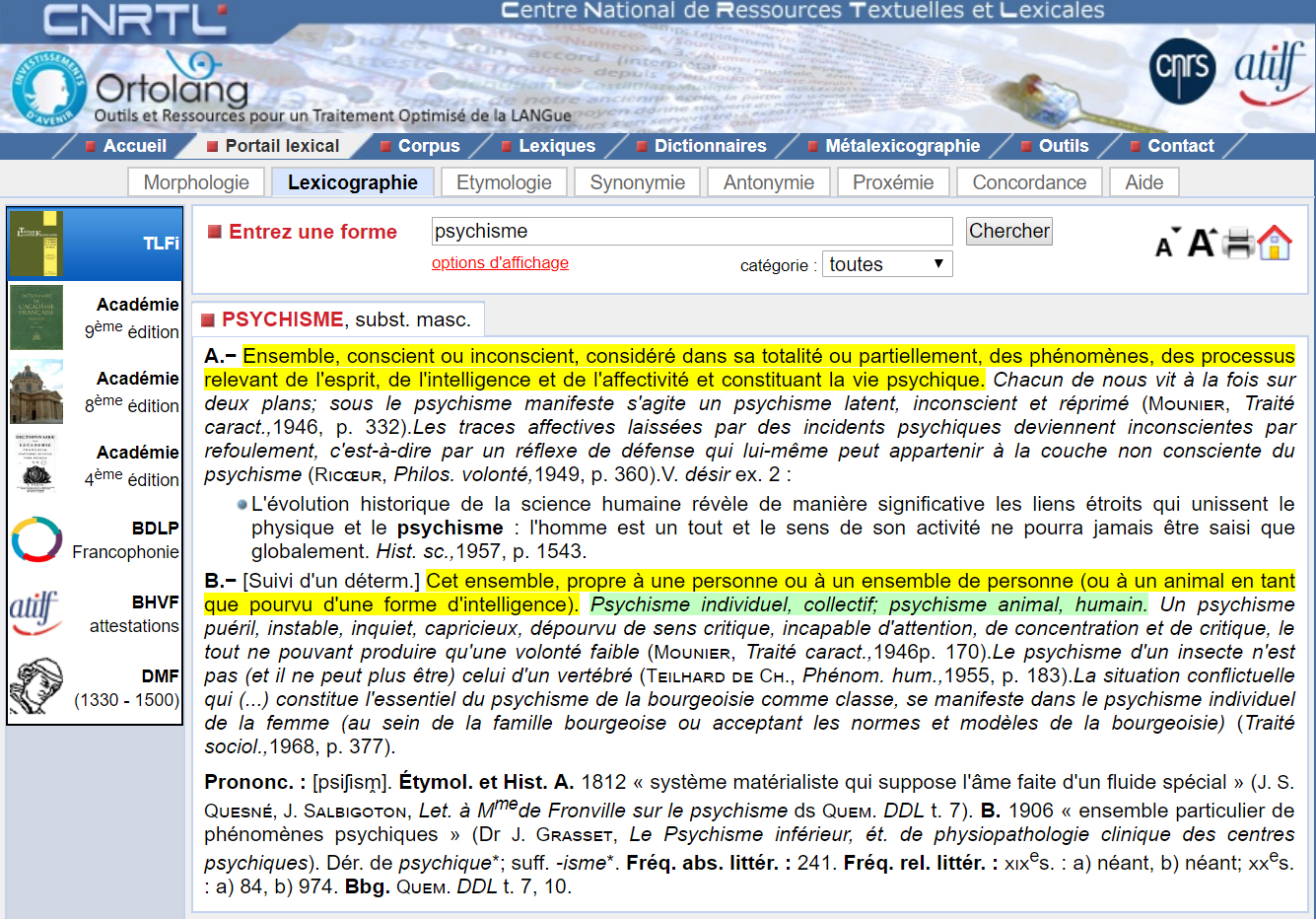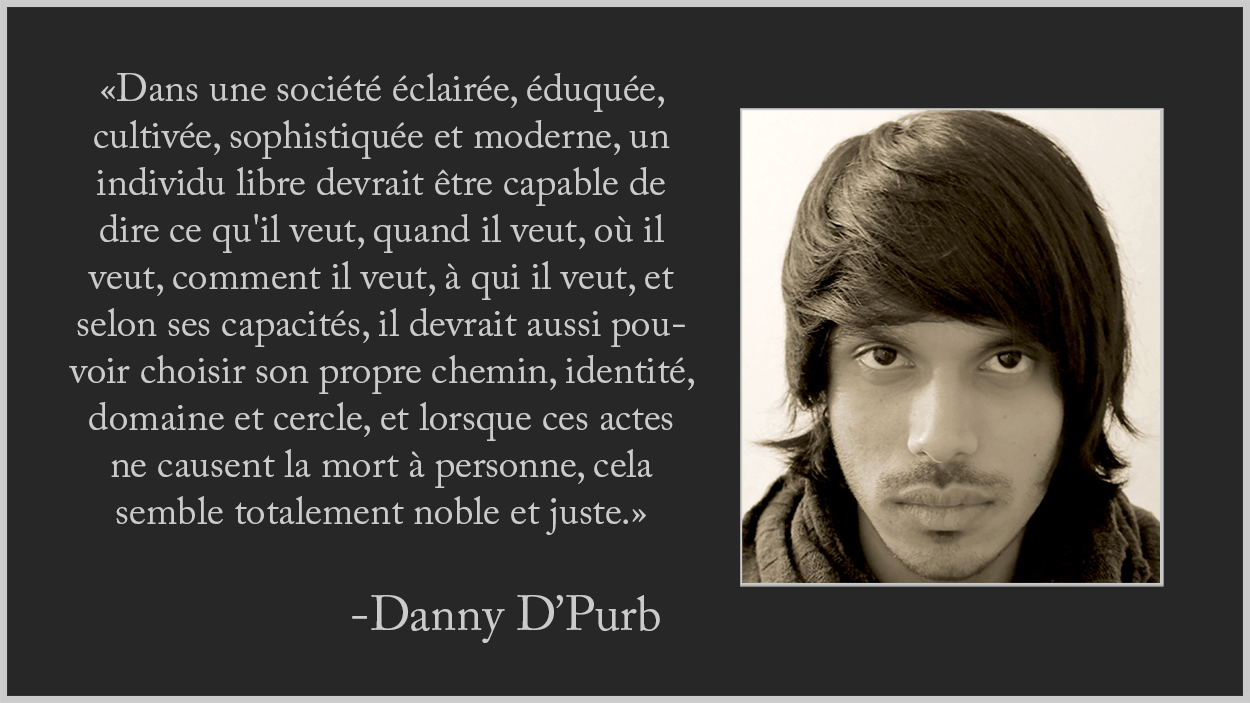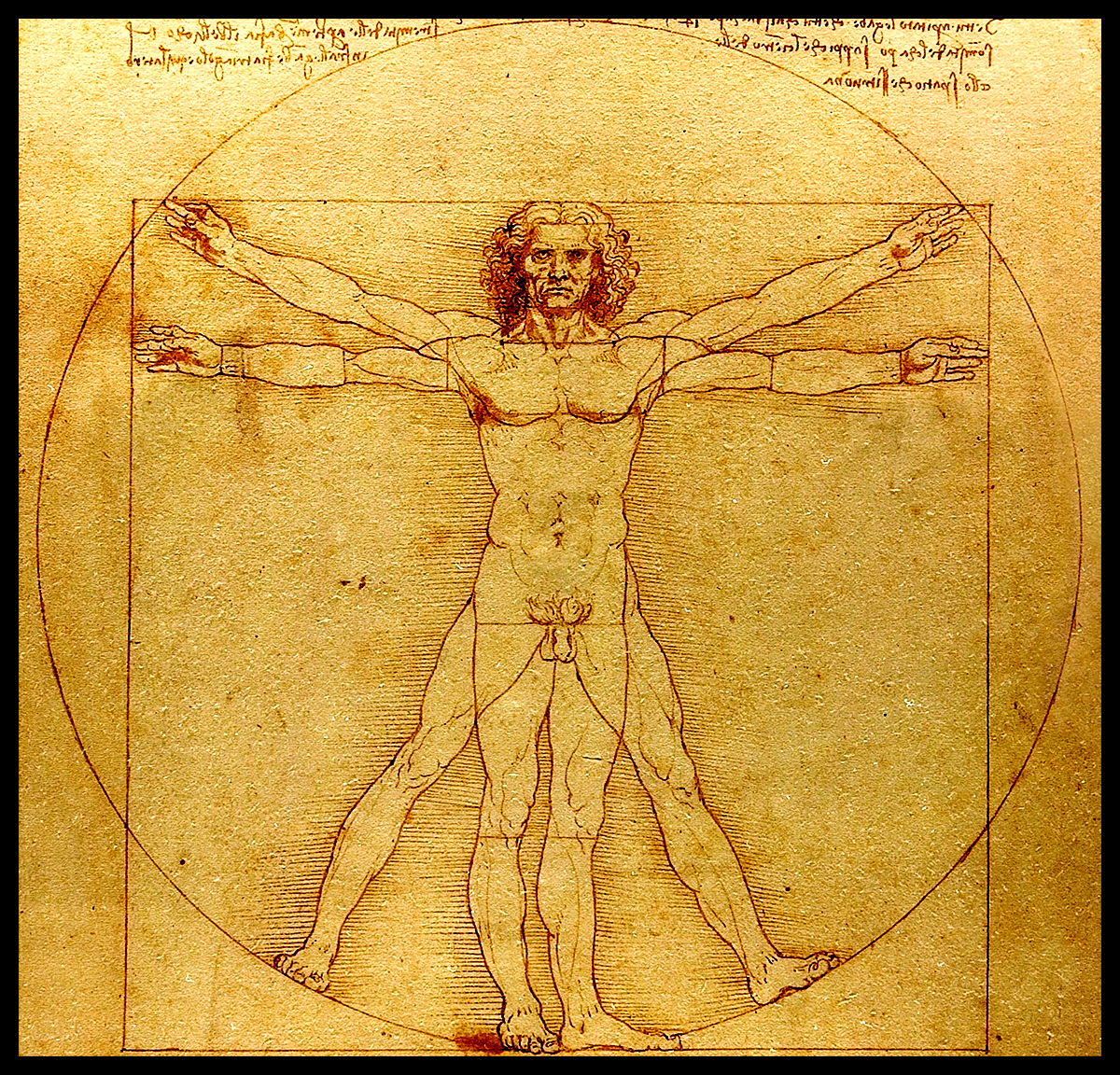Mis-à-jour le Mercredi, 25 Janvier 2023

Photographie: Danny J. D’Purb © 2008
History and Background
In contemporary psychology, the psychoanalytic movement’s place is both unique and paradoxical. Focussing on the study of the mind as a “software” running on the brain as the “hardware”, psychoanalysis remains the only discipline that truly focuses on the mechanism and processes behind our thoughts. Unlike empirical behavioural science and other “cogno-sciences” that can be fairly barbaric and obstinate in the forced application of the rigid mathematical and reductionist systematic procedures embedded in the classic scientific method when dealing with an entity as complex and organic as the human mind; psychoanalysis has remained focussed in understanding human psychology by capturing it in all its details, depths, dimensions and linguistic aspects.
The scientific method although a proven mathematical approach to inquiries in the hard sciences [e.g. biology, medecine, physics, chemistry, astrophysics, material science, astronomy, etc], shows its limitations when used as a tool for psychological inquiry in the measurement of variables that are incredibly hard to measure such as emotions, values, motives, desires, libidinous intensity or dreams. It is also fair noting that humans are different from simple organisms, molecules or robots, hence psychoanalysis remains the only discipline focused on the mind [the software] assuming that most human beings have a physiologically healthy brain [the hardware].
However, modern sciences have discovered how abnormalities in the brain’s physiology due to birth defects or injury may result in behavioural problems linked to a deficient mind due to the defective brain [hardware] at its disposal. Hence, nowadays most good intellectuals in the field of psychoanalysis would likely be a better psychologist with an in-depth knowledge of the physiology of the brain, i.e. the major areas affecting core functions such as speech [Wernicke and Broca’s], vision [the occipital lobe], and motor abilities [parietal lobe], etc.
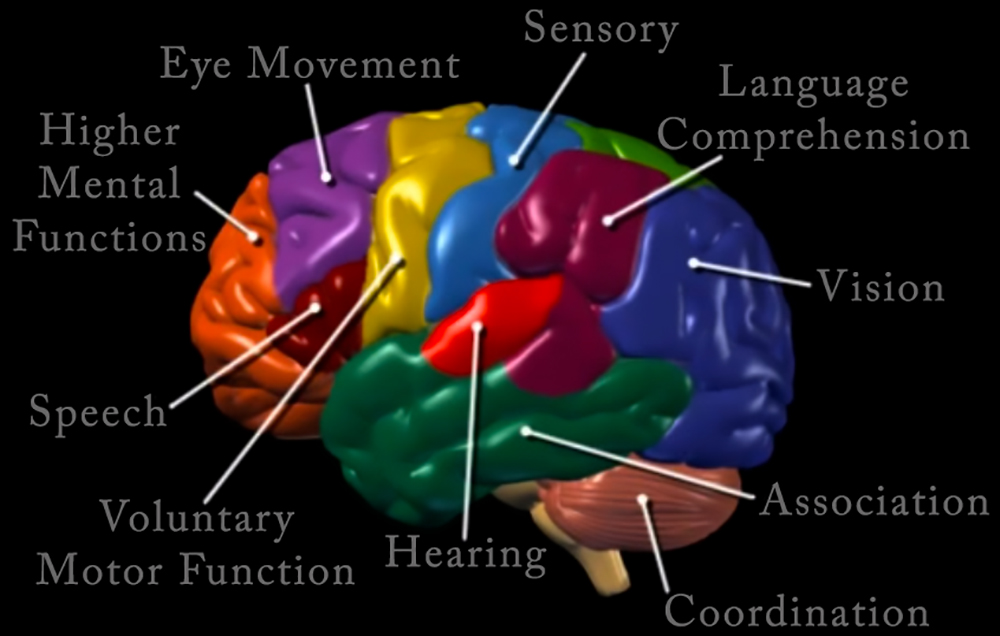
This is because some psychological problems may on rare occasion be caused by brain injuries or physiological abnormality due to virus, trauma, stroke or injury. In those cases where such a scenario materialises, the psychotherapist may refer the patient to a neurosurgeon who may be more appropriate to inspect the extent of the problems on the defective brain [hardware] which may lead to a clearer perspective of the limitations being imposed on the mind of the affected individual and how it impacts processes such as the conscious, the preconscious and the unconscious [based on Sigmund Freud’s 1st ground breaking theory of mental life, the Topographic Model, which was also adopted by Jacques Lacan who argued convincingly that post-Freudian psychoanalysts had swayed too far from the fundamental concepts and turned psychoanalysis into a confusing genre].
However, as we are in the developmental stages of conception of the organic theory, a theory that takes the focus on the individual organism’s creative ability to another level, we are going to remain focussed on the mind. The organic theory was inspired by the brain’s magnificent ability to learn any age, and thus give the individual human organism the ability and freedom to define, create, redefine, recreate and shape itself based on its inherited and acquired abilities, desires and personal constructionist developments throughout its life – yes, the individual does have choices and these impact the person’s internal working model of mental life and the person as a whole along with his or her environment.
While psychoanalysis remains one of the most widely known schools of psychology it is perhaps not universally understood. The founder of psychoanalysis, Sigmund Freud is perhaps one of the most famous psychologist of the last century even if his chosen discipline, psychoanalysis, has little in common with the other schools of thought and psychology.
Psychoanalysis views the mind as an active, dynamic and self-generating entity, and this is in the German tradition of mental life [it was also a founding assumption for Jean Piaget as he developed his Theory of Cognitive Development in Children]. Freud saw psychoanalysis as a revolution of the mind that had to disturb the consciousness of the world, and viewed the unconscious as a reservoir of impulsive force repressed in the biological depths of the soul.

“Tête Raphaélesque Éclatée” par Salvador Dali (1951)
It is also important to note that Freud was trained in hard sciences, yet his system shows little appreciation for systematic and reductionist empiricism. As a physician, Freud used his observational skills to build his system within a medical framework, basing his theory on individual case studies. He did not depart from his understanding of 19th-century science in the effort to organise his observations, neither did he attempt to test his hypotheses rigorously through independent verification. As he testified, he was psychoanalysis and did not tolerate dissension from his orthodox views. Nevertheless, Freud had a tremendous impact on 20th century psychology, perhaps more importantly, the influence of psychoanalysis on Western thought, as reflected in literature, philosophy and art, significantly exceeds the impact of any other system and school of psychology.
The Active Mind

Photographie: Danny D’Purb © 2012
Going back to the philosophical foundations of modern psychology in Germany during the 17th, 18th and 19th centuries, we found that the tradition of Leibniz and Kant clearly emphasised mental activity. This is in contrast to British empiricism, which assumed the mind to be a passive entity [such as a sponge that simply soaks in what is thrown at it]. The German tradition held the most logical and creative assumption that the mind itself generates and structures human experience in characteristic ways [being “active”]. Whether through Leibniz’s monadology or Kant’s categories, the psychology of the individual could be understood only by examining the dynamic, inherent activity of the mind.
Throughout the years, as psychology evolved into an independent discipline in the latter part of the 19th century under Wundt’s tutelage, the British model of mental passivity served as a guiding philosophy. Clearly, Wundt’s empiricistic formulation was at odds with German philosophical precedents, recognised by both Stumpf and Brentano. Act psychology and the psychology of non-sensory consciousness represented by the Würzburg School were closer to the German philosophical assumptions of mental activity than to Wundt’s structural psychology. The Gestalt movement encompassed these alternatives to Wundt’s psychology in Germany. Eventually, as the rational outcome guided intellectuals, Wundt’s system was replaced by Gestalt psychology, turning into the dominant psychology in Germany prior to World War II – one based on a model of the mind that admitted inherent organisational activity.
The assumptions underlying mental activity in Gestalt psychology were highly qualified, where construct for mind involves the organisation of perception, based on the principle of isomorphism, which resulted in a predisposition toward patterns of personal-environmental interactions. The focus on organisation meant that the way of mental processes, not their content, was inherently structured. In other words, individuals were not born with specific ideas, energies, or other content in the mind; rather, the organisational structure was inherited to acquire mental contents in characteristic ways. Accordingly, the Gestalt movement, while rightly rejecting the rigidity of Wundt’s empiricistic assumptions and concepts, did not reject empiricism completely [as a technique to study some basic and easily defined variables (such as traits) and their relation(s) to others]. Instead, the Gestaltists advocated a compromise between the empiricist basis of British philosophy and the German model of activity. Consequently, this opened psychological investigation to the study of complex problem-solving and perceptual processes.
Consistent with the Gestalt foundations, psychoanalysis was firmly grounded in an active model of mental processes, however it shared little of the Gestalt commitment to empiricism. Freud’s views on personality were consistent not only with the activities of mental processing suggested by Leibniz and Kant, but also with the 19th century belief in conscious and unconscious levels of mental activity. In acknowledging the teachings of such philosophers as Von Hartman and Schopenhauer [Read the Essay on our Review of “Die Welt als Wille und Vorstellung”(The World as Will and Idea), Freud developed motivational principles that depended on energy forces beyond the level of self-awareness.
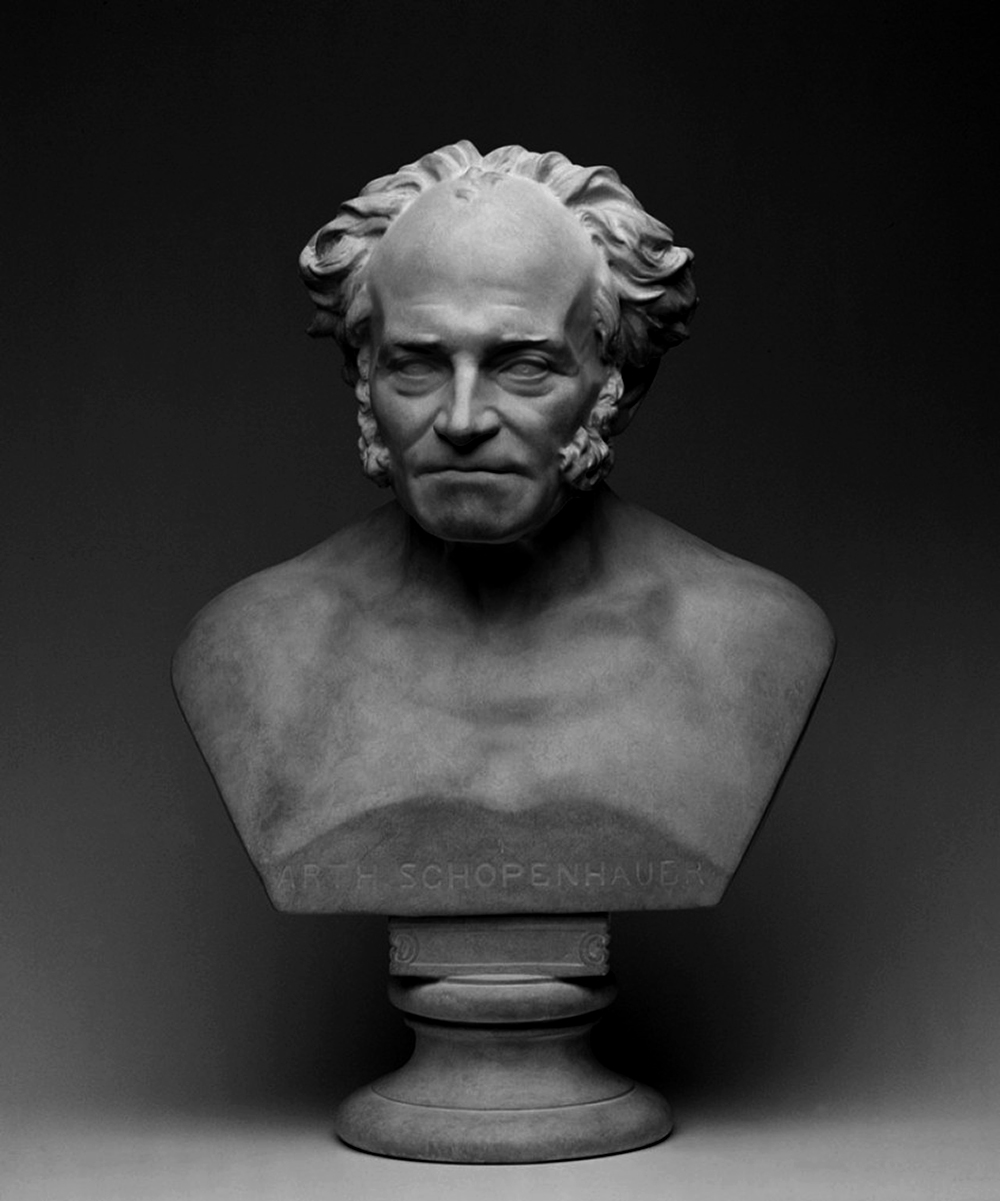
Arthur Schopenhauer (1788 – 1860)
Moreover, for Freud, the development of personality was determined by individual, unconscious adaptation to these forces. The details of personality development as formulated by Freud are outlined below; however, is also important to recognise the fundamental basis of Freud’s thinking. Psychoanalysis is based on the implication of mental activity further than any other system of psychology. As a major representative of a reliance on mental activity to account for personality, psychoanalysis is set apart from other movements in contemporary psychology. In addition, psychoanalysis unlike the other branches of psychology, did not emerge from reductionist empirical research that stubbornly tries to apply mechanical scientific methodology to measure complex non-physical abilities; rather it was the product of the applied consequences of clinical practice [i.e. it was a force that was born on the field to treat mental problems as they surfaced throughout human history].
The Treatment of Mental Illness
Besides being the founder of the psychoanalytic movement in modern psychology, Freud is also remembered for his efforts in pioneering the upgrade in the treatment of mental and behavioural abnormalities, and was instrumental in psychiatry’s recognition as a branch of medicine that specifically deals with psychopathology. Before Freud’s works in attempting to devise effective methods of treating the mentally ill, individuals who deviated from socially acceptable norms were usually treated as if they were criminals or demonically possessed. Although shocking controversies in the contemporary treatment of mental deviancy appear occasionally, not too long ago such abuses were often the rule rather than the exception.
The treatment of mental illnesses was never a pleasant chapter in Western civilisation and it has been pointed out many times that abnormal behaviour is often mixed up with criminal behaviour as with heresy and treason. Even during the period of enlightenment during the European Renaissance, the cruelties and tortures of the inquisition were readily adapted to treat what we nowadays qualify as mental illness. Witchcraft continued to offer a reasonable explanation to such eccentric behaviour until recent times. Prisons were established to house criminals, paupers, and the insane without any differentiation. Mental illness was viewed as governed by evil or obscure forces, and the mentally ill were looked upon as crazed by such weird influences such as moon rays. Lunatics or “moonstruck” persons, were appropriately kept in lunatic asylums. As recently as the latter part of the 19th century and the beginning of the 20th century, the institution of for the insane in Utica, New York, which was progressive by the standards of the time, was called the Utica Lunatic Asylum. The name reflected the prevailing attitude toward mental illness.
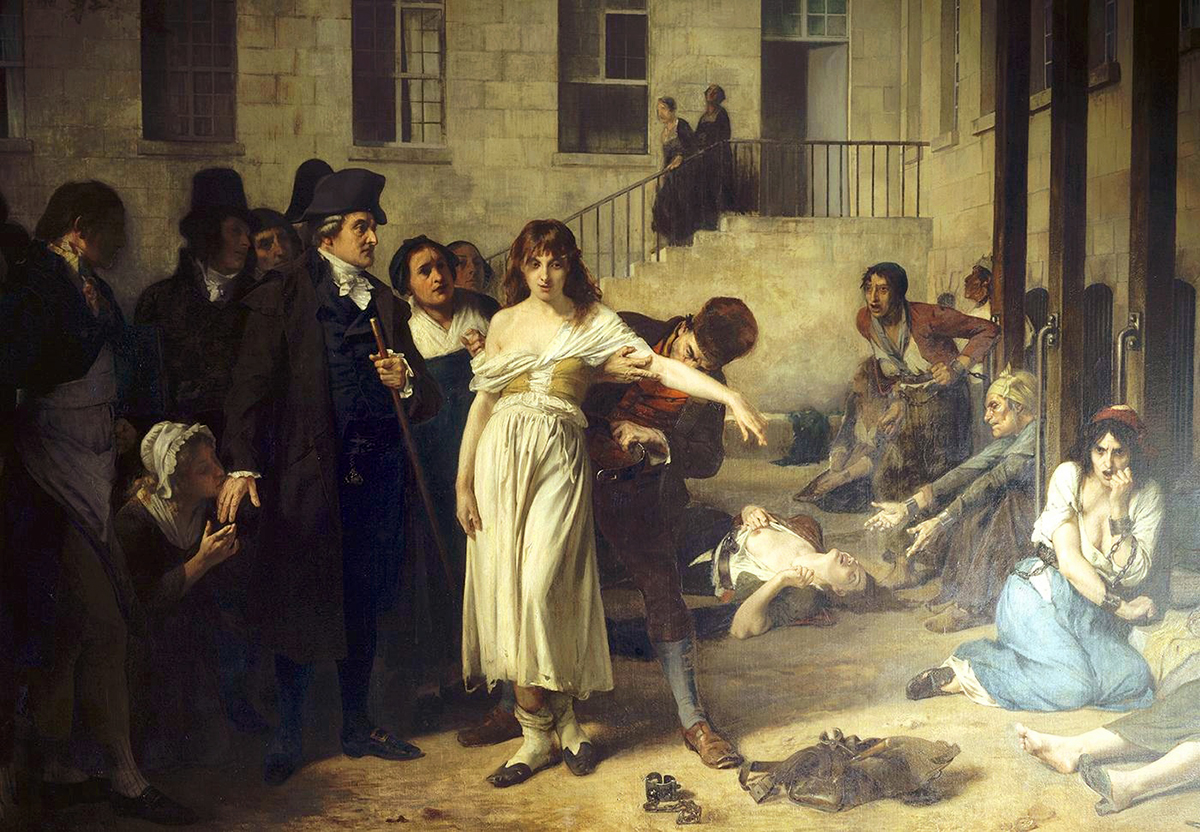
“Dr. Philippe Pinel at the Salpêtrière”, 1795 by Tony Robert-Fleury. Pinel ordering the removal of chains from patients at the Paris Asylum for insane women
Reforms in the treatment of the institutionalised insane were slowly introduced during the 19th century. In 1794, Philippe Pinel (1745 – 1826) was appointed the chief of hospitals for the insane in Paris, and managed to improve both the attitude toward and the treatment of the institutionalised insane. In the United States, Dorothea Dix (1802 – 1887) accomplished the most noticeable reforms in the treatment of the mentally ill. Beginning in 1841, Dix led a campaign to improve the condition of indigent, mentally ill persons kept in jails and in poorhouses. However, these reforms succeeded in improving only the physical surroundings and maintenance conditions of the mentally ill; legitimate treatment was minimal. [Even today, in 2019, the US seems to have more people with eccentric behaviours and with questionable mental stability, for example, Donald Trump, who has been singled out as being mentally ill by more than one. See: (1) The Dangerous Case of Donald Trump, (2) Trump Is ‘Mentally Ill’ Says Former Vermont Governor and Doctor Howard Dean, (3) American psycho? Donald Trump’s mental health is still a question, (4) Psychiatrist: Trump Mental Health Urgently Deteriorating & (5) Stanford’s Zimbardo asks: Is President Trump mentally ill?
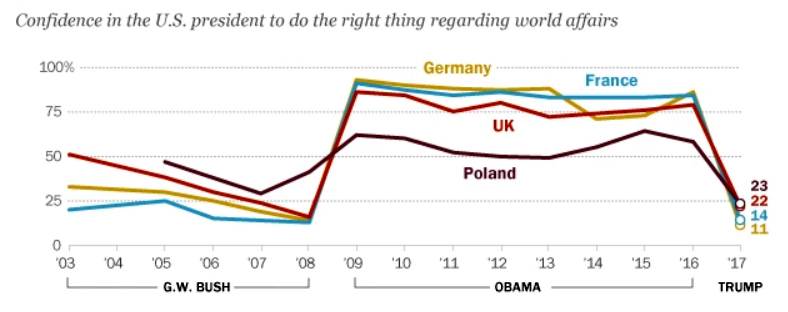
Around the world, favorability of the U.S. and confidence in its president decline / Source: Pew Research Center

According to the International Centre for Prison Studies, nearly a third of all female prisoners worldwide are incarcerated in the United States of America. There are 201,200 women in US prisons, representing 8.8 percent of the total American prison population. / Source: Forbes

Highest to Lowest – Prison Population Total / Source: World Prison Brief
Efforts to develop comprehensive treatments were plagued by various quacks, such as the pseudoscience developed by Mesmer that dealt with the “animal spirit” underlying mental illnesses [although it may be true today if expressed as a metaphorical description to some of the behavioural manifestations of some mental disorders in some individuals].

“White Dogs and Tootsie Pops” by Marie Hughes
Similarly, the phrenology of Gall and Spurzheim advocated a physical explanation based on skull contours and localisation of brain functions – which was of course also wrong.
Gradually however, attempts were made to develop legitimate and effective techniques to treat emotional and behavioural abnormalities. One of the more productive investigations involved hypnotism and was pioneered by a French physician, Jean Martin Charcot (1825 – 1893). Charcot gained widespread fame in Europe, and the young Freud amazed by his abilities, studied under him, as did many other talented physicians and physiologists. He treated hysterical patients with symptoms ranging from hyper-emotionality to physical conversions of underlying emotional problems that the patient could not confront when conscious.
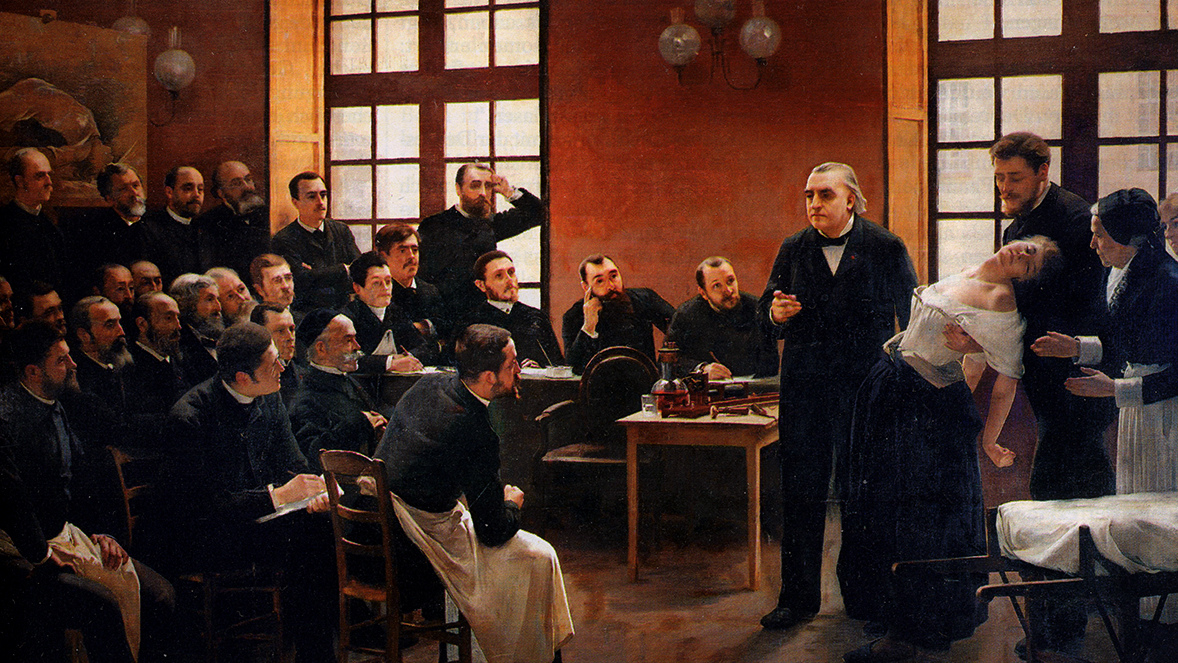
“Une leçon clinique à la Salpêtrière (1887)” with Jean Martin Charcot in Front (A Clinical Lesson at the Salpêtrière) par André Brouillet à l’Université Paris Descartes
Another French physician in Nancy, namely Hippolyte Bernheim (1837 – 1919), developed a sophisticated analysis of hypnosis as a form of treatment, using underlying suggestibility to alter the intentions of the patient. Finally, Pierre Janet (1859 – 1947), a student of Charcot, used hypnotism to resolve the forces of emotional conflict, which he believed were basic to hysterical symptoms. However, it was Sigmund Freud who went beyond the techniques of hypnotism to develop a comprehensive theory of psychopathology from which systematic treatments evolved. Later, Jacques Lacan (1901 – 1981) would pulverise the tradition inherited from hospital medecine which consisted of displaying a patient before an audience of practitioners or students and asking questions whose deeper meaning was supposed to escape the patient. The actors in this ceremonial, the patients, trained by years of confinement, actually produced all the symptoms that the masters of the asylum expected of them. Lacan shattered this clinic with his gaze in order to give a voice to the mentally ill. Jean-Bertrand Pontalis said: “Lacan était extraordinairement courtois avec ses malades, les traitant pas du tout comme des patients d’asile – c’est la moindre des choses, mais ce n’est pas toujours le cas – comme des êtres humains et les amenaient peu à peu, créant une atmosphère de confiance, à les laisser parler très très librement. Pour l’anecdote, c’est assez savoureux, je me souviens qu’une fois il y avait une femme qui était paranoïaque qui se plaignait qu’on l’a suivi partout, « On me suit, on me suit, on me suit, on me suit partout… », Lacan à la fin lui dit, « Ne vous inquiéter pas chère madame, je vais trouver quelqu’un pour vous suivre » entendant par la, un médecin qui pourra lui traiter. Comme si lui-même, dans ces années-là était en train d’inventer et de s’inventer. Nous participions en accord avec lui en résonance avec lui à un mouvement inventif.” [French for: “Lacan was extraordinarily courteous with his patients, treating them not at all like asylum patients – to say the least but this is not always the case – like human beings and gradually, creating an atmosphere of trust, he led them to let them speak very, very freely. For the anecdote, it’s quite tasty, I remember that once there was a woman who was paranoid complaining that she was followed everywhere, “They follow me, they follow me, they follow me, they follow me everywhere…”, Lacan at the end said to her, “Don’t worry dear lady, I’ll find someone to follow you” hearing by this, a doctor who will be able to treat her. As if he himself, in those years, was in the process of inventing and inventing himself. In agreement with him, we were participating in an inventive movement in resonance with him.”]
A Biography of Sigmund Freud
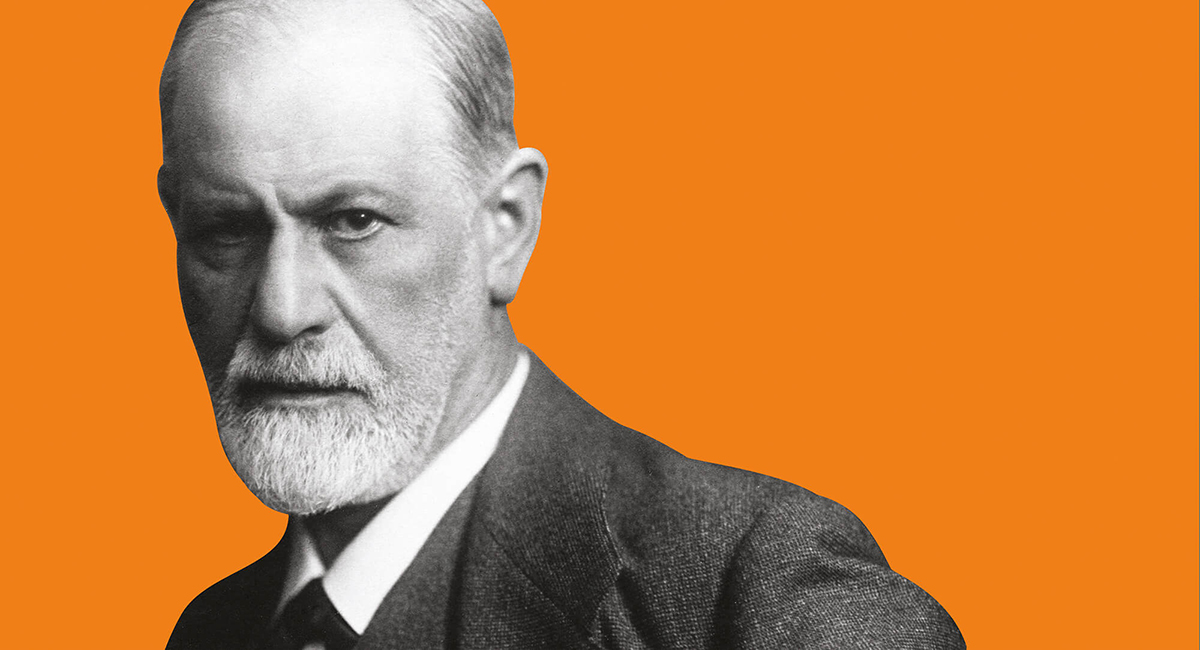
Sigmund Freud (1856 – 1939) / Image: Freud Museum London
Since psychoanalysis as we know it today is hugely influenced by the foundations laid by Sigmund Freud, it is worthwhile to have an understanding about the major points in his life. Sigmund Freud (1856 – 1939) was born on the 6th of May 1856 in Freiberg, Moravia, at that time a norther province of the Austro-Hungarian Empire, today a part of the Czech Republic.
Freud was the eldest of 8 children, and his father was a relatively poor and not very successful wool merchant. When his business failed, Freud’s father moved with his wife and children [as many jews are accustomed to migrating to better places in the quest for a better life and income] first to Leipzig and then to Vienna when Freud was 4 years old. The young Freud remained in Vienna for most of the rest of his life, and his precocious genius was recognised by his family, and he was allowed many concessions and favours not permitted to his siblings. For example, young Freud was provided with better lighting to read in the evening, and when he was studying, noise in the house was kept to a minimum so he would not be disturbed.
Freud’s interest were varied and intense, and he showed an early inclination and aptitude for various intellectual pursuits. Unfortunately, Freud was a victim of the 19th century Jew-dislike which was obvious and severe in central and Eastern Europe after the numerous accounts of Jews being banished from places all over Europe due to their occult and violent religious practices on Christian infants [e.g. human sacrifices] along with their known habits in monopolising the majority of the press businesses to then distort news and heritage to their agendas and economic advantage.
However, although Freud was an atheist and more scientifically minded, his Jewish birth precluded certain career opportunities, most notably an academic career in university research. Indeed, medicine and law were the only professions open to Vienna Jews.
Freud’s early reading of Charles Darwin intrigued and impressed him to the point that a career in science was most appealing. The closest path that he could follow for training as a researcher was an education in medicine. Hence, Freud entered the university of Vienna in 1873 at the age of 17. However, because of his interests in a variety of fields and specific research projects, it took him 8 years to complete the medical coursework that normally required 6 years.

In 1881, he received his doctorate in medicine. While at university, Freud was part of an investigation of the precise structure of the testes of eels, which involved his dissecting over 400 eels. Later, he moved on to physiology and neuroanatomy and conducted experiments examining the spinal cord of fish. While at Vienna, Freud also took courses with Franz Brentano, which formed his only formal introduction to 19th century psychology.
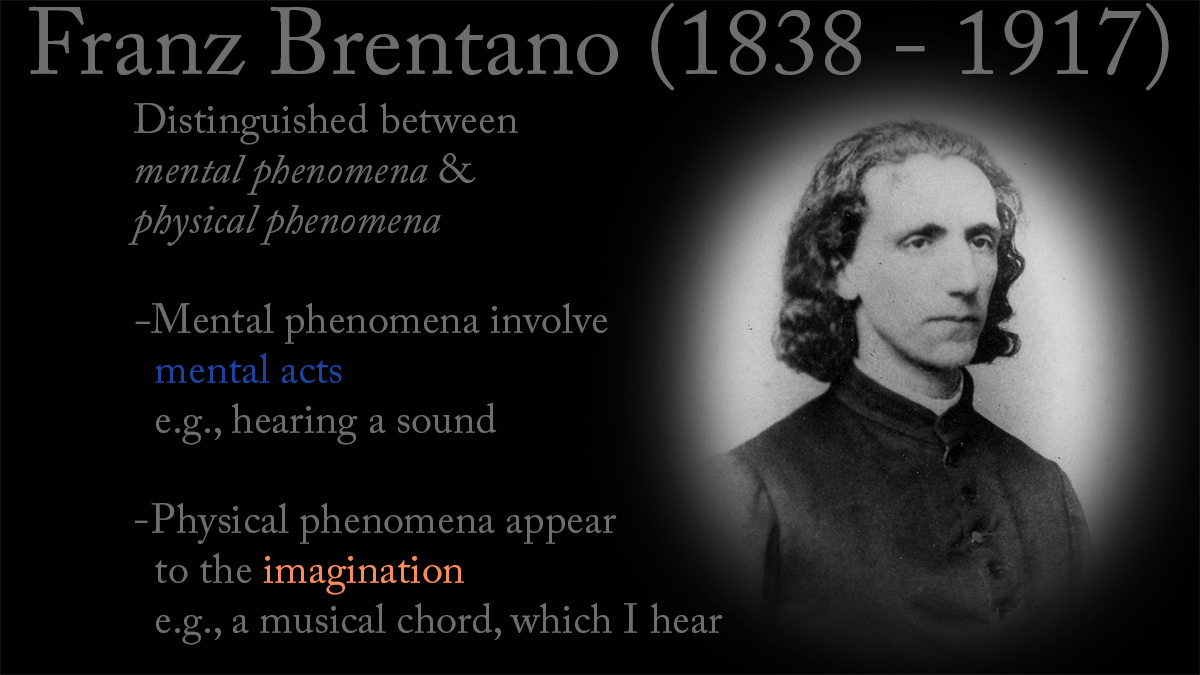
After waiting for Freud for about 4 years, his fiancée, Martha Bernays, a jewish girl from a business family and the grand-daughter of a famous Rabbi in Hamburg, married him. While she did not show great interest in Freud’s intellectual pursuits, her younger sister Minna became a very close intellectual partner of Freud. Carl Jung one of Freud’s intellectual ally who would become one of his firmest critic would even later say that he learned from Minna that Freud was in love with her and their relationship was very “intimate” – although we have no factual confirmation of such. She was so close to the young couple, that she moved in with them in the 1890s to set up was has been “jokingly” called a “ménage a trois”. As for Martha, she was also a charmer, intelligent, well-educated and fond of reading who as a married woman ran her household efficiently and was almost obsessive about punctuality and dirt. Firm but loving with her children, French analyst René Laforgue said that she spread an atmosphere of peaceful joie de vivre through the household. Shortly after Freud’s wedding, he recognised that a scientific career would not provide adequate income, since anti-Jewish sentiments were strong around Europe and this worked against Jewish advancement in academia even if Freud himself was not a practising Jew or had any religious sentiments. So Freud reluctantly decided to begin a private practice. Although the young couple were very poor in the early years of their marriage, Freud was able to support his wife and his growing family, which eventually included 6 children. The early years in private practice were very difficult, requiring long hours for a meagre financial reward that basically did not challenge him. Freud was also an atheist and did not want psychoanalysis to be seen as a purely Jewish endeavour, and his close network although were mainly Jewish later slowly grew to incorporate European intellectuals where some of the most significant would disagree with some of his assumptions and leave his circle after keeping only a few of his fundamental concepts about the theory of mental life.
During his hospital training, Freud had worked with patients with anatomical and organic problems of the nervous system. Shortly after starting private practice, he became friendly with Josef Breuer (1842 – 1925), a general practitioner who had acquired some local fame for his respiration studies. This friendship provided needed stimulation for Freud, and they began to collaborate on several patients with nervous disorders, most notably the famous case of Anna O., an intelligent young woman with severe, diffuse hysterical symptoms. In using hypnosis to treat Anna O., Breuer noticed that some specific experiences emerged under hypnosis that the patient could not recall while conscious. Her symptoms seemed to be relieved after talking about these experiences under hypnosis. Breuer treated Anna O. daily for over a year, and became convinced that the “talking cure”, or “catharsis”, involving discussion of unpleasant and repulsive memories revealed under hypnosis, was an effective method in alleviating her symptoms. Unfortunately, Breuer’s wife became jealous of the relationship; that would later be called “positive transference of emotional feelings to the therapist”. This would later be explained as patients falling in love with the new object [in this case, the psychoanalyst] at which they redirect feelings and desires retained in childhood at characteristic stages of therapy. This looked suspicious to Breuer’s wife. As a result, Breuer terminated his treatment of Anna O. Freud was also very professional with his clients and never had any mistresses or took advantage of his female patients. In opposition to positive transference, the psychoanalyst may also face negative transference in treatment with patients, which refers to aggressive affects, definitions that would also be taken by Lacan who criticised Ego-psychology for defining transference simply in terms of a range of affects. Lacan explained that transference does not refer to any mysterious property of affect in patients, and even when it reveals itself under the appearance of emotion, it only acquires meaning by the virtue of that very precise dialectical moment in which it is produced; that is to say that transference with patients often manifests itself in the form of strong affects, such as love and hate, but it does not consist of such emotions, it is part of the structure of the intersubjective relationship of patients in praxis with the psychoanalyst at that very moment. Lacan saw the Symbolic aspect of transference, which is repetition, as a feature that helped the treatment of patients since it reveals the meaningful signifiers of the personal history of Subjects, while the Imaginary aspect (love and hate) during treatment acts as resistance to psychoanalytic praxis.
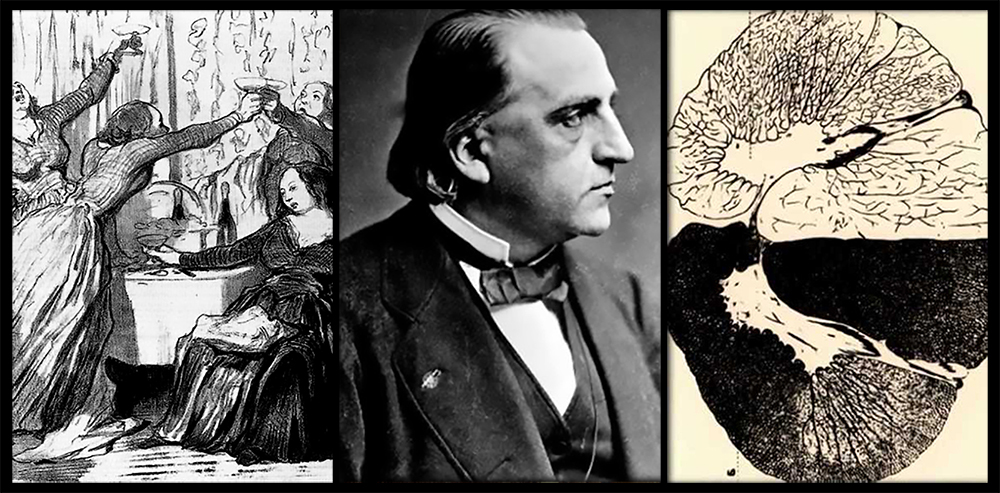
Jean-Martin Charcot (1825 – 1893) / Charcot first began studying hysteria after creating a special ward for non-insane females with “hystero-epilepsy”. He discovered two distinct forms of hysteria among these women: minor hysteria and major hysteria. His interest in hysteria and hypnotism “developed at a time when the general public was fascinated in ‘animal magnetism’ and ‘mesmerization'”, which was later revealed to be a method of inducing hypnosis.
Charcot argued vehemently against the widespread medical and popular prejudice that hysteria was rarely found in men, presenting several cases of traumatic male hysteria. He taught that due to this prejudice these “cases often went unrecognised, even by distinguished doctors” and could occur in such models of masculinity as railway engineers or soldiers. Charcot’s analysis, in particular his view of hysteria as an organic condition which could be caused by trauma, paved the way for understanding neurological symptoms arising from industrial-accident or war-related traumas.
In 1885, Freud received a modest grant that allowed him to go to Paris to study with Jean-Martin Charcot for 4 and half months. During that time he not only observed Charcot’s method of hypnosis [which he never managed to master as Charcot did] but also attended his lectures, learning about the master’s views on the importance of unresolved sexual problems in the underlying causality of hysteria. When Freud returned to Vienna, he gave a report of his work with Charcot to the medical society, but its cold reception left him with resentment that affected his future interactions with the entrenched medical establishment and its rigid and reductionist methods at understanding and solving the problems of the mind.
Freud continued his work with Breuer on hypnosis and catharsis, but gradually abandoned the former in favour of the latter, being not very gifted with hypnotic techniques, but also for 3 major reasons regarding its effectiveness as a treatment with general applicability. First, not everyone can be hypnotised; hence its usefulness is limited to a select group. Second, some patients refuse to believe what they revealed under hypnosis, prompting Freud to conclude that the patient must be aware during the step-by-step process of discovering memories hidden from their accessible consciousness. Third, when one set of symptoms were alleviated under hypnotic suggestibility, new symptoms often emerged. Freud and Breuer were moving in separate directions, and Freud’s increasing emphasis on the primacy of sexuality as the key to psychoneurosis contributed to their break. Nevertheless, in 1895 they published Studies on Hysteria, often cited as the first work of the psychoanalytic movement, although it sold only 626 copies during the following 13 years – perhaps due to the lack of sophistication and interest in the workings of the mind at that particular point in history, or the level of the academic discussions that may not have been adequate for the intellect of the average mind at the time.
Freud’s preferred method of treatment, catharsis, involves engaging with patients and encouraging them to speak of anything that comes [occupies] their mind, regardless of how discomforting or embarrassing it might be. This “free association” took place in a relaxed atmosphere, usually on the classic psychologist couch in a reclined position to promote comfort. The main reason behind the logic of catharsis and free association is that – like hypnosis – it would allow hidden thoughts and memories to manifest in consciousness. However, in contrast, to the method of hypnosis, the patient would be aware of these emerging recollections. Another ongoing process during free association is “transference”, which involves emotionally laden experiences that allow the patient to relieve earlier, repressed episodes. Since the psychoanalyst is often part of the transference process [as mentioned earlier where the repressed emotions are often redirected onto] and is often the object of his patients’ emotions, Freud recognised transference as a powerful tool to assist patients in resolving sources of anxiety. Lacan proposed that it is important to also understand that although the existence of transference plays an important part for psychoanalytic treatment, it is not enough by itself, it is also necessary for the psychoanalyst to deal with the transference in a unique way, this is what differentiates true psychoanalysis from suggestion because the psychoanalyst refuses to use the power given to him by the transference. Lacan believed like any other interpretation, the analyst must use all his “art” in deciding if and when to interpret the transference and must above all avoid gearing his interpretations exclusively to interpreting the transference; the analyst must know exactly what he wants to achieve by such an interpretation and it should not rectify his patients’ relationship to the vague concept of “reality”, but instead maintain analytic dialogue. Transference is the displacement of affect from one idea to another and Freud viewed it as a positive factor that helps the progression of treatment since it provides a way for patients’ history to be faced in the immediacy of the present relationship with the analyst; the way patients relate to the analyst is revealing as they inevitably repeat earlier relationships with other meaningful others [especially those with the parents or parental figures] – this logic is underlined in the theory of attachment of John Bowlby. Jacques Lacan later remarked that if transference with most patients often manifests itself under the appearance of love, it is first and foremost the love of knowledge (savoir) that is concerned. Transference is the attribution of knowledge to the Other, the assumption that the Other is a Subject who “knows” [Le Sujet supposé savoir], and as soon as that “knowing” Subject appears, we have transference. Lacan used Plato’s symposium to illustrate the relationship between analysands (i.e. patients) and the analyst; Alcibiades compared Socrates to a plain box which enclosed a precious object, just as Alcibiades attributes a hidden treasure to Socrates so patients see the object of their desire in the analyst (i.e. “objet petit a” in Lacanian terms). The psychoanalyst must sometimes situate himself/herself as the substitute for objet petit a in the course of psychoanalytic praxis. Lacan also identifies the compulsion to repeat with the symbolic nature of transference, the symbolic determinants of all Subjects, and this helps the progression of treatment by revealing the meaningful signifiers of Subjects’ personal history; he also locates the essence of transference in the Symbolic and not in the Imaginary, although it clearly has powerful imaginary effects.
In 1897, Freud began a self-analysis of his dreams, which evolved into another technique important to the psychoanalytic movement. In the analysis of dreams, Freud distinguish between the manifest content [the actual depiction of the dreams] and the latent content, which represented the symbolic world of the patient. In 1900, he published his major work, The Interpretation of Dreams. Although it sold only 600 copies in eight years, it later went through eight editions in his lifetime. In 1901, he published The Psychopathology of Everyday Life, the book in which his theory began to take shape. Freud argued that the psychology of all people, not only those with neurotic symptoms, could be understood in terms of the unconscious forces in need of resolution.
When his reputation as a pioneer in psychiatry started to grow due to his prolific writings, Freud attracted admiring followers, among them was the notable Carl Jung. In 1909, G. Stanley Hall, president of Clark University, invited him to the United States to give a lecture series as part of that institution’s 20th anniversary. The lectures were published in the American Journal of Psychology and later in book form, serving as an appropriate introduction to psychoanalytic thought for American audiences.
As psychoanalysis was perceived as radical by the medical establishment, early believers form their own associations and found the journals to disseminate their competing views. However, Freud’s demand for strict loyalty to his interpretation of psychoanalysis led to some discord within the movement [perhaps for the betterment of the field itself as many branches kept the fundamental concept of unconscious (Id), pre-conscious (SuperEgo), and conscious (Ego) but fused other theoretical and scientific perspectives to explain and treat a range of mental illnesses]. Carl Jung broke away in 1914, so that by the following year, three rival groups existed within the psychoanalysic movement. Nevertheless, Freud’s views continued to evolve. Impressed by the devastation and tragedy of World War I, Freud came to view aggression, along with sexuality, as a primal instinctual motivation. During the 1920s Freud expanded psychoanalysis from a method of treatment for mentally ill or emotionally disturbed persons to a systematic framework for all human motivation and personality.
In 1923, Freud developed cancer of the jaw and experienced almost constant pain for the remaining 16 years of his life. He underwent 33 operations and had to wear a prosthetic device. Throughout this ordeal however, he continued to write and see patients, although he shunned public appearances. With the rise of Hitler and the anti-Jewish sentiments that arose with his campaigns with the National Socialists, Freud’s works were unfortunately singled out as they were not seen as a scientific endeavour but rather as a Jewish science, and his books were burned throughout Germany. However, Freud resisted fleeing from Vienna. When Germany and Austria were politically united in 1938, the Gestapo began harassing Freud and his family. President Roosevelt indirectly relayed to the German government that Freud is an intellectual who must be protected. Nevertheless, in March 1938 some thugs invaded Freud’s home. Finally, through the efforts of friends, Freud was granted special permission, but only after promising to send for his unsold books in Swiss storage so that they could be destroyed. After he signed a statement saying that he had received good treatment from the police, the German government allowed him to leave for England, where he died shortly after, on September 23, 1939.
An overview of the Psychoanalytic System based on Freud’s Research
Before our in-depth examination of psychoanalytic theory, it is important to recognise that the theory has an unusually broad focus. Psychoanalysis contains a theory of personality, but it also offers theoretical tools for understanding culture, society, art and literature. It is also a clinical theory that aspires to explain the nature and origins of mental disorders, and that is associated with an approach to their treatment. To give some more sense to Freud’s breadth, consider that he wrote on topics as diverse as the meaning of dreams and jokes, the origins of religion, Shakespeare’s plays, the psychology of groups, homosexuality, the causes of phobias and obsessions, and much more besides. Even as a theory of personality, psychoanalysis is primarily an account of the processes and mechanisms of the mind, rather than an account of individual differences.
In addition to its breadth of focus, the psychoanalytic theory has many distinct components that have also been modified and explored by a range of skilled psychoanalysts, making it hard to integrate into a single unitary model of the mind since they are inter-connected in complex ways.
Freud’s views evolved continually throughout his long career in the collective result of his extensive writings as an elaborate system of personality development. Personality was described in terms of an energy system that seeks an equilibrium of forces. This homeostatic model of human personality was determined by the constant attempt to identify appropriate ways to discharge instinctual energies, which originate in the depths of the unconscious. The structure of personality, according to the psychoanalytic model consists of a dynamic interchange of activities energised by forces that are present in the person at birth. This homeostatic model was consistent with the prevailing views of 19th-century science, which saw the mechanical relations of physical events studied by physics as the term of scientific inquiry. Freud’s model for psychoanalysis translated physical stimuli to psychic energies or forces and retained an essentially mechanical description of how such forces interact.
As the writings on the dpurb.com website are the foundations for the Organic Theory of Psychological Construction, we are going to be focused not on the later structural model which repositioned the Unconscious, Conscious and Pre-Conscious across the Id, Ego and SuperEgo, but with the first topographic model (1900 – 1905) adopted by both Carl Jung and Jacques Lacan. This model, has been more influential and is more flexible in accommodating competing view points about the structure of mental life across individuals.
The topographic model refers to the levels or layers of mental life. Freud proposed that mental content – ideas, wishes, emotions, impulses, memories, and so on – can be located at one of the three levels: the Conscious (later known as the Ego), the Preconscious (SuperEgo) and the Unconscious (Id), . It is important however, to understand that Freud use these terms to describe degrees of awareness and unawareness, but also to refer to distinct mental systems with their own distinct laws of operation. Unconscious cognition is categorically different from Conscious cognition, in addition to operating on mental content that exists beneath awareness. To convey this point, the three levels of the topographic model was referred to as the ‘systems’ Cs., Pcs., and Ucs.

The Topographic Model
The Conscious (which would later be known as Ego with a partial unconscious side, and also “Le Moi” in Lacanian Theory)
Consciousness is merely the proverbial ‘tip of the iceberg’ of mental activity. The contents of the Conscious are simply the small fraction of things that the person is currently paying attention to: objects perceived, events recalled, the stream of thought that we engage in as a running commentary on everyday life. [This is the main focus of most other branches of Psychology such as Biological Psychology and Cognitive Psychology]
The Preconscious (which would later be known as the Super-Ego, le “Grand Autre” in Lacanian Theory)
Of course, not all of all mental life happens under the spotlight of awareness and attention. There are many things to which we could readily pay attention to but do not, such as ideas or plans we have set aside or memories of what we were doing last week or yesterday. Without any great effort these things or events, which in the present are out of consciousness, can be made conscious. Those form the domain of the Preconscious.
The boundary between the Conscious (Ego) and the Preconscious (Super-Ego) is a permeable one. Thoughts, memories and perceptions can cross without great difficulty according to the momentary needs and intentions of the individual. They also share a common mode of cognition, which in psychoanalysis is known as the ‘secondary process’. Secondary process cognition is the sort of everyday, more or less rational thinking than generally obeys the laws of logic.
The Unconscious (which would later be known as the Id, L’inconscient or the “Ça” in Lacanian Theory)
The Unconscious (Id) is perhaps one of the most celebrated theoretical concepts in psychoanalysis’ legacy. However, Freud did not invent or discover the unconscious as is sometimes claimed – versions of the unconscious had been floating around intellectual circles for some time – but Freud gave it a much deeper theoretical analysis than anyone before him. Freud distinguished between mental contents and processes that are descriptively unconscious and those that are dynamically unconscious. The descriptively unconscious simply exists outside consciousness as a matter of fact, and therefore include Preconscious material that can become conscious if it is attended to. Freud’s crucial contribution was to argue that some thoughts, memories, wishes and mental processes are not only descriptively unconscious, but also cannot be made conscious because of a countervailing force keeps them out of awareness. In short, mental life that is dynamically unconscious is a subset of what is descriptively unconscious, one whose entry to consciousness is actively thwarted. The Freudian unconscious corresponds to the dynamic unconscious in this sense.
Freud held that the Unconscious contains a large but unacknowledged proportion of mental life that operates according to its own psychological laws. The barrier between the Unconscious (Id) and the Preconscious (SuperEgo) is much more fortified and difficult to penetrate than the border between the Preconscious (Super-Ego) and Conscious (Ego). In addition, it is policed by a mental function that Freud likened to a “censor”. The censor’s role is to determine whether the contents of the Unconscious would be threatening / objectionable or socially unacceptable to the person if they became conscious. If the censor judges them to be dangerous in this type, the person will experience anxiety without knowing what caused it. In this case, these thoughts become wishes and so on, and will be normally be repelled back into the Unconscious, in a process referred to as “Repression” [it is fundamental and very important to understand that Repression is something else than a conscious judgement which rejects and chooses]. Unconscious material, by Freud’s account, has an intrinsic force propelling it to become conscious. Consequently, repression required an active opposing force to resist it, just as effort is required to prevent a surf board made of white foam to rise to the surface when it is submerged in the ocean. Under the constant pressure of Unconscious material bubbling towards the Preconscious, the censor cannot possibly bar entry to everything. Instead, it allows some Unconscious material to cross over the barrier after it has been transformed or disguised in some way so as to be less objectionable and more socially acceptable. This crossing might take the form of a relatively harmless impulsive behaviour, or in the form of private fantasy, the telling of a joke, or in a slip of the tongue, where the person says something ‘unintentionally’ that reveals to the trained eye and mind the repressed concerns and wishes [such as that of a psychoanalyst – as Jacques Lacan proposed: repression can take the form of a metaphor and the skilled psychoanalyst must be able to decipher a chain of clues with a great deal of verbal dexterity where crossword puzzles may help in training. Lacan also viewed the Grand Autre (Preconscious/Superego) as the discourse of the Unconscious]. Psychoanalysis focuses on how phenomena such as these can be interpreted, the process that involves uncovering the unconscious material that is concealed within their “disguises” [i.e. forms].
To Freud, dreams represent a particularly good example of the disguised expression of the Unconscious wishes. They offered, he wrote, “the royal road to the Unconscious”. One reason for this is that during sleep, the sensor relaxes and allows more repressed Unconscious material to cross the barrier. This material, transformed into a less threatening form by a process referred to as the “dream-work”, then takes the shape of a train of images in the peculiar form of consciousness that we call dreaming. It is believed, that each dream has a “latent content” of Unconscious wishes that is transformed into the “manifest content” (or dream narrative) of the experienced dream. In psychoanalytic praxis with patients, the interpretations of dreams takes the same road, but in reverse, in order to decode the transformations rendered by the dream work so as to bring out the latent content based on the manifest content. Freud described the “latent contents” as made up of “latent thoughts“, a term that was always used in the plural form and never precisely described, but the context of its usage seems to suggest that it connoted representations, affects, wishes and conflictual patterns that are all profoundly marked by infantilism and fantasy [e.g. having super powers and flying while dressed in a nylon costume]. Latent thoughts also contain whatever supplies the dream’s “raw material”: the days residues, somatic sensations, and excitations that directly impact instinctual impulses. The transformation carried out by the dream work has to allow the Unconscious wishes during the wake state to be fulfilled during the dream while concealing the elements of threat they contain. If the latent content is not concealed sufficiently through the “dream-work” process, the sleeper will register the threat and be awoken [sometimes in shock and sweat], and to avoid this shock the dream-work may alter the identities of the people represented in a wish, for example, if an individual has an Unconscious wish to harm a loved one, the dream work might produce a dream in which the individual instead harms someone else or in which the loved one is harmed by another person, neutralised in this way, the unconscious wishes find conscious expression in the dream. Freud explained that “latent thoughts” were generally preconscious; they are used by the dream work because they are a relay point and medium for unconscious cathexes [i.e. objects (or ideas) that have a quantity of psychical energy attached to them; to say that an object or idea is “libidinally” cathected means that it is charged with sexual energy deriving from sources internal to a patient’s psyche; the Id (Unconscious) or the instinctual pole of personality is said to be be the source all types of cathexes]. Dreams also showcase the distinct form of thinking that operates in the Unconscious: “Primary process” thinking, which unlike the secondary process than governs the Conscious (Ego) and Preconscious (Super-Ego), shows no respect for the laws of logic and rationality. In primary process thinking, something can stand for something else, including its opposite, and can even represent two distinct things at once. Contradictory thoughts can coexist and there is no orderly sense of the passage of time or of causation. Basically, primary process thinking captures the magical, chaotic qualities of many dreams, the mysterious images that seems somehow significant, the fractured storylines, the impossible and disconnected events. To Freud, dreams are not simply night-time curiosities, but reveal how the greater part of our mental life proceeds beneath the shallows of conscience.
Foundations of the later “Structural” model: concepts to consider and synthesise with the Topographic Model
We are now going to have a look at the later version of Freud’s psychoanalytic theory where the Unconscious [this time referred to as the Id] is still the fundamental concept, however decades later in 1923, another 3-way dissection of the mind was proposed. This time Freud called it the Psychic Apparatus and the 3-way dissection of the mind was defined in terms of distinct mental functions instead of levels of awareness and their associated processes.
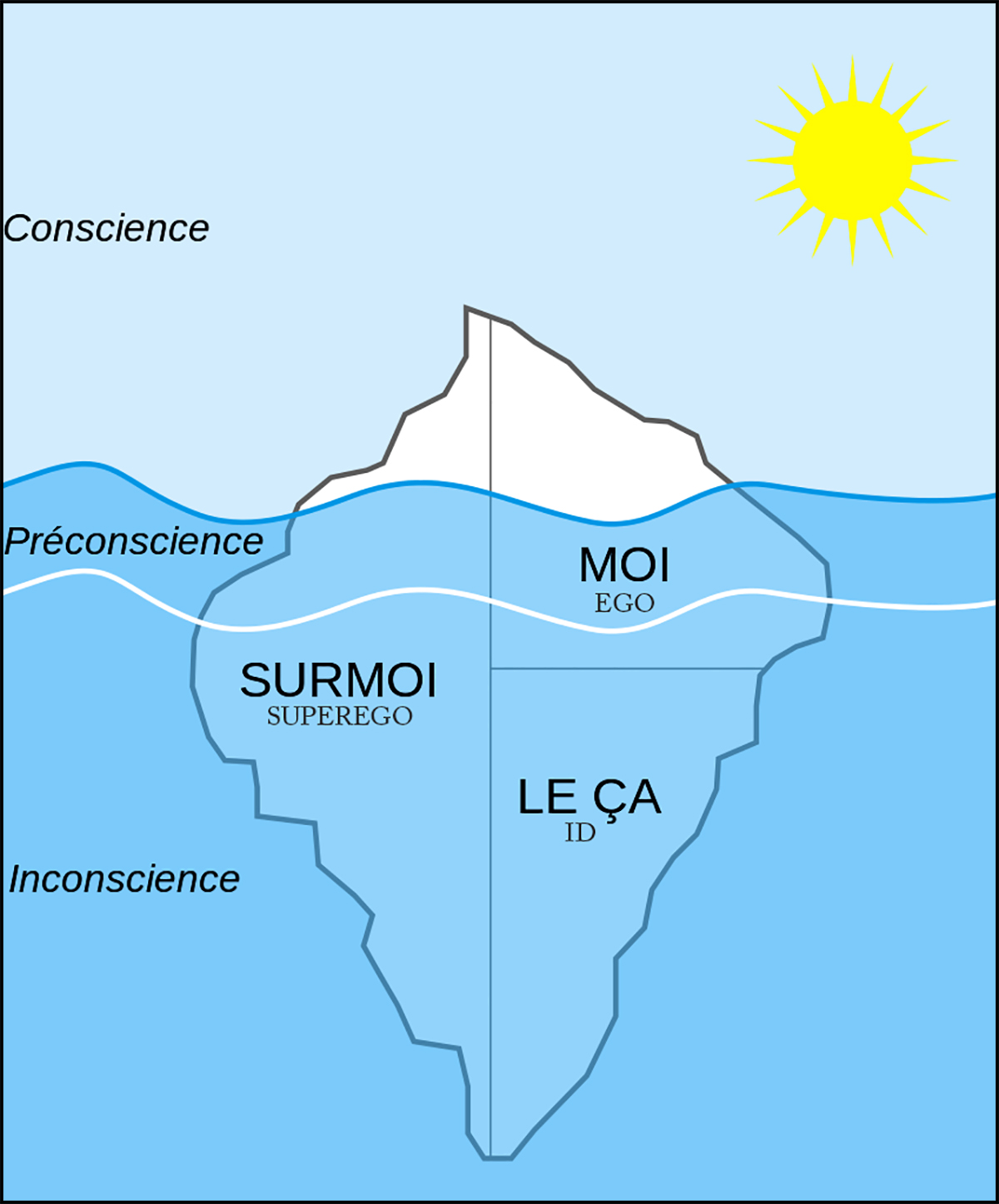
The Structural Model of the Psychic apparatus
In original German, the terms Es (Id), das Ich (Ego) and Über-ich (Super-Ego) were used. As we take a look at these structures, it is important to remember that they were not proposed as real underlying entities, but rather as a sort of conceptual shorthand for talking about different kinds of mental processes. Our aim here is to synthesise the logical concepts of the Structural Model with the earlier Topographic Model of the Unconscious (Id), the Preconscious (Super-Ego) and the Conscious (Ego), however although it is convenient to talk about the Id, Super-Ego and Ego “doing” such-and-such or being “in charge of” so-and so, it is important to remember that they were not intended to refer to distinct sub-personalities within the individual.
The Id (Unconscious, das Es / Inconscient / Le Ça)
The Id [completely/dynamically unconscious] represents the part of the personality that is closely linked to the instinctual drives that are the fundamental sources of motivation in Freudian theory. According to Freud, these drives are chiefly sexual and aggressive in nature. On one hand we have the “life instincts” concerned with preserving life and binding together new “vital unities”, the foremost expression of this concern being loving sexual union. Opposed to these life instincts, on the other side, we have the set of “death instincts”, whose corresponding concern is with breaking down life and destroying connections, its goal is a state of entropy or nirvana, where there is a complete absence of any form of tension [motivation] – the most obvious form of these instincts were aggressiveness expressed inward towards the self or outward towards others. Freud proposed that these instinctual biological drives were powered by a reservoir of instinctual “psychic energy” grounded in basic biological processes; the sexual form of this energy was referred to as libido. Although the unconscious Id is a biological underpinning, its contents are manifested in psychological phenomena such as wishes, ideas, intentions, and impulses. These phenomena are therefore sometimes described as “instinct- derivatives”. Some of these phenomena are innate, whereas others have been consigned to the Id by the process of repression. All of the Id’s contents, however are unconscious. Freud proposed that the Id operated according to what he called the “pleasure principle” which states that the Id’s urges strive to obtain pleasure and avoid “unpleasure” without delay. Unpleasure results from increased accumulated excitation and pleasure results from its reduction. Lacan used the term “Jouissance” to describe an excessive quantity of excitation that has the potential to take the Subject to that extreme point where the erotic borders upon death and where subjectivity risks extinction; the “pleasure principle” tries to prevent such savage scenarios [To Lacan, the pleasure principle is a commandment — which can be phrased — “Enjoy as little as possible.” The pleasure principle leads the subject from signifier to signifier, by generating as many signifiers as are required to maintain at as low a level as possible the tension that regulates the whole functioning of the psychic apparatus]. One of Lacan’s contribution to the debate on feminity advances the concept of a specifically feminine jouissance which goes beyond the phallus: a jouissance of the order of the infinite like mystical ecstacy where women may experience this without being conscious about it. Therefore the pleasure principle serves to reduce tension and to return the psyche to a state of equilibrium or constancy. Pleasure, in Freud’s understanding, represented a discharge of libido or instinctual energy which is accompanied by a release of tension. The Id is not in contact with the rules or structures of individuals’ environment [i.e. the Symbolic rules of civilised society], but rather relates to the other structures of personality, the Ego & the Superego [conscience] that in turn must mediate between the Id’s raw instincts and the external world; immune from reality and social convention, the Id which is guided by the pleasure principle, seeks to gratify instinctual libidinal needs [that are simply biological] either directly through a sexual experience, or indirectly by dreaming or fantasizing. The latter, indirect gratification was called the primary process [governed by the pleasure principle] and has its own “rules” [e.g. allowing contradictions in logic] that differ from Ego functions and conscious thought. The exact object of direct gratification in the pleasure principle is assumed to be determined by the psychosexual stage of the individual’s development [as explained in 3rd part of the essay on The 3 Major Theories of Development], however the legitimacy and precision of this theory has been questioned and revised over the years and it gave way to the more empirical Theory of Attachment of John Bowlby. In short, the Id strives to satisfy its drives enabling immediate, pleasurable release of instinctual energy. It is the most primitive and least accessible structure of personality. As originally described by Freud, the Id is psychic energy of an irrational nature, and in the form of libido, it can manifest itself and be of a sexual character that is incestuous, uninhibited, savage, irrational and boundless, which instinctually determines unconscious processes. In psychoanalysis, this natural, wild and irrational urge is assumed to be present in all human beings. Elisabeth Roudinesco pointed out that Freud had distinguished that in humans it is the desire for incest and not the horror of it, that eventually leads individuals to forbid themselves from expressing it while also rejecting it; that is to say that in healthy, civilised and psychologically stable individuals with a well developed conscience [i.e. Superego] there is a respect for the symbolic laws that govern human relationships ethically [Lacan proposed that these symbolic structures are primarily governed by language] and which involve abiding by a structure that respects shared social values that sustain a functional human civilisation, i.e. the passage from raw and savage nature [Id] to civilised culture [Super Ego]. Many modern psychoanalysts believe that repression, masturbation and sublimation are inescapable in order to manage the raw and wild instincts of the Id and to channel them in more productive endeavours that are in the best interests of individuals and civilised society.
The Ego (Conscious & partially unconscious, Ich / Le Moi)
The Ego, is a mental function and complicates the picture of immediate gratification that the Id strives for. The Ego, a “psychic agency”, arises over the course of development as the child learns that it is often necessary and desirable to delay gratification. The bottle or breast does not always appear the instant that hunger is first experienced, and sometimes it is better to resist the urge to urinate at the bladder’s first bidding if one is to avoid the unpleasure of wet pants, embarrassment, and a parent’s howls of dismay. The Ego, often called the “executive” of personality because of its role in channeling Id [unconscious] energies into socially acceptable outlets [ego is believed to start developing between the ages of 1 and 2 as the child confronts the environment]. The Ego crystallises out this emerging capacity for delay, and in time becomes a restraint on the Id’s impatient striving for discharge. However, it cannot be an inflexible restraint. Its task is not to delay the fulfilment of wishes and impulses endlessly, but to determine when and how it would be most sensible or prudent to do so given the demands of the external environment at a particular time. It operates, that is, on the “Reality principle”, which simply requires that the Ego regulate the person’s behaviour in accordance with external conditions [at a given time or place according to certain rules or laws or conventions, and of course this changes as society redefines “reality” in terms of what it acceptable and not]. Freud emphasized that the Ego is not the dominant force in the personality [unlike Ego psychologists in the US state], although he believed it should strive to be. A famous statement of Freud regarding the goal of Psychoanalytic treatment is “Where Id was, there Ego shall be”. By his account, the Ego not only emerges out of the Id in the course of development – beforehand, the infant is pure Id [instinctive and irrational] – but it also derives all of its energy from the Id. Freud had a gift for metaphor, and he likened the Ego’s relation to the Id as a rider’s relation to a wilful horse. The horse [Id] supplies all of the pair’s force, but the rider [Ego] may be able to channel it in a particular direction. Fortunately, this “rider” [Ego] has a repertoire of skills at its disposal. Freud proposed that the Ego could employ a variety of “defence mechanism” in the service of the reality principle. These mechanisms come in a diverse range, and all represent operations that the Ego performs to deal with the threats to the rational expression of the person’s desires, whether from the Super-Ego or the external environment. These Ego defence mechanisms are common processes in everyday mental life, and many of them are carried out by the Ego unconsciously, showing that there is an unconscious part in the Ego. The Ego being governed by the reality principle, is aware of environmental demands and adjusts behaviour so that the instinctual pressures of the id are satisfied in acceptable ways, and the attainment of specific objects to reduce libidinal energy in socially appropriate ways was called the “secondary process” [the “primary process” being the Unconscious (Id)]. Some of the most well known defence mechanisms are denial, isolation of affect, projection, reaction formation, repression and sublimation.
The Super-Ego (Conscious & partially unconscious, Über-ich / Le Surmoi / L’Autre / Le Grand-Autre)
The differentiation of the structures of personality, called the Super-Ego, is believed to start appearing by the age of 5. In contrast to the Id and Ego, which are internal developments of personality, the Super-Ego is an external imposition. That is the Super-Ego is the incorporation of moral standards perceived by the Ego from some agent of authority in the environment, usually an assimilation of the parents’ views as the child develops – both positive and negative aspects of these standards. The Super-Ego’s emergence complicates the task of the Ego in regulating the expression of the Id’s impulses in response to demands and opportunities of the external environment. The Super-Ego represents an early form of conscience, an internalised set of moral values, standards, and ideals. These moral precepts are not the sort of flexible, evolving, reasoned, and discussable rules of conduct that we tend to imagine when we think of adult morality, however, instead they tend to be relatively harsh, absolute and punishing; adult morality as refracted through the immature and fearful mind of a child. The Super-Ego therefore represents the shrill voice of societal rules and restrictions, a voice that condemns and forbids many of the sexual and destructive wishes, impulses and thoughts that emerge from the Id. The positive moral code is the Ego ideal, i.e. a representation of behaviour for the individual to emulate. The conscience embodies the negative aspect of the Super-Ego, and determines which activities are to be taboo. Conduct that violates the dictates of the conscience produces “guilt” in healthy individuals. Hence, the Super-Ego and the Id are in direct conflict, leaving the Ego to mediate. The Ego now becomes the servant of three masters: the Id, the Super-Ego and the External Environment [Societal Rules]. It is now not enough to reconcile what is desired with what is possible under the circumstances because now the Ego also needs to take into consideration what is socially prohibited and impermissible. Instinctual drives must still be satisfied; which is a constant, however the Ego now attempts to satisfy them in a way that is flexibly “realistic” – that is, in the person’s best interests under current conditions – but also “socially” permitted. These prohibitions are often very unreasonable and inflexible, rejecting any expression of the drive with an unconditional “NO”, either because the moral structures of a particular “culture” are intrinsically rigid, atavistic or unsophisticated, or because the individual’s internalisation of these structures is simply black-and-white, without any grey area to compromise for an adequate and acceptable form of expression of the drive. Thus, the Super-Ego imposes a pattern of conduct that results in some degree of self-control through an internalised system of rewards and punishments.
Given the demands that it faces, the Ego can either find a way to express the Id’s desires successfully, or its attempts to arbitrate can fail. In this case, psychological trouble is likely to follow. If the Id wins the struggle, and the desire finds expression in a more-or-less unaltered and primitive form, the person may experience guilt or shame: the Super-Ego’s sign that it has been violated, and may also have to pay the price of a short-sighted, impulsive action. If on the other hand, the Super-Ego wins the struggle and dominates a person excessively, that individual may become overly rigid, rule-bound, uncreative, unquestioning, anxious and joyless. The forbidden desires may well go “underground” and manifest themselves in symptoms such as anxieties, compulsions or in occasional “out-of-character” impulsive behaviour or emotion.
Intrapsychic Conflict: the Roots of Personality
The major motivational constructs of Freud’s theory of personality was derived from instincts, defined as biological forces that release mental energy. Hence, from the account of the Unconscious (Id), the Conscious [and partly unconscious, Ego) and the Preconscious (Super-Ego), it implies that conflict within the mind’s opposing forces is inevitable, because the demands of society – or “civilisation” – are generally opposed to the natural instincts and drives of human beings. Indeed, intrapsychic conflict is one of the fundamental and defining concepts of psychoanalysis. Conflict within the mind is at the root of personality structure, mental disorder, and most psychological phenomena [e.g. artistic expressions of various forms]. The goal of personality is to reduce the energy drive through some activity acceptable to the constraints of the Super-Ego [Preconscious].
Freud classed inborn instincts to life (eros) and death (thanatos) drives. Life instincts involve self-preservation and include hunger, sex and thirst. The libido is that specific form of energy through which life instincts arise in the Id. The death instinct (Thanatos) may be directed either inwards, as in suicide or masochism, or outwards, as in hate and aggression. The notion that personality equilibrium must be maintained by discharging energy in acceptable ways, leads to anxiety which plays a central role. Essentially the view is that anxiety is a diffuse fear in anticipation of unmet desires and future evils. Given the primitive character of Unconscious (Id) instincts, it is unlikely that primary goals are ever an acceptable means of drive reduction; rather they are apt to give rise to continual anxiety in personality. Freud described three general forms of anxiety.
(i) Reality (or Objective) Anxiety
(ii) Neurotic Anxiety
(iii) Moral Anxiety
Reality or objective anxiety, is a fear of the real environmental danger [e.g. heights, depth, fire, etc] with an obvious cause; such fear is appropriate as it has survival value for the organism. Neurotic anxiety comes about from the fear of potential punishment inherent in the goal of instinctual gratification. It is a fear of punishment for expressing impulsive desires. Finally, moral anxiety is the fear of the conscience through guilt or shame in healthy individuals. In order to cope with anxiety, the Ego develops defence mechanisms, which are elaborate, largely unconscious processes that allow a person to avoid unpleasantness and anxiety-provoking events. For example, an individual may avoid facing anxiety by self-denial, conversion [whereby the anxiety caused by repressed impulses and feelings are ‘converted’ into a physical complaint such as a cough or feelings of paralysis], or projection, or may repress thoughts that are a source of anxiety into the unconscious. Many defence mechanisms are described in the psychoanalytic literature, which generally agrees that although defence mechanisms are typical ways of handling anxiety and maintaining a sense of psychological stability, they must be recognised and controlled by the individual himself/herself for psychological health. Lacan sees “defence” as being on the side of the Subject [being stable symbolic structures of subjectivity].
Denial |
Refusing to acknowledge that some unpleasant or threatening event has occurred; common in grief reactions |
Isolation of Affect |
Mentally severing an idea from its threatening emotional associations so that it can be held without experiencing its unpleasantness; common in obsessional people |
Projection |
Disavowing one’s impulses thoughts and attributing them to another person; common in paranoia |
Reaction formation |
Unconsciously developing wishes or thoughts that are opposite to those that one finds undesirable in oneself; common in people with a rigid moral code |
Repression |
Repression is one of the most basic concepts in psychoanalysis. It involves repelling threatening thoughts from consciousness, to confine them in the unconscious. Freud distinguished between: (i) primal repression [a “mythical” forgetting of something that was never conscious, an ordinary “psychical act” by which the unconscious is first constituted. Lacan saw this as a structural feature of language, its necessary incompleteness, the impossibility of ever formulating the “truth about truth” (because human language is limited and can never capture and completely express the Unconscious), the symbolic signifying chain of the unconscious where linguistic discourse originates]; and (ii) secondary repression [concrete acts of repression whereby some idea or perception that was once conscious is expelled from the conscious (E.g. motivated forgetting; common in post-traumatic reactions). Lacan saw secondary repression as a specific psychical act by which a signifier is elided from the signifying chain, it is structured like a metaphor and involves the return of the repressed, since repression does not destroy the ideas or memories but merely confines them to the unconscious, the repressed material is liable to return in distorted form, in symptoms, dreams, slips of the tongue, etc. To Lacan, it is always the signifier that is repressed, never the signified, which corresponds to Freud’s view that what is repressed is not the “affect” (which can only be displaced or transformed) but the “ideational representative” of the drive. Lacan proposed that repression is what distinguishes neurosis from other clinical structures – psychotics foreclose, perverts disavow and only neurotics repress] Lacan maintained that it is very important not to confuse repression with the conscious judgement of a Subject that rejects and chooses. |
Sublimation |
The concept of Sublimation was first introduced by Freud in 1905 in his essays on Sexual theory. Sublimation is the act of unconsciously deflecting raw, irrational and uninhibited sexual and aggressive impulses/drives towards different, socially acceptable expressions and human activity [e.g. artistic creations, sports and intellectual work] that has no connection to sexuality but gets its power from the psychic energy in the sexual drive [la pulsion sexuelle]. Sublimation thus works as a socially acceptable escape valve for excess libidinal (sexual) energy which would otherwise have to be discharged in socially unacceptable forms [e.g. perverse behaviour] or in neurotic symptoms. This means that complete sublimation would spell the end of all perversion and neurosis. While Freud believed complete sublimation might be possible for some particularly refined or cultured people, Lacan pointed out that absolute/complete sublimation is not possible for human beings, [since all healthy humans with a healthy brain, a functional hypothalamus and sexual organs will experience sexual urges and feelings] and that perverse sexuality to satisfy the drive is possible and accessible (e.g. prostitution, perverse behaviour, private fantasies, etc) but must be sublimated because it is prohibited or badly viewed by civilised society and is also not in the individual’s best interests. Lacan follows Freud in emphasising the fact that the element of social recognition is central to the concept of sublimation, since it is only when the drives are diverted towards this civilised dimension of shared social values that they can be said to be sublimated. This dimension of shared social values allows Lacan to tie in the concept of sublimation with Ethics. [Note: Perversion to Lacan is not simply a savage and grotesque natural means of discharging the libido, but a highly structured relation (reaction) to the manifestation of the sexual drives [instinct/need], which are in themselves in the form of language in civilised people rather than simple biological urges/drives. Lacan also revised Freud’s initial view that sublimation simply involves the redirection of the drive to a different (non-sexual object), but explains that the initial object that the drive was directed at does not change but only its position in the structure of fantasy [for the Subject] changes, i.e. only the nature of the object to which the drive was directed changes not the object itself; this is made possible because the drive is “already deeply marked by the articulation of the signifier”. In the average psyche, the sublime quality of an object is thus not due to any intrinsic property of the object itself, but simply an effect of the object’s position in the symbolic structure of fantasy for a particular Subject.] |
Table 1: A List of The Most Common Defence Mechanisms
Freud placed great emphasis on the development of the child because he was convinced that neurotic disturbances manifested by his adult patients had origins in childhood experiences. And as the last model proposed by Freud, the Genetic Model, explains, the psychosexual stages are characterised by different sources of primary gratification determined by the pleasure principle. Freud basically wrote that the child is essentially autoerotic. The genetic model has been previously described in the 3rd section of the essay, The 3 Major Theories of Childhood Development. [Please refer for more details]
However, the genetic model in psychoanalysis has been extensively revised and many of the concepts have given way to other theories [such as the Bowlby’s Theory of Attachment] nowadays that consider other sides in the development of personality. Other theories of peronality have also shown how personality continues to evolve and only stabilises around the age of 30. However, the genetic model of Freud laid the groundwork for other theorist such as John Bowlby and Mary Ainsworth who based their guiding principles to uncover the theory of attachment on pre-oedipal developments first mentioned by Sigmund Freud. These attachment types have been discussed in the Essay, The 3 Major Theories of Childhood Development, and although it may not be completely true for all people, the logic behind the psychosexual stages should always be considered to some extent when analysing clients along with attachment types – not to forget to assess the self-reflective abilities of the person, since this has been proven to have more impact on self-adjustment related to adult personality, emotional intelligence and attachment types.
The Relationship between the Topographic Model and the Structural Model
It is important to assimilate the knowledge from the structural model and synthesise them with the topographic model. It can be seen that although the later model is conceptually distinct from the first model, they do map onto one another to some degree. The content of the Id, of course, lies firmly within the Unconscious, and is forbidden from entry to the consciousness unless disguised in the form of dreams, slips of the tongue, symptoms, and so on. However the Ego is not completely conscious unlike many ego psychologist may claim along with cognitive psychologist, as it has a strong Unconscious component, given that a great deal of psychological defence mechanisms are conducted instantly out of awareness, and hence is sometimes inaccessible to introspection by the patient – hence requiring a skilled psychoanalyst to guide therapy and treatment. The Super-Ego also has an Unconscious fraction, reflecting as it does and often “primitive”, and irrationally punishing through rigid morality – at least as much as it reflects our reasoned beliefs and principles. Although many concepts have been revised and alternative treatments relating to mental illness have also been devised by other schools of thought in psychology, the sheer complexity and uniqueness of the psychoanalytic system has formed a remarkable achievement. Indeed, Freud even had to invent new terminology to express his thoughts, and these terms have become an accepted part of our vocabulary.
Psychisme: Les théories de Freud ont-elles évolué? (2013)
Psychoanalytic Evidence: From the perspective of Empirical Methodology (Mainstream Science)
Freud ardently believed along with all good psychoanalysts that psychoanalysis is a science, not an empirical science, but a science of the mind that slices not with blades or questionnaires, but with concepts through the linguistic and philosophical realm of a patients subjective reality. It is also fair to consider that Freud himself was an accomplished biological scientist before he developed psychoanalytic theories. Biological ideas are interwoven in his work, as is his concepts of drive, instinct, and psychic energy. Nevertheless, the methods that he used to obtain evidence for the psychoanalytic theory were very different from the reductionist and empirical methods used by the government institutions, laboratory scientists or the statistical psychologists with their quantified questionnaires exploring basic “traits”. As an anatomist and physiologist, Freud made systematic observations of living and dead organisms, and conducted controlled empirical experiments. Hence, he must have come to the same conclusion as ourselves, which is, mental life cannot be fully explained by the mechanical explanations, although a lot can be learnt from understanding the physiology of the brain, but the “software” itself, that generates the mind, is an entity that empirical science comes short in terms of its methodologies. Hence, as a psychoanalyst, Freud introspected and speculated about his own mental life, and listened closely to what his patients told him during sessions of psychoanalytic therapy. It is quite clear, that dissecting an eel is completely different from dissecting a personality with all its complexities, and that observing the stream of one’s consciousness or another’s speech [i.e. discourse] is very different from conducting a controlled experiment with observable variables. So, psychoanalytic evidence is clearly unlike the evidence on which most “hard physical sciences” are based.
However, it is important to understand that the critique of psychoanalysis from the methodology of empirical science may not be rational. Because psychoanalysis was never intended to be a mechanical “hard” science, although it learns from neuroscience and cognitive-psychology of certain very basic aspects of the physiology of the brain and its functions. These questions about Empirically Supported Treatment (EST) came to the forefront of psychotherapy literature in 1993, when Division 12 of the American Psychological Association worked to publish a list of criteria for what constitutes EST (Chambless, et al., 1996; Task Force on Promotion and Dissemination of Psychological Procedures, 1995; Taskforce on Psychological Intervention Guidelines, 1995). A list of treatments were published that we empirically supported and very few psychodynamic treatments were included, nor were interpersonal or humanistic therapy included. Not surprisingly, these guidelines and list became anything but unifying for psychotherapists and psychotherapy researchers.
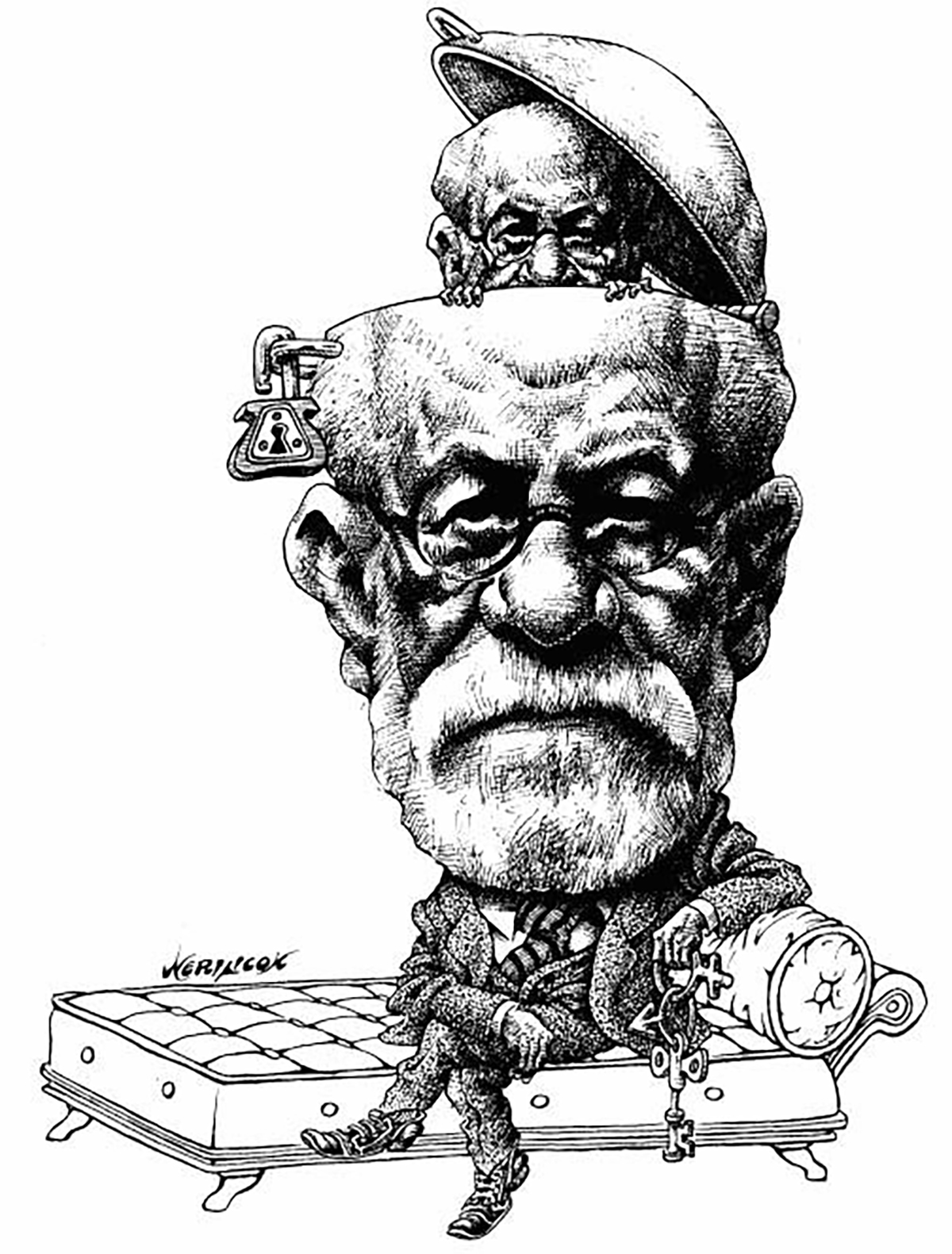
Westen, Novotny and Thompson-Brenner (2004) made some important critiques of the literature on ESTs. They noted that ESTs are often designed for a single, Axis I disorder, and patients are screened to maximise their homogeneity and to minimise their diagnostic comorbidity. Treatments are manualised and brief, and outcomes are assessed often by reductions in the primary symptom reduction for that particular disorder. Westen et al. suggested that EST researchers always tend to assume the following:
- Psychopathology is highly malleable
- Most patients can be treated for a single problem or disorder
- Psychiatric disorders can be treated without much attention to underlying personality factors
- Experimental methodology used to develop ESTs has ecological validity in clinical practice
Westen et al. (2004) basically contended that these assumptions are not valid, not to say wrong. There is considerable diagnostic comorbidity, making most patients ineligible to participate in EST research trials. There also is considerable stability of psychopathology of psychiatric symptoms, even after “successful” completion of EST. And clinicians of all theoretical orientations see patients well beyong the time allotted in treatment manuals (see Morrison, Bradley, & Westen, 2003; Thompson-Brenner, Glass, & Westen, 2003; Westen & Morrison, 2001 for an excellent review of these issues).
Norcross (2002a) offered an additional perspective on why the EST literature has been so controversial. First, he explained that EST research rarely addresses the fact “that the therapist is a person, however much he may strive to make himself an instrument of the patient’s treatment” (Orlinsky & Howard, 1977, p.567 as cited by Norcross 2002a). This idea has been demonstrate very well in empirical literature. For example, Wampold (2001) concluded in a meta-analysis of psychotherapy studies that the qualities of the therapist play a much stronger role in the outcome of treatment that does the treatment itself. Second, Norcross stated that therapy research has savagely neglected the important question of studying the therapy relationship. Instead, the focus has been more on the application and mastery of a technique (not a relationship). Third, who the patient is affects treatment outcome. As attention has been directed towards the study and implementation of psychotherapy techniques to different categories of disorders, small attention has been given to the patient characteristics that affect outcome, such as comorbid conditions, capacity for insight, and a history of interpersonal relatedness.
Psychoanalytic and psychodynamic therapies certainly are related to these issues. Analytic and Dynamic models of therapy are very focused on the behaviour and qualities of the therapist, with special attention to issues of the therapeutic alliance, neutrality, transference, and countertransference.

The couch that started everything: Freud’s psychoanalytic couch at the Freud Museum in London
It is important to also consider that one’s training in how to conduct psychoanalytic or psychodynamic psychotherapy is focused on how therapists present themselves and how patients respond to this. Such a focus automatically puts the therapeutic alliance at the centre of attention, something that has taken on more interest over the years (Fairbairn, 1952; Greenberg, 1986, 2001a; Pine, 1998; Stolorow, Atwood & Brandchaft, 1994; Wallerstein, 2002). Psychoanalysts have also recognised that the personality and qualities of the patient affect how therapy should be conducted (e.g., Gabbard, 2000, 2004); that is, one approach to working with patients does not fit all patients. Furthermore, many psychotherapists have been reluctant to allow their therapy relationships to be subject to empirical investigation (Bornstein, 2005), as a form of respect for the privacy of their clients, making it very hard to provide more objective data that the support the validity of psychoanalysis. In contrast, other schools of thoughts derived from the behavioural school and the medical fields have very willingly offered their data for empirical investigations.
Often accompanying this philosophical criticism regarding scientific testability is a factual criticism that psychoanalysts have seldom tried to test their theories scientifically. This criticism may have some truth to it, however many psychoanalysts have responded to the call for more scientific inquiry by asserting that it is unnecessary and that clinical evidence of the treatments curing mental illness of various types is quite sufficient.
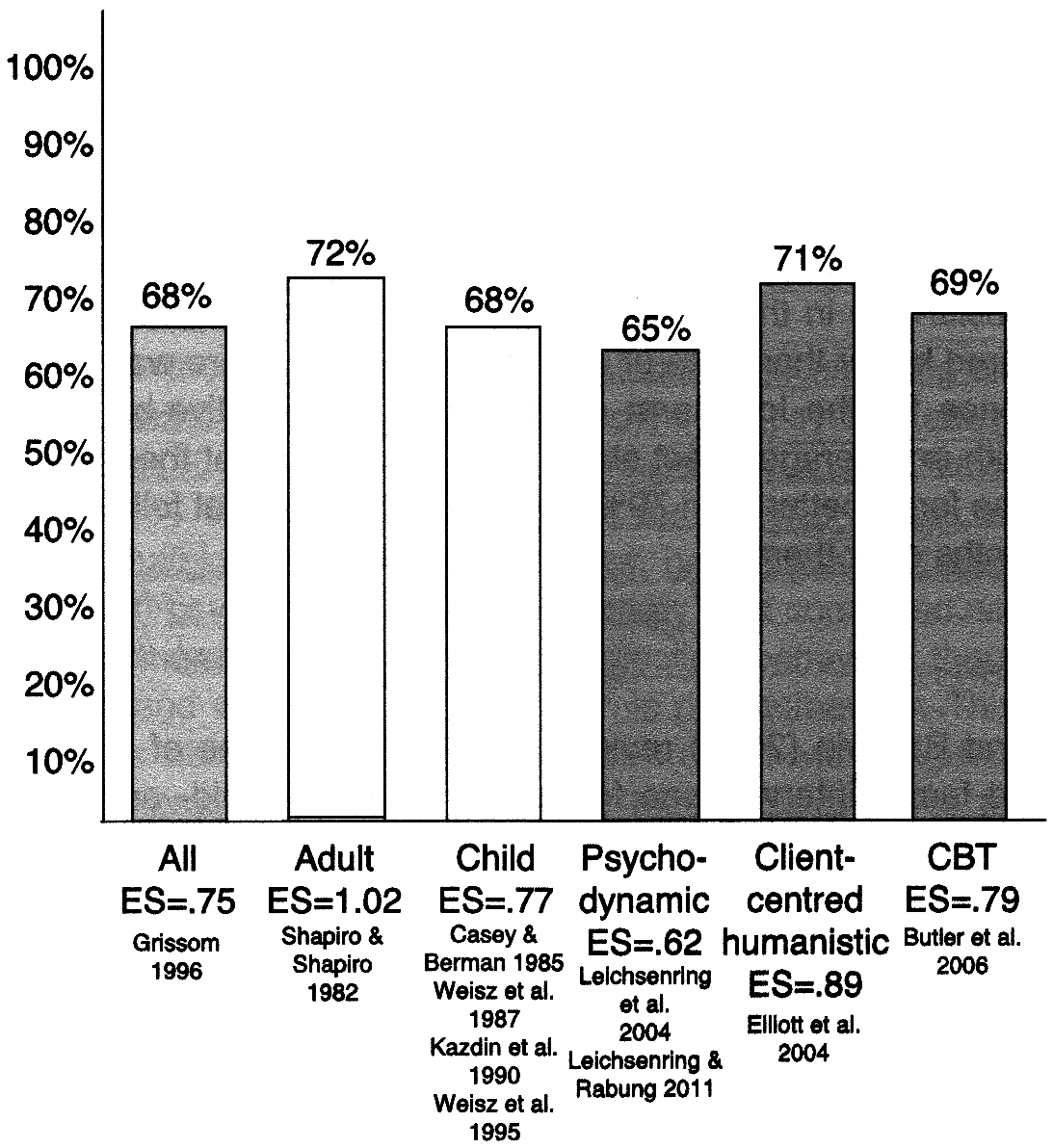
Success Rates of Psychotherapy with adults and children, and Therapy from other schools of thought [traditions] based on Effect Sizes from Meta-analyses / Source: dpurb.com
Other psychoanalysts have argued that scientific support for their theories is irrelevant. Psychoanalysis, they suggest, is not an empirical science, but a science of subjective experience and linguistic dissection, so it is inappropriate to judge it by the mainstream reductionist empirical scientific standards of modern day academia.
Many see psychoanalysis as a “hermeneutic” discipline, an approach to interpretation which is rather like a school of literary criticism or biblical scholarship. To them, psychoanalytic theory is a way to decipher mental life, an interpretative technique for uncovering meaning. Its goal, they say, is to understand psychological phenomena in terms of their underlying reasons rather than explaining them as objective science in terms of causes. Some have gone so far as to suggest that the goal of psychoanalytic understanding is not to ascertain literal or scientific truth – for example, what “truly happened in a person’s past to make them the way they are today” – but instead to formulate “narrative truth”, a story that gives coherent meaning to the person’s experiences [from their perspective in terms of what matters to them] (Spence, 1980).
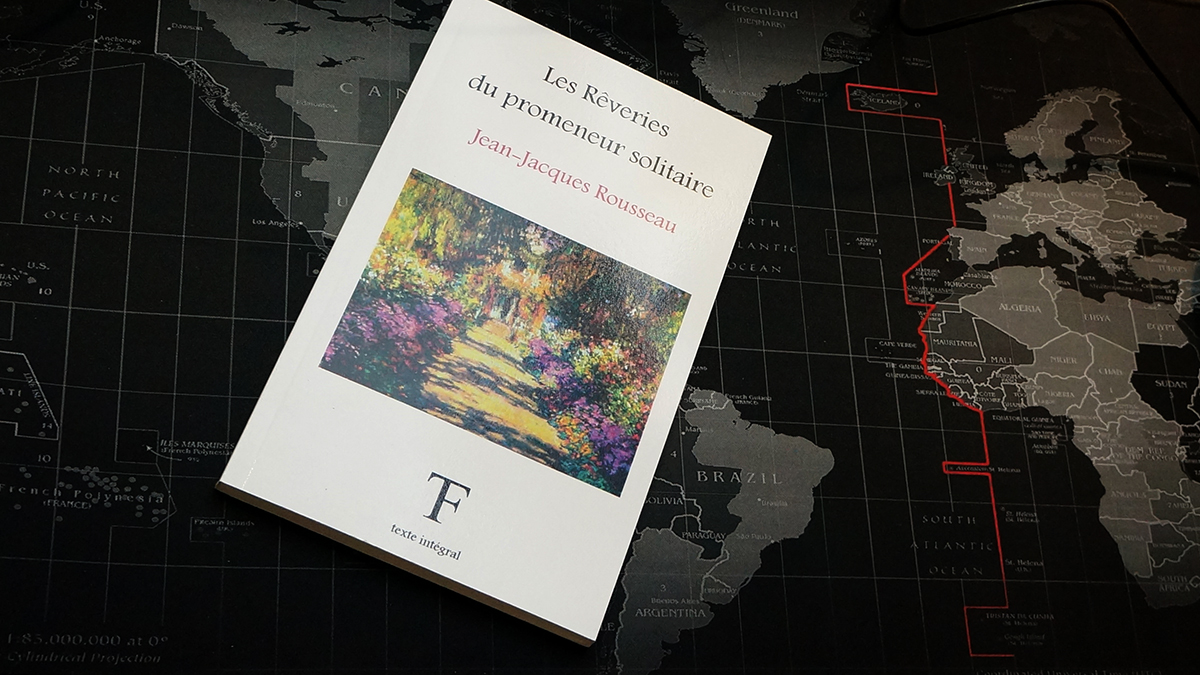
Photographie: Danny D’Purb © 2018
What Jacques Lacan clearly meant by a complete reconstitution of a subject’s history as the aim of psychoanalysis, is that “history” is not a simple objective sequence of past events, but the present synthesis of the past as it is subjectively perceived and interpreted by the continously evolving Subject in his/her uniqueness. Lacan’s used the term “après coup” [retroaction, i.e. how the present affects the past] and pointed out that linguistic discourse itself is structured by retroaction, since only when the last word of a sentence is uttered or read that the initial words gain meaning; with retroaction also comes “anticipation“, which refers to the way in which the future also affects the present, and like retroaction, anticipation also structures linguistic discourse, since the first words of a sentence are ordered in anticipation of the words to come. Jacques Lacan also pointed out how in the “psyche” [mind], present events affect past events [i.e. retroaction]; because the past is simply a set of stories in the mind of an individual that is edited and reinterpreted in the light of new experiences and information of the constantly evolving Subject in his/her uniqueness; most healthy individuals with desires, sculpt the stories of their past experiences to make it work towards their development; they take a particular perspective to extract meaning and significance from their past experiences [in terms of what matters to them and what does not] so that they contribute towards their development, progress and desires [See the Essay: The Concept of Self]. Lacan also pointed out that psychoanalysis is not concerned by what most empiricists would call the “real past” as an objective sequence of events devoid of subjective signification, but rather with the way these experiences exist in the psyche/mind of a particular individual and how he/she interprets (i.e. perceives) and reports them in order to find out what holds significance for a particular Subject and what does not.
We can thus conclude that there will always be something “uniquely special” about psychoanalytic evidence, for all its empirical flaws. A completed psychoanalytic treatment may sometimes [depending on the type of patient] occupy four or five sessions each week over a period of several years, amounting to perhaps 1000 hours in which the analyst listens closely to the patient’s innermost thoughts. These thoughts, often too intimate and raw to be shared even with loved ones, range widely over the patient’s personal history and lived experiences. They are recounted in a wide variety of mood-states and frames of mind. These millions of spoken words and feelings may not represent the kind of systematically and objectively collected data on which the scientific theory of personality [that the hardcore empiricist loves] can easily be built. However, it is hard to declare that the analyst does not understand the patient’s personality better than someone who might interpret the patient’s responses, dashed off in a matter of minutes, to a trait questionnaire. Indeed, there is something valuable about psychanalytic evidence, but it is very hard to build an empirical theory out of it since we are not dealing with matters of hard sciences [e.g. biology, medecine, physics, chemistry, astrophysics, material science, astronomy, etc], but the mind of human beings that embodies their whole existence and worlds.
Empirical Evidence for the Existence of Unconscious Processes
More and more psychoanalytic thinkers and sympathisers are starting to find creative ways to test psychoanalytic hypotheses in rigorous empirical ways to conform with academic science, despite all the difficulties that this involves. This research is now very extensive, and therefore difficult to summarise. However, a broad conclusion can be drawn from it: specific Freudian claims typically fail to receive experimental support but do work in treating mentally ill patients in clinical practice. What Freud learned from his clinical practice is that sexuality always involves a dimension of the impossibility of reaching “total” satisfaction for any Subject, and in order to achieve some satisfaction it is necessary to renounce total satisfaction, this renunciation is one of the references to the concept of “castration”, where castration is a condition for satisfaction. Castration refers to the separation installed by the Oedipal law in both sexes and thus is a requirement of civilised culture; it is the positive side of the prohibition of incest, this instinctual renunciation, is the structuring function in the resolution of the Oedipus complex and is necessary for all cultural achievement.

Image: Medscape (2015)
Freud elaborated three possible outcomes for the “castration complex/anxiety” in women: (i) a total repudiation of sexuality; (ii) the adopting of a masculine position and the repudiation of penis envy; and (iii) motherhood as a treatment of penis envy through the symbolic equation of penis equals child. As for males, Freud believed that the castration complex/anxiety serves to free the boy from the Oedipus complex; it is the prohibition of the primordial object [i.e. the mother(s) or mother figure(s)] and leads to a lack in individuals which will orient them to look elsewhere [i.e. go out into the world and seek a true partner], and in this way, desire is inaugurated; for a number of psychoanalysts however, the “castration complex” of Freud did not have the major structuring role in the construction of sexual difference and they instead turned to other explanations, such as biological and developmental theories.
The concepts of Penis envy [According to Freud, woman’s desire to have a child is rooted in the envy of the man’s penis. When a girl first realizes that she does not possess a penis, she feels deprived of something valuable (symbolically), and seeks to compensate for this by obtaining a child as a “symbolic substitute” for the penis she has been denied. Even though the girl may at first resent the mother for depriving her of a penis and turn to the father or father figure in the hope that he will provide her with a symbolic substitute (i.e. a child), she later turns her resentment against the father when he does not provide her with the child as substitute. Freud argues that penis envy persists into adulthood, manifesting itself both in the desire to enjoy the penis in sexual intercourse, and in the desire to have a child (since the father or father figure does not provide her with a child, the woman turns to another man instead). On this particular component of psychoanalysis, Lacan follows Freud, arguing that the child always represents for the mother a substitute for the symbolic phallus which she lacks (a type of lack known as “privation”). However, Lacan emphasized that the symbolic substitute for the phallus (i.e. the child) never really satisfies the mother; her desire for the symbolic phallus persists no matter how many children she has. The mother’s basic dissatisfaction and sense of privation is perceived by the child from very early on; the child realizes that she has a desire that aims at something beyond her dual relationship with him, the imaginary phallus. The child then seeks to fulfil the mother’s desire by identifying with the Imaginary phallus (or by identifying with the mother imagined as possessing a phallus, i.e. the phallic mother). In this way, the “privation” of the mother is responsible for introducing the dialectic of desire in the child’s life for the first time. Alfred Adler argued that the concept of “penis envy” should not be expressed literally but symbolically as women’s frustration at not being able to match male dominance in society, i.e. the phallus as representing male dominance in society. Karen Horney contested the claims of penis envy, which seems to suggest that some concepts may not apply to everyone, hence the wide scope of psychoanalytic theory to suit different developmental cases], Castration Anxiety and Repression, cannot be demonstrated easily through the simple methods used for mainstream science and empirical experiments in a laboratory, although some effort has been made. A study at the Harvard Medical School in Boston at the Massachusetts Mental Health Centre involving college aged women [ranging from 17 to 43 years old] and men [ranging from 18 to 23 years old] carried out by Rosalind Jones in 1994, tested the Freudian theory claim that the “natural” development of feminity involves the woman’s substitution of the wish for a baby in place of her original wish for a penis [i.e. penis envy]. In the study, the pregnancy message used was “Reproduction. The birth of a child. I should become pregnant. Entering my uterus. Entering my womb. I could become pregnant. To be fertilized. Becoming pregnant. The contraceptive field. To become pregnant. I could become pregnant, big with child”; the original penetration message was “I feel opened up. Things are getting through. It gets into me. I am opened up. Things are getting into me. I am sensitive. I feel things inside of me”; and the Revised Penetration message was “I feel opened up. He is getting through. He gets into me. I am sensitive sexy. I feel him moving into me. He is getting into me.” Consistent with Freud’s speculation about the phallic significance of pregnancy for women, Jones (1994) found that female subjects who were exposed to the subliminal pregnancy message produced significantly more phallic imagery responses to inkblots than did women in any other experimental conditions (p<.01).
Dreaming also does not seem to always preserve sleep by disguising latent wishes, and there is very little empirical evidence to back up the theory of Psychosexual stages, although it influenced the Theories of Attachment devised by John Bowlby. More “general” Freudian concepts however have often received a good deal of scientific support. There is today, plenty of evidence to suggest the existence of unconscious mental processes, for the existence of conflict between these processes and conscious cognition, and for the existence of processes resembling some of the defence mechanisms. Two illustrative studies can support his work. First, Fazio, Jackson, Dunton and Williams (1995) found that people who sincerely profess to having absolutely no racial prejudice can be shown to associate negative attributes with Black faces more than White faces in a laboratory task. This finding which has been replicated countless times by social cognition researchers, shows that the conscious attitudes of individuals may conflict with their “implicit” attitudes [unconscious]. Second, Adams, Wright and Lohr (1996) hooked male subjects up to a daunting instrument called the penis plethysmograph, which measures sexual arousal by gauging penile circumference. It was found that men who reported strong anti-gay (homophobic) attitudes demonstrated an increased arousal when shown videos of homosexual acts, whereas non-homophobic men did not. This finding seems to reveal some form of defence mechanism consistent with the psychoanalytic view that homophobia is a reaction formation against homoerotic desires. However, none of these illustrative studies can be considered as completely conclusive, and all have been controversial and subjected to various interpretations. For example, anxiety, shock, or anger rather than sexual arousal may have caused the increased penile blood flow of Adams et al.’s homophobic subjects.
These experiments prove that with enough creative ingenuity, some psychanalytic propositions can be scientifically tested. Doing so should contribute to the important task of sifting what is worth retaining in psychoanalytic theory for strict empiricists of the hard sciences.
Unconscious Processes: Integrating Cognitive Neuroscience and Psychodynamic Theory
In various ways, the evidence for the existence of mental processes that are outside of direct conscious awareness are apparent in every scenarios of life. Here are some examples:
- We sometimes cannot remember the name of a particular person of importance, only to be able to recall it hours or days later at a time and place when knowing the name is not required
- Despite one’s intention to offer some control over the process, dreaming appears to occur at its own timing and pace.
- On September 11, 2001, and the days following, many Americans watched hours of news report focussed on the same attacks on the United States. Although deeply upset by the contents, many individuals could not stop themselves from watching these videos, saying that it was as if something in them drew them to reports in spite of conscious awareness of disbelief and outrage
- Many patients who seek psychotherapy are unable to stop unwanted behaviours or interpersonal problems, despite conscious awareness of their harmfulness to them and their life. These problems range from relatively simple [e.g. drinking too much alcohol] to relatively complex [e.g. placing oneself in situations in which one is often taken advantage of or obsessing about one’s body image if certain kinds of fattening foods are consumed].

Other examples are evident too, simple exercises that can be easily performed. For example, consider when 3 lines are drawn in the shape of a triangle with the ends of each line however, not touching one another, leaving a small gap between all their extremities. We can come to realise that, depending on the space between the lines, the image is instantly perceived as a triangle by the individual, a triangle with missing edges; 3 lines that are coming together like a triangle, or just 3 lines at different angles.
When taking into consideration perceptual phenomena such as this [i.e. an example of the Gestalt principle of closure], it is evident that the mind does the following very quickly, without conscious awareness of how the process occurs, yet meaning and understanding are formed.
- Takes in sensory information
- Determines what the information is
- Assembles the information in such a way that a percept or concept is formed
- The percept or concept is “perceived” and “understood”
The evidence for the existence of unconscious processes is widely known in cognitive psychology. In a seminal paper in the American Psychologist, Shevrin and Dickman (1980) demonstrated how conclusions from the studies of selective attention, cortical evoked potentials, and subliminal perception provide support for the concept of an unconscious mind and posit that “no psychological model that seeks to explain how human beings know, learn, or behave can ignore the concept of unconscious psychological processes” (p. 432). They also noted that the initial stage for processing all stimuli occurs outside of consciousness and that it affects what is known consciously. This early stage is different in how it operates from conscious cognition, and conscious cognition necessarily occurs after considerable preconscious processing. Years, later, their conclusions and ideas appear to be no less true.
Empirical and Cases Studies Demonstrating Unconscious Processes
In studies of subliminal perception, which began in 1950s, the processing of unperceivable stimuli and its effect on behaviour has provided interesting results about the unconscious mind. Shevrin and Fisher (1967) subliminally presented participants with a picture of a pen and knee just prior to falling asleep. When they awoke from rapid eye movement (REM; dream stage) sleep, participants’ associations to their dreams were of a pen or knee or included less rational kinds of associations (a finding that had been well demonstrated in past sleep studies). These included words that sound like pen or knee, such as pennant, hen, or neither. In contrast, those who awoke during non-REM sleep, which had been associated with few dreams or dreams that were more rational, had associations such as penny (pen + knee) or related words, such as nickel and dime.
Shevrin (2006) noted that this study demonstrated that 2 levels of unconscious processing – irrational and rational – were taking place. He deduced that once inhibitions [e.g. defences] weaken – in this case, being awakened from sleep – more rational processes are overtaken by irrational ones. Surprisingly, the more irrational process observed in this study produced content similar to what was found in severe types of psychopathology: repetition and clanging. In a follow-up study with the same methodology, Shevrin (1973) presented participants with the same stimuli, this time while they were fully awake and more proximal to entering the sleep state. Again, they found a similar pattern of results in which the type of associations produced varied depending on when participants were awakened.
Even more interesting results were described by Shevrin and colleagues (Shevrin, 1988; Shevrin, Bond, Brakel, Hertel & Williams, 1996; Shevrin et al., 1992), who set out to demonstrate that unconscious and conscious processes operate differently. In these studies, patients were selected who had either pathological phobic reactions or extended grief. They were then assessed via interview, and 4 psychoanalysts listened to the interviews carefully. By way of consensus, the psychoanalyst researchers derived a conceptualisation of the core conflicts for each patient; then went on to select the patients’ words that they believed captured the patients’ conscious experience of the symptoms and words that represented unconscious conflict. These words along with unrelated words were then presented both subliminally and supraliminally to the patients, who were then asked to classify them as belonging together. Using event-related potentials to detect patients’ ability to classify or respond to words in similar ways, the researchers found that words representing unconscious conflicts were correctly classified only when presented subliminally and that the reverse was true for supraliminally presented words; they were correctly classified only when presented supraliminally. Here, we find some sense to Lacan’s deductions regarding the unconscious being structured like language and the linguistic dexterity that psychoanalyst should be able to handle to decipher and understand the fullness of the patient’s mind [conscious and unconscious].
Shevrin (1996) concluded, “…When [these studies are] taken in combination, [they] show that unconscious psychological causes affect consciousness in a qualitatively different way… and that unconscious conflict has an existence independent of the psychoanalyst’s inferences from conscious manifestations, an independence supported by brain correlates” (p. 591, italics in original). Shevrin also published reviews of research showing an association between subliminal perception and dreaming (Shevrin, 1986) and subliminal perception and repression (Shevrin, 1990).
In a more recent meta-analysis from more than 100 studies of subliminal perception, Weinberger and Hardaway (1990) found that psychodynamic material presented subliminally had a noticeable and predictable effect on behaviour, suggesting very clearly that unconscious processes affect overt behaviour. For instance, studies by Silverman and colleagues (Silverman, 1983, 1986; Silverman, Bronstein & Mendelsohn, 1976; Silverman, Kwawer, Wolitzky & Coron, 1973; Silverman, Lachman & Milich, 1982; Silverman, Ross, Adler & Lustig, 1978) found that subliminally presented messages of Oedipal content (e.g., “Beating dad is okay”) to male participants yielded more competitiveness in a subsequent dart-throwing game than non-Oedipal messages. [Note: Freud proposed that at the Oedipal stage, a competition between father/son and daughter/mother takes place, before it is resolved in the child gradually adopting the same-sex parent’s values as his/her own in the development of an early form of Conscience (Super-Ego/Preconscious)]
Bradley and colleagues (Bradley, Mogg & Millar, 1996; Bradley, Mogg and Williams, 1994, 1995) performed a series of studies in which words related to depression (e.g. misery, grief, despair) are subliminally presented to individuals who fall into 3 groups: those meeting the Diagnostic and Statistical Manual of Mental Disorders (DSM) criteria for major depression, those with subclinical levels of depression and those operating as controls. They consistently found that on implicit memory tests, depressed and subclinically depressed individuals correctly identity words related to depression more often than those who are not depressed. Although their findings have not been consistently replicated for patients suffering with anxiety, studies with depressive patients suggest that a level of processing occurs below conscious awareness that increases individuals’ awareness of and identification of depressive material. Clinically, it would suggest that to effectively treat and manage depression, addressing issues related to unconscious sensitivity to depressive material is very important. Given the relatively high relapse rates for depression and other disorders that are treated with methods focussing more on conscious awareness – via cognitive and behavioural therapies (Westen & Morrison, 2001) – it seems that attention to unconscious processes has the potential to effectively address some depressive disorders.
Eagle (1987) provided support for the notion of unconscious processing in studies of perceptual illusions and dichotic listening, a type of selective attention task. For instance, in the Ames room experiment (Ittleson & Kilpatrick, 1951), the ceiling and floor were not parallel, and the 2 subjects stood either towards the front or back of the room. This led perceivers to believe that the people very different in size , despite the fact that they were not. In the dichotic listening task (Lewis, 1970), individuals heard 2 different messages in each ear but were trained to attend to just one of those messages. When asked to repeat what was heard in the trained ear, individuals had less of a reaction time in producing the words when the words in the other ear were semantically similar [the meaning was synonymous / it meant the same thing]. This means that, there was a facilitative effect on performance when a semantically similar word was processed (unconsciously) in the “unattended” ear.
Further studies of patients who have experienced brain injuries provide interesting clinical observations that support the presence of unconscious processes. Milner, Corkin and Teuber (1968) reported the famous case of a patient known as H.M., who had undergone surgery on his medial temporal lobes to control very severe seizures. We nowadays know that just below the this part of the cortex lies the hippocampus, which is considered as an important anatomical locus for learning new information and storing it in working and long-term memory. Because of the damage done to the medial temporal lobes by the procedure, H.M. failed to remember anything that was new to him past surgery. H.M. however could remember information if he rehearsed it, although it was quickly lost if he was interrupted.
One interesting consequence of this procedure was that H.M. appeared not to have lost all “affective” components of certain experiences. For instance, H.M. had the occasion to visit his mother, who was hospitalised. After leaving the hospital, he had no recollection of visiting her, although he had the idea that something may be wrong with her. H.M. experienced other events like this, demonstrating well that implicit learning was still occurring for “affectively charged” situations and that the unconscious effects of this learning could be identified in everyday life.
Later studies of unconscious affective processing have suggested that there are at least 2 neural pathways that process affective information (LeDoux, 1989, 1995, as cited in Westen, 1999). One of these pathways originates in the thalamus and transmit sensory information to other brain regions, whereby emotional meaning is attached to the information. The other pathway, also originating in the thalamus, sends the sensory information to the cortex, where higher levels of emotional processing and emotional meaning are executed.
Mark Solms has reported some exciting work on the effects of unconscious processes on commonly observed clinical syndromes (e.g., Solms, 2000a, 2000b, 2001, 2002, 2004). Solms has taken a very active role in recent times in integrating the findings of neuroscience and psychoanalysis, which has created a relatively new discipline of study known as neuro-psychoanalysis. An interesting set of case of studies has been provided (Solms, 2000a) on patients who have experienced a strike on the right temporal lobe in the region, where the middle cerebral artery lies. In these case studies, psychoanalytic theory and treatment is integrated into the neurological understanding of the deficits the patients are experiencing.
Right hemisphere syndrome is a neurological disorder consisting of 3 major symptoms: ansognosia, neglect and spatial perception and cognition deficits. Anosognosia is the indifference or outright denial of an illness, which in the present case was the loss of the use of the patient’s left arm and side. Neglect occurs when patients ignore their paralysed limb and side. Patients often feel disgust when they are compelled to attend to the left side of the body, sometimes experiencing a sense of revulsion.
The spatial and cognitive deficits observed consist of defective facial recognition, imperceptions of facial emotion, environmental disorientation, and various kinds of apraxia [the inability to complete an activity involving muscle movement]. There are various theories about the emotional deficit in patients with right hemisphere syndrome. One theory suggests that the stroke affects attentional arousal that is mediated through activity in the right perisylvian region of the temporal lobe, which consequently gives rise to anosognosia and neglect. Another theory has focused on the fact that the left hemisphere is more involved with positive emotional processing and the right with more negative emotional processing. Since, the right hemisphere is damaged in this case, anosognosia and neglect occur because there is little to no processing of negative effect in the right hemisphere. A final theory states that it is the right hemisphere that is dominant for the perceptual representation of bodily states, which include more somatic or visceral perceptions. When this part of the brain is damaged or compromised, the brain can only rely on past somatosensory representations of bodily states, which provide the patient that there is no deficit or problem.
Solms (2000a) described Mr.C., a 59-year-old engineer who experienced right hemisphere syndrome after complications from a mild stroke. Only part of the visual field of the patient was remaining and he would not attempt to compensate for it [i.e. neglect], and he also ignored sensory stimulation that occurred on the left side of his body [anosodiaphoria]. He ignored and minimised his paralysed left arm, referring to it as being “like a dead piece of meat, but not it’s just a little bit lame and lazy” (p.71). Other deficits existed due to right parietal damage.
Mr.C. was “aloof, imperious and egocentric” (Solms, 2000a, p.72). He seemed unconcerned about others and would sit blankly at times staring into space. However, on occasion he would burst into tears or look as if this were the case. These periods however, were brief yet stood in stark contrast to the emotional coldness that he often presented with. During one physical therapy session, Mr. C. was making very little progress in learning how to walk. The physiotherapist reported to the treating psychologist that Mr. C. seemed “indifferent to the errors he was making, and he simply ignored her when she pointed them out to him” (p.74). In a session next day, Mr. C. told the psychologist that the physiotherapist indicated that he had been making mistakes, sounding as if he was confession something. Then, he said that another therapist had asked him to do some activities with blocks but that he could not do it. At this point, the therapist replied to Mr. C.:
“…it was difficult for him to acknowledge the problems his stroke had left him with, but it seemed that he was now more able to see them. Mr.C., carried on… [saying] his physiotherapy was “okay” but that his arm had not progressed to the degree that he required. Then, at this point, he suddenly withdrew from conversing… and began to exercise his left hand and arm with the right one. [The therapist] commented that is seemed as if he could not bear the wait, and wanted his arm to be completely better instantly… [He replied] “I just don’t want my left arm to get weak from non-use.” [The therapist then replied] perhaps it was too painful for him to acknowledge what he was on the verge of recognising a moment earlier – namely that his arm really was completely paralysed – and that the question of whether it would recover or not was largely beyond his control. This comment provoked an instantaneous crumpling of his face and a burst of painful emotion accompanied by pre-tearfulness. [Turning to the therapist] he said in desperation “but look at my arm [pointing to his left arm] – what am I going to do if it doesn’t recover? (pp. 74-75)
Solms (2000a) noted that this case demonstrates how unconscious material that was too painful to acknowledge was accessed through careful interpretations. Furthermore, the case example controverts the theory that these patients lack negative emotions or have no awareness of their bodies and their deficits. In Mr. C’s case, it is clear that implicit processes were at work and that the emotional response originated out of the complex, associative networks were formed by this patient’s unconscious processing of the painful loss of his bodily integrity.
Transference phenomena can also be better understood in the light of recent findings in cognitive psychology. To understand transference phenomena, Westen and Gabbard (2002b, pp. 103-104) highlighted important ideas in recent studies of cognitive processing.
- More representations consist of memory traces that are multimodal, which include semantic, sensory and emotional components.
- Representations of self and other exist as potentials for activation. Because there are potentials, they are subject to modification, which will interact with new knowledge, further developing the self and other representations.
- Memory networks consist of semantic, episodic and procedural knowledge, along with differing affects and motives.
- Unconscious procedures to manage emotions are defences and may be triggered outside of awareness. Co-occurring motives and affects may also be activated, such that the person may not be aware of either one or the defence being used.
- Conscious representation are some of many representations that get activated. Consciousness is a serial processing system, whereas multiple parallel processes get activated that are not available to consciousness.
As may be observed in these principles, Westen and Gabbard (2002b) suggested that transference phenomena represent a dynamic, ongoing process that occurs at the conscious and unconscious level. Because multiple cognitive events occur at one time, transference phenomena can be highly complex phenomena and can represent one of many possible reactions to the therapist, as well as other meaningful individuals in the patient’s life. In fact, multiple transferences can occur. For instance, a patient may feel particularly challenged by his work and may experience some feedback from his female supervisor about his recent difficulties with his job. Suppose the patient’s mother took great strides to help him whenever he felt frustrated in his school activities or work, such that he came to unconsciously expect her to provide assistance during challenging times. At work the patient may have experienced the supervisor’s comments as an invitation for help and assistance. Should no help be forthcoming, the patient would become irritated and disappointed with such a difficult supervisor. Likewise, suppose that this patient’s father was unavailable to help him. He may have to come to view male authorities as uncaring and disinterested in his plight. Thus, in his present treatment, the patient may find himself feeling scared and anxious towards his male therapist when talking about his recent disappointment with the supervisor. An exploration of his interaction with his supervisor may elicit anxiety in the patient towards his therapist whom he experiences as a disinterested and uncaring male. Likewise, he may feel very frustrated towards the therapist who is not willing to tell him how to manage his interactions with his supervisor, reflecting a maternal transference to the therapist who unconsciously should be offering help and assistance quickly and without much effort on the patient’s part.
The Psychoanalytic Account of Motivation
The account of human motivation, resting on sexual and death instincts, has been a big talking point for critics of psychoanalysis from the very beginning. Jung’s departure from the psychoanalytic movement was largely caused over disagreements over the motivational concepts. Jung questioned the centrality of sexuality and argued for the importance of spiritual motives. Alfred Adler on the other hand proposed a basic desire for social superiority and a “will to power”. Later writers within the psychoanalytic tradition also sought to expand the theory of motivation to include drives for mastery and competence, and for interpersonal relatedness.
In general, there has always been 2 major issues, the first is whether the sexual and death instinct are plausible sources of human motivation. Second, whether they are sufficient explanations of motivation, or whether additional motives that are not reducible to these drives are needed.
With respect to the first issue, it may be hard to deny [from a universal and organic standpoint] that sexual wishes and drives are powerful sources of motivation, especially if we include “sexual” desires as a part of loving relationships and for bodily pleasure. From a biological and evolutionary perspective it could not be otherwise, since reproductive success is the basic currency of individual genetic fitness, not to mention species survival [in all species including primates and mammals].
From this perspective, the psychoanalytic emphasis on sexual drives – an emphasis shared by no other personality theory – is a very strong point of the psychoanalytic theory, even if we are allowed to disagree and investigate some particular claims that may not apply to some individuals regarding the effects of the Psychosexual stages in childhood as proposed by Freud [which inspired John Bowlby’s Theory of Attachment], or discuss the other drives that are non-sexual [e.g. Romantic love and its expressions].

From the same evolution standpoint, a death instinct directed inwards towards self-destruction is questionable. However, this negative judgement on the death instinct, which is shared by many contemporary psychoanalysts, does not mean that we need to dispense with the idea of aggressive drives. Aggressiveness could be theorised not as a form of self-destructiveness, but rather as a way to strive for social dominance [among a particular frame, circle or group], i.e. to fend off “attackers” in defence of one’s own “territorial grounds” or to assert one’s personal choice or interest.
The second issue is whether sexual and perhaps aggressive drives are broad enough to capture the full range of human motivations. The answer, is clearly not. Since, we also have drives for achievement, approval, non-sexual relatedness, creativity, self-esteem, and so on? The other question is biologically-based motives that “push” us towards certain kinds of behaviour enough? Do future-oriented motivational concepts, like goals and personal ideals not “pull” us towards desirable endpoints? When these questions are raised, basic Freudian account of motivation may seem limited in their scope, leaving out motives that are socially shaped or personally determined. However, the issue is not so easily resolved, since psychoanalysts may agree that motivations beyond the instinctual drives are required to describe how our behaviour is guided, however it may still be argued that all these motivations are simply multiple layers of the very same instinctual drives. For example, achievement striving could be described psychoanalytically as a socially shaped motive that is underpinned and powered by aggressive urges [that are applied in different forms to achieve our goals, i.e. not in a physically violent manner, but competitively in multiple sophisticated social ways]. On the same note, creativity might be understood as a sublimated expression of individuals’ sexual drives [e.g. artistic creations], based on some unconscious desire for unifying and making connections that Freud saw as the hallmark of life instincts.

Traduction(EN): “What we could not say and what we could not silence, music expresses.” -Victor Hugo (1802 – 1885)
However, even if the claim that human motivation is ultimately based on a few instinctual drives that govern all living organism, it would still be more enlightening and accurate to patients to describe their motivation in a more complex way, i.e. expressed to meet the sophisticated and multi-layered human societies we live in. So, in the end there is no objective or empirical way to establish the question of motivation with a clear “true or false” – we will have to use logical reasoning and theories about what drives “life” forward.
Documentaire: L’invention de la Psychanalyse (1997)
The 2 Major Disciples of Psychoanalysis: Carl Jung and Jacques Lacan
The psychoanalytic movement was largely the invention of Sigmund Freud, and his influence far exceeds that of his early followers who subsequently tried to modify psychoanalysis. The major principles of psychoanalysis were redefined and reinterpreted until by 1930 the movement was fragmented into competing views. Nevertheless, those writers who departed from Freud’s speculation retain the basic model of psychoanalysis that conceived of personality in terms of an energy reduction system with three levels of awareness that is the conscious [that contains the Ego], preconscious [that holds the Super-Ego] and the unconscious [the wild Id]. The psychoanalytic movement has been very active since Freud’s death in 1939, and has led to many new theoretical developments influencing all schools of psychology rather than standing still as we have just covered regarding the reconciliation of some fundamental concepts with Cognitive psychology and Neurosciences.
Carl Jung (1875 – 1961)
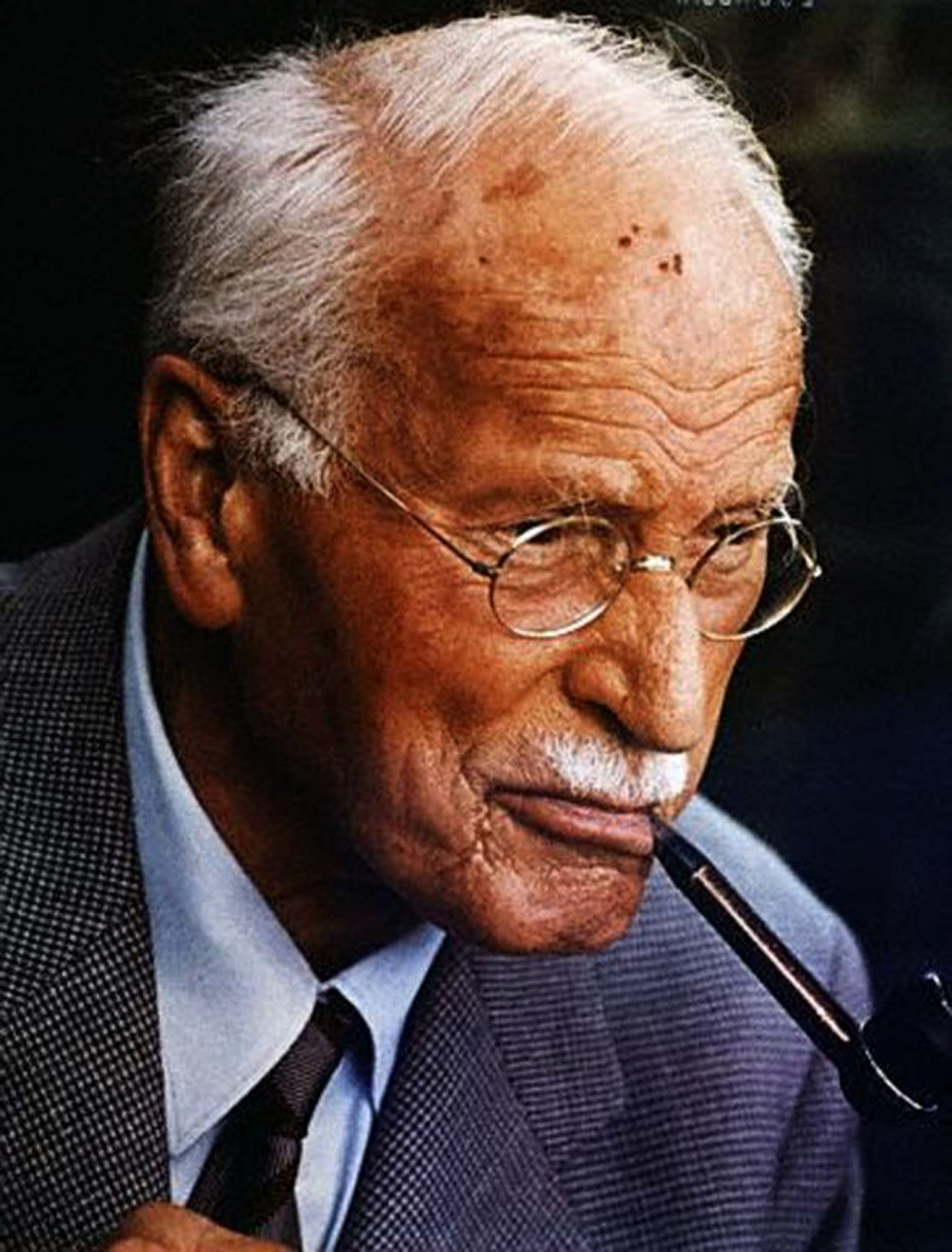
One of the most fascinating and complicated scholars of this century, Carl Jung (1875 – 1961) was born to a poor family in a northern Swiss village. He managed to gain entrance to the University of Basel and received a doctorate in medicine in 1900. Jung spent most of the rest of his life in Zürich, teaching, writing and working with patients. After reading The Interpretation of Dreams in 1900, Jung began corresponding with Freud and finally met him in 1907. Eventually he accompanied Freud to America in 1909, where he also lectured and introduced his own work to American audiences. However, Jung began to apply psychoanalytic insights to ancient myths and legends in search for the key to the nature of human psyche. Such independent thinking did not meet with Freud’s approval, and there is also some speculation that the Jung made a critical analysis of Freud’s personal life that may have contributed to tensions between them. Freud secured the post of the first president of the International Psychoanalytic Association for Jung in 1911, but by this time their rift was beyond healing. Finally, in 1914, Jung withdrew from the Association and severed all interactions with Freud due to the over-emphasis of the defining stages of infant sexuality among other aspects of pure Freudian theory. Jung continued his own interpretations of psychoanalysis and made several expeditions to study primitive societies in Western United States, Africa, Australia and Central America. His prolific writings on subjects ranging from anthropology to religion provided novel insights to age-old problems of human existence from the psychoanalytic perspective.
Jung’s “Analytical psychology” refined many Freudian concepts and emerged as the first major alternative to Freudian theory (1900); however, Jung retained Freud’s terminology [Unconscious, Conscious and Preconscious], and as a result the same terms often carry different meanings. Jung (1912) renamed the Id as the Personal Unconscious, the Ego as the Personal Conscious [although the term Ego also appears in some of Jung’s writings], and the Super-Ego as the Collective Conscious [although the term Persona also appears in some of his writings]. After that Jung’s (1912) analytical psychology also added the Collective Unconscious to Freud’s (1900) structure of personality which is part of the Id.
Jung, like Freud, believed that the central purpose of personality is to achieve a balance between conscious and unconscious forces within the personality. However, Jung described two sources of unconscious forces. What is the personal unconscious, consisting of repressed or forgotten experiences similar to Freud’s preconscious level. The contents of the Personal Unconscious [Id] are accessible to full consciousness. Jung’s Personal Unconscious held complexes, which were groups of feelings with a defined theme than give rise to distorted behavioural responses. According to Hall and Lindzey (1970), “… a [complex] is an organised group or constellation of feelings, thoughts, perceptions, and memories which exists in the Personal Unconscious” (p.82). Unlike archetypes [which reflect the cumulative experiences of the entire human race, Homo Sapiens], Complexes reflect each individual’s unique experience. For example, a boy who repressed negative emotions about his mother could become an adult with the complex, experiencing intense feelings and anxieties when images or stimuli associated with motherhood are encountered [because they are dominated by their mothers], for e.g. some mothers might offer nourishment only after – not before – their babies stop crying, thus communicating the unconscious message that the mother is all-powerful.
The second source of unconscious forces in to Jung’s theory, is the Collective Unconscious, more powerful source of energy that contains inherited contents shared with other members of a particular group, i.e. it consists of aspects of personality, common to all humans, that we have inherited from our ancestors. Jung here was talking about individual similarities and not differences in personality. As the personal unconscious has complexes, the collective unconscious has archetypes, defined as primordial images evolved from human beings primitive ancestry of specific experiences and attitudes passed on over centuries [after all humans did evolve from basic primates to the sophisticated beings were now are]. Hall and Lindzey (1970) define archetype as “…a universal thought form (idea) which contains a large element of emotion” (p.84). Although modern science has shown that direct environmental influences has more power in shaping the individual mind, some aspects may be retained from evolutionary psychology although it is important to consider the fact that human societies are constantly evolving in more ways than one. At the time that Jung devised his theory however, he listed such archetypes as birth, death, unity, power, God, the devil, magic, the old sage and the earth mother. As Weitz (1976) noted, according to Jung’s Analytical Psychology, archetypes equip humans to interact with particular aspects of their physical and social worlds in a particular manner, thus archetypes are adaptive from an evolutionary standpoint. For example, Jung (1912) contended that all humans possess a “mother figure” archetype that not only gives them readily accessible image of a generic mother at birth but also predisposes them to interact with their actual mothers in a particular manner [e.g. crying, sucking]. Solomon (2003) noted that in Jung’s Theory, collectively experienced archetypes provide basic themes around which personally experienced complexes are organised. For example, all individuals are born with a readiness to seek nourishment from their mothers (the mother archetype), some individuals may find that their mothers use this readiness against them (mother complex).
The notion of a collective unconscious in personality that provides the individual with patterns of behaviour fits well with Jung’s preoccupation with myths and symbols. Jung believed that the adequacies of a society’s symbols to express archetypal images are an index of the progress of civilisation. [e,g, the Ancient Greeks who after sophisticating their society through the evolution of their values, philosophy & educational system, saw peasants turn into conquerors, sculptors, poets and artists who even went on to colonise countries that later changed the history of those who colonised them in timeless ways / See: L’épopée de la Grèce antique (2016)].
Jung focussed on the middle years of life, when the pressures of sexual drives supposedly give way to anxiety about the more profound philosophical and religious issues of the meaning of life and death. By reinstating the notion of the spiritual soul, Jung argued that the healthy personality has realised the fullness of human potential to achieve self-unity and complete integration. According to Jung, this realisation occurs only after the person has mastered obstacles during the development of personality from infancy to middle age. Failure to grow in this sense results in the disintegration of personality. Accordingly, the person must individualise experiences to achieve a “transcendent function” by which differentiated personality structures are unified to form a fully aware self.
Both Jung (1921) and Freud (1905) wrote about libido, or psychic energy, that presumably fuels individuals’ behaviour, however Jung viewed libido in a less sexualised form. Jung redefined libidinal energy as the opposition of introversion – extraversion in personality, bypassing Freud’s extreme sexual emphasis. Extraversion forces are directed externally to the people and the environment, and then nurture self-confidence. Introversion leads the person to an inner direction of contemplation, introspection and stability. Jung (1921) believed that all individuals are capable of experiencing introversion as well as extraversion over time, however, individuals at any particular point in time may be characterised as experiencing either introversion or extraversion. The opposing energies must be balanced for proper psychological functioning, sensation, thinking, feeling and intuition. An imbalance between extraversion introversion is partly compensated for in dreams. Indeed, for Jung dreams have important adaptive value in helping the person maintain equilibrium. Jung has been praised for developing a dichotomy of flow of psychic energy [i.e. introversion vs extraversion] that has been recast as one of the major personality traits in various trait theories [for empiricists who believe the main focus should be the “conflict-free” conscious part of the ego, to which many basic concepts of Cognitive Psychology can be applied].
In addition to introversion versus extraversion as a pair of opposing directions of flow of psychic energy [i.e. inwards versus outwards], Jung (1921) postulated that thinking vs feeling and sensing vs intuition represent 2 pairs of opposing modes of adaptation and functioning.
As Jung grew older, his writings increasingly came to emphasise mysticism and religious experiences, domains usually ignored by mainstream empirical psychology. Out of all the early founders of psychoanalysis, Jung held views in sharpest contrast to those of empiricism. However, he offered a unique treatment of critical human issues that had not been systematically studied by psychologists and still remain in the realm of speculative philosophy. Perhaps Jung was more of a philosopher than a psychologist, nonetheless he provoked and confronted issues not readily accommodated in other systems of psychology.
Jacques Lacan (1901 – 1981)
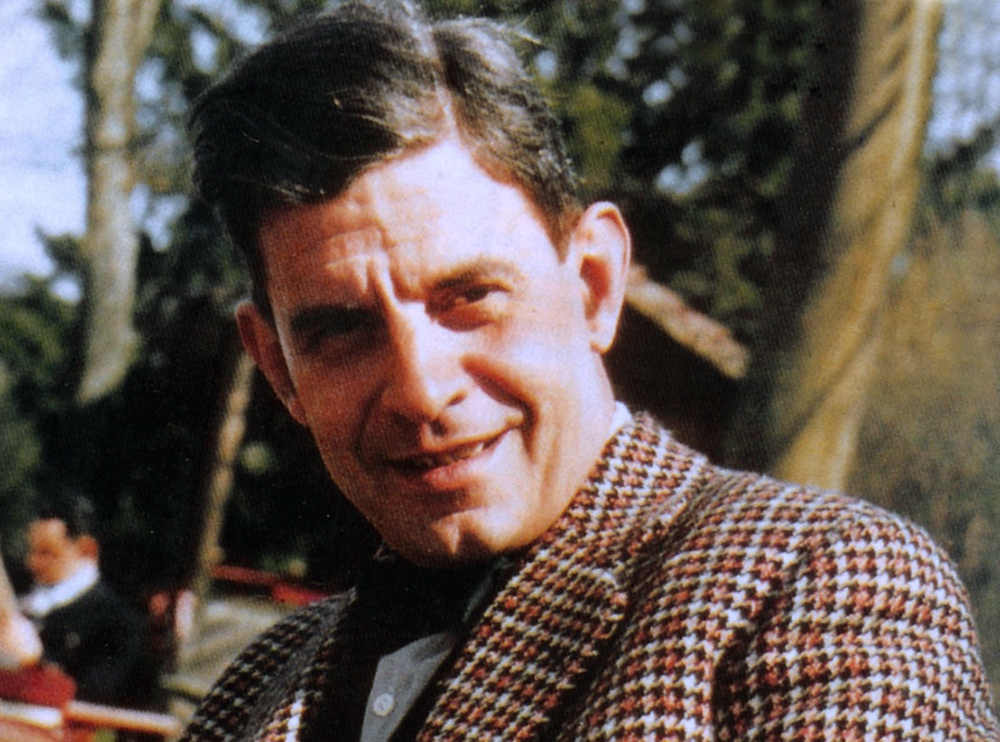
One of the most famous post-Freudian development, especially popular in Europe and South America, was initiated by the colourful French psychoanalyst Jacques Lacan. Lacan was the son of a successful oil and soap salesman from Paris. His mother was a firm Catholic and his younger brother entered a monastery in 1929.
The two early philosophical influences of Jacques Lacan were Spinoza & Nietzsche:
(i) Baruch Spinoza (1632 – 1677)

Traduction(EN): “Joy is man’s passage from less to greater perfection.” -Baruch Spinoza
Spinoza is known as the philosopher of nature and human passions who identified the concept of “God” and Nature. Spinoza proposes that wisdom is the intellectual love of the true God, immanent to reality [that is, scientific studies of Nature are to understand the forces that govern the creations of “God”, e.g., medicine, etc.]. Spinoza is considered a Cartesian, i.e. a disciple of Descartes. Spinoza believed in Ethics as a geometrical method that manifests the philosopher’s will to proceed in a rigorous manner, as mathematicians do; he strives to express in Ethics, in an objective manner, the fundamental essence of all things, in other words, the basis of understanding. In Spinoza’s philosophy, Ethics does not designate a moral code, but the true knowledge of the true concept of “God”, immanent to the world [which is said to be contained in the nature of a being and does not come from an external principle], the practical science of what is: a single substance, absolutely infinite, of which we are only modes. Spinoza’s concept of “God”, the object of Ethics, has nothing to do with that of the Judeo-Christian religion, a principle transcendent to the world – Spinoza does not believe in transcendence. So, we see oppositions to Nietzsche which Jacques Lacan also synthesized with his more modern theories of the psyche. Spinoza did not believe in transcendence and expelled any anthropomorphic representation of the divine [Note: Anthropomorphism is the attribution of characteristics of human behaviour or morphology to other entities such as gods, animals, objects, phenomena, even ideas]. God is nothing else but an absolutely infinite Being, composed of an infinity of attributes, a unique Substance [the Substance designating what is in itself and conceived by itself]. Therefore, God identifies Himself with this substance and designates the whole of reality or Nature, understood as the unity of things and the only Being to which realities relate: Deus sive Natura – God or Nature [a united and infinite nature]. Of this unique substance, of this Nature being one with God [although not interchangeable], human intelligence grasps only two Attributes, Extension and Thought (L’Étendue et la Pensée), the Attribute being defined by Spinoza as what the understanding perceives as constituting its essence. In this perspective, the particular objects of the world represent modifications of the infinite Substance that is Nature [i.e. God’s transcendence], in other words “modes“, that is, affections of this substance. Thus, each particular creature appears as a mode of God, as being in something else, by means of which it is conceived. This tripartition of Substance-Attribute-Mode allows us to grasp the meaning of the concepts of Nature-naturing (natura naturans or Nature-naturante) and Nature-natured (natura naturata or Nature naturée). Nature naturing for Spinoza is God himself, as he is in himself and conceived by himself, as the producer of all reality, i.e. as doing what nature creates/does. Nature natured is considered as everything that follows in the nature of God and his attributes, that is to say, everything that is produced by the Substance of God as he is in it through it. The problem with Spinoza’s system is that it was absolutely deterministic; the infinite attributes of God necessarily produce certain effects, and Spinoza assumes that nothing is given by chance in nature. In Spinoza’s magnum opus, The Ethics (L’Éthique), he speaks of absolute necessity, which has the meaning that everything is already determined by divine Nature to produce an effect [in modernity we know from empirical research that natural and environmental determinants combine to define humans]. Spinoza sees contingency [in other words, what cannot be] simply as a defect in our understanding, a lack of real knowledge. The essence of human nature lies in an active element in all of us that Spinoza calls “conatus”, the effort by which everything strives to persevere in its being, i.e. a natural inclination to strive toward preserving an essential being, where virtue/human power is defined by success in this preservation of being by the guidance of reason as one’s central ethical doctrine, with the highest virtue being the intellectual love or knowledge of God/Nature/Universe. When the “conatus” becomes self-conscious, it is called “desire”, which is therefore identified with “appetite” accompanied by consciousness itself. Thus, conatus and desire correspond to the dynamic affirmation of our being. We find here some link to Schopenhauer’s philosophical meditations about the “Will” and also Lacan’s focus on “Desire” being at the heart of psychoanalytic praxis. However in Spinoza’s reflections, human desires are modified by the intervention of external environmental causes, since we are subject to the action of forces to which we are bound, being all a part of Nature, and it is from this effect that passions are born, passive modifications of our being; this is linked to Lacan’s concept of “chaine signifiante” [signifying chain] which is the structural basis of the unconscious and the roots of linguistic discourse and speech. The two fundamental passions are sadness and joy from which the other passions derive: sadness is the passage to a lesser perfection, while joy is the passage to a greater perfection. Spinoza believed that man’s life is marked by the sad procession of sad passions [hatred, envy, jealousy, la mauvaise foi, etc.] which reduce man to a state of servitude, of passivity; this is where the philosopher comes in, whose responsibility it is to heal man from his sad passions: to make him maître (master) of himself.

« Génie de la Liberté » par Auguste Dumont, 1836
In Spinoza’s philosophy, virtue is acquiring true knowledge of our passions through the right ideas and notions. Therefore, the virtuous discovers the dynamism that animates him, which allows him to regain the power of the conatus: to know reality and to reach the fullness of existence [Virtue and life are thus inseparable]. The wise man is therefore the one who reaches true knowledge and, in this way, achieves the fullness of existence. The wise man lives under the regime of reason, in this way the Spinozist citizen also finds the agreement and unity of his semblables (fellow men). Therefore, the state must be rationally created, because only the rational state opens the way to freedom, according to the laws of human nature, that is to say, aware of the infinite nature of humanity. Spinoza seems to be situated in the democratic thought where all have equal rights with total freedom of opinion, thus the destiny of free men, living under the regime of reason, in a free city, is outlined. By gaining access to la connaissance vraie (true knowledge), man again becomes a God for man. So, we can see that Spinoza is a rigid penseur de système (system thinker), allowing man to free himself from his illusions and find and accept his place in Nature. Spinoza’s philosophy is not only intellectual but also practical and truly powerful: wisdom is acquired through knowledge; joy is maintained through the search for good passions. Thus, man can persevere in his being.
(ii) Friedrich Wilhelm Nietzsche (1844 – 1900)

Traduction(EN): “The greatness of man is that he is a bridge and not an end.” – Friedrich Nietzsche
Nietzsche is the philosopher of the “will to power”, conceived as creation and vital fullness, as the overwhelming affirmation of life. What is essential is our world as it is joy and will-power. As for the illusion of the afterworlds, Nietzsche hunts it down in all its forms. Nietzsche can be considered a moralist above all. It is clear that Nietzsche’s philosophy is one of the most complex thoughts, a complexity linked as much to his poetic and aphoric writing as to his refusal to situate himself clearly in the philosophical tradition, and we find this in Lacan who was also a literary and profound writer with a singular thought, a synthesis of several schools of thought, where the mediocre reader finds himself in the middle of a nightmare when trying to read it and may even start to question the level of his own intellectual abilities, his place and purpose in the universe. Unseizable, Nietzsche’s writings must be approached like a mountain, a slow progression. Nietzsche diagnosed the essence of the mortal crisis of our time: he described it, in its main characteristics, and in a quasi-clinical manner. He studied it at various levels and, in so doing, often announced with the greatest precision what was only beginning to emerge at the end of the nineteenth century; this fatal disease of modern times, ours, is nihilism, the reign of the absurd, of Nothing (“nihil”, as the etymology tells us). Nihilism or the absence of sense, makes becoming a purposeless process and all traditional ideals lose their value. Nihilism, this “Nothing” symbolizes the death of the Divine and the Suprasensible in man [Nietzsche’s death of God can be interpreted symbolically as the death of sensitivity and goodness in man]: we have killed him [the Divine], Nietzsche sometimes tells us, and darkness is now the lot of our world. This death of the Divine as seen by Nietzsche also announces a new dawn in our time: the coming of the “Last Man” which signifies the completion of nihilism. The “Last Man” designates the most despicable thing in this world: the one who is powerless to create and love, the individual totally enslaved and enjoying a programmed and petty “happiness” – he thus hops on the surface of the earth. Lacan, like myself, did not completely follow Nietzsche, but used some of the concepts of the German of the time and then refined them in the field of psychology for the twentieth century. Concepts of metaphysics are sometimes exaggerated in a negative way by Nietzsche, and the advances of our era make some of his views obsolete. One of Nietzsche’s exaggerations seems to be the origin of metaphysics, which he believed to be the by-product of the suffering and resentment of those unable to create positively, and which also engendered moral values [good and evil]. We see that Lacan did not take up everything from Nietzsche, but showed originality by relying on what was worth keeping in our modern world and which could be synchronized with his psychology based on the creative force of language in the Cartesian Subject [i.e. based on Descartes’ model: “Je pense, donc je suis”]. However, we still have concepts of Nietzsche that are in the name of positive creation, and the perfection of the individual and society, and they still have a place in modern philosophical thinking such as those of Jacques Lacan, which assimilate reason, logic, empiricism, metaphysics, genetics, and human and societal evolution.

Credits: D.R / Centre Pompidou “Le festival Hors Pistes dédié chaque année à explorer les images en mouvement et rencontrer celles et ceux qui en font la matière de leur création, de leur pensée ou de leur écriture…” Source: FranceCulture, 2020
Lacan synthesized Nietzsche’s influence with the strong constructionist and linguistic logic of his pychoanalytic theory, which directs us towards a system of thought where sophisticated and civilised individuals orient, identify and group themselves by “psychical” understanding, connection and similarity, with language [i.e. the communicative discourse and/or speech] as a founding pillar, and not by the atavistic logic of the simple physical/biological illusions of the imaginary since this brings us, human beings, closer to animal psychology; the reasoning behind Lacan’s theory suggests that civilised individuals should see others as semblables [fellow men] not based on the physical but on the “psychical”, with a founding pillar being language; the individual should rise above the illusions of solidarity of the physical to embrace the psychical. This is avant-garde and synchronised with the reasoning of science and discoveries of the 19th century with the contributions of Darwin, Freud and Kant. Nietzsche’s inspiring concept is that of “The Will to Power” (Volonté de Puissance) which should not be interpreted by the simple mind as the appetite for power or the spirit of domination or competition, because this would be to conceive or understand it in a very restrictive or destructive way. To Nietzsche, “The Will to Power” is a set of essentially competitive impulses [in the “mediocre”], but also the very movement of creative transcendence [in the noble soul of the “aristocrat” – the term was used by Nietzsche in its essentially spiritual meaning to design the best, that in his times, were individuals from the aristocracy, being those who had a privileged access to the best teachers, institutions and collections of books, which has since changed into mostly vast, yet simple, inheritances of wealth and land; hence in our present society the “aristocrat” term could define the gifted and valiant mind with a wealth of knowledge, profoundly educated, cultivated, creative and consciously connected with the positive values of humanity and nature, i.e. with the ability to shape and have a lasting impact on generations]. This “Will to power” can also mean the struggle for life and also spiritual fullness and existential superabundance. “The Will to Power” is an ambivalent notion that cannot be reduced to its most superficial or trivial forms or manifestations; in its noblest dimension, it is a vital, plastic, destructive but also creative force [which seems to be connected to Shiva, the Hindu god, and Dionysus, his Greek equivalent in the phallic cult according to Alain Daniélou (See the Essay: History on Western Philosophy, Religious cultures, Science, Medicine & Secularisation)]. To understand the essence, it is the body of man [of the human being] that we must take as a reference point, for the body is wisdom and reason, which can be defined as intelligent dynamism, the organic faculty of understanding and thinking: every organism thinks and it is permissible to speak of an unconscious bodily thought [for after all, it is through the senses available from the different organs acquired through the multiple facets of the evolution of the human body that man sees, hears, discovers, smells, touches, tastes, reads, feels, expresses a wide range of emotions, learns, thinks, writes, creates and gains an understanding of human existence and the wider environment (i.e. the natural world), and adjusts to optimise his “psychical” experience].
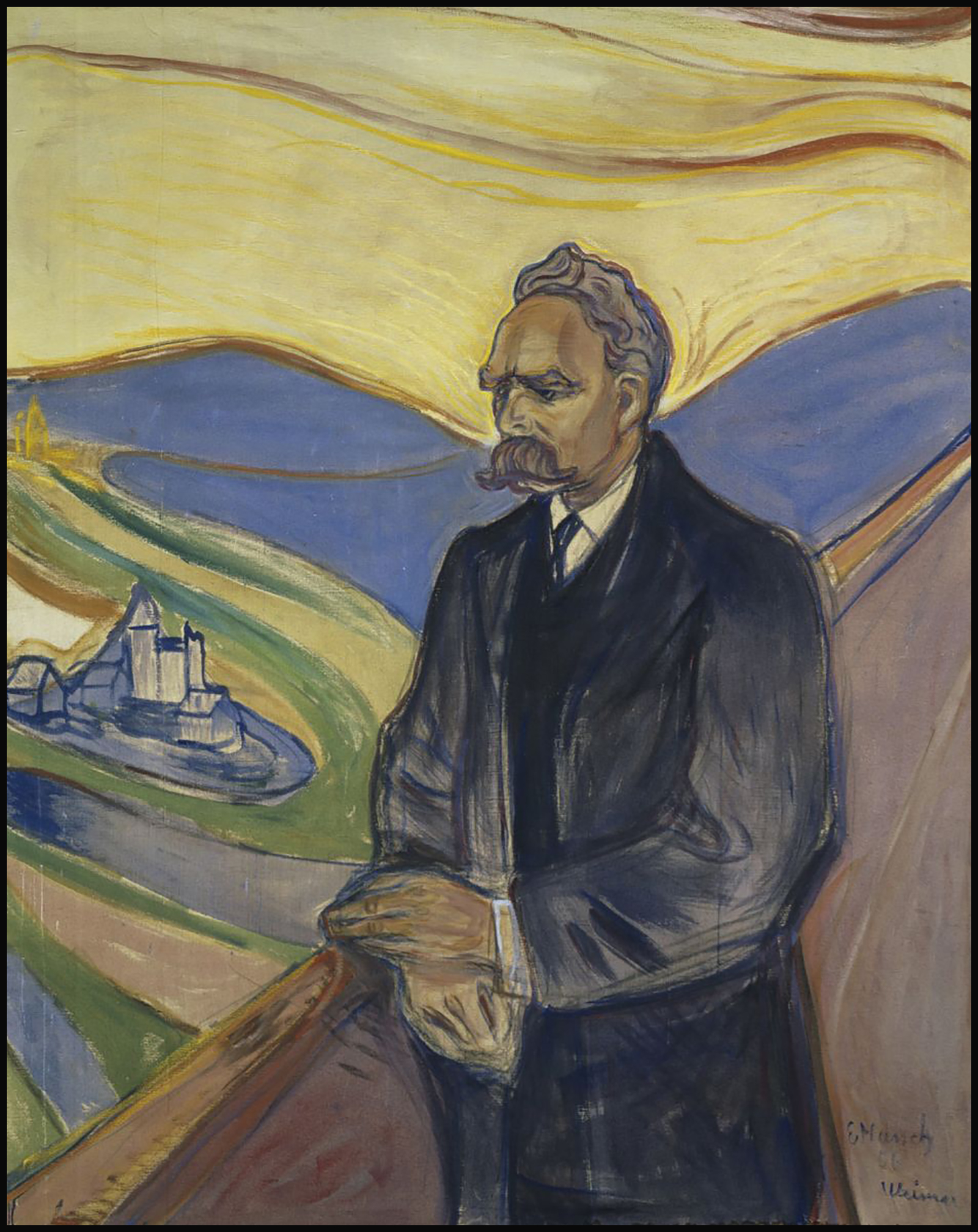
« Friedrich Wilhelm Nietzsche » par Edvard Munch (1906)
Nietzsche seems to rehabilitate the unconscious as a psychic reality beyond the clear and transparent grasp of oneself. The authentic “Will to Power” as affirmation and fullness reveals, within its creative superabundance, the true field of life and transcendence.
« Puisse chacun avoir la chance de trouver justement la conception de la vie qui lui permet de réaliser son maximum de bonheur. »
French for: « May everyone have the chance to find just the right conception of life that allows them to achieve their maximum happiness. »
– Friedrich Nietzsche
For Nietzsche, among the creations of life is, first and foremost, Art, which Nietzsche conceived in a much more global and dynamic form, where it becomes an invention of harmonious forms, a production destined to embellish the whole of human existence. Nietzsche conceals ugliness, he humanises or hides everything ugly. This set of materials and signs created by the artist who manifests an ideal of beauty is only an appendix of this production of forms that is art in general, this “ivresse de la vie”: a will to exist through harmonious forms. The field of creative life includes artistic activity, authentic work, and generally everything that concerns the positive edification of values: work, the shaping of all things, linked to joy, but does it differ profoundly from the miserable labour for gain? To the powers of life are also attached the authentic moral values, those created by the best, “les maîtres” (the masters) who are in the vital current of the “Volonté de Puissance” (Will to Power). Thus, Nietzsche’s thought is elitist: the beautiful creative individuality is opposed to the vile herd [the mass]. This “elitist” morality, i.e. this creative act, this triumphant affirmation of values, an affirmation that takes place in joy, is a thousand leagues away from the morality of the “slaves” [metaphor], which is linked to the resentment that gives birth to negative values and “la mauvaise foi” (nastiness, hatred, evil, etc.). What should the man in a world devoid of the divine values believe in? Believe in yourself, in your own power, free yourself from all dominant morality and ideology and follow your own path: become who you truly are and desire – this is what Friedrich Wilhelm Nietzsche would have said. Nietzsche calls for exceptional people to no longer be ashamed in the face of a supposed morality-for-all, which he deems to be harmful to the flourishing of exceptional people. He cautions, however, that morality, per se, is not bad; it is good for the masses, and should be left to them. Exceptional people, on the other hand, should follow their own “inner law”; a favorite motto of Nietzsche, taken from Pindar, reads:
« Become what you are. »

“Le Voyageur contemplant une mer de nuages” (Der Wanderer über dem Nebelmeer) par Caspar David Friedrich, 1818
In what he considered to be the zenith of his philosophical creation, “Also sprach Zarathustra” [Thus Spoke Zarathustra], Nietzsche portrays the path of a wise man who only addresses himself, a nomad who accepted the disappearance of the divine among men as a personal liberation, a being who freed his mind completely of the burden of ultimate truths, a hermit who did not need anyone anymore and who had overcome hatred and resentment, living in harmony with himself and the cosmic forces of nature: an Übermensch (un Surhomme/an Overman).
It is to be noted that “Thus Spoke Zarathustra”, Nietzsche’s magnum opus, completely opposes and rejects the unscientific notion of a superior or pure group or organic composition (i.e. “race”), but instead focuses on the superior individual [organism] who can appear from anywhere as an agent and expression of the cosmic forces of nature.
Les Forces Cosmiques de la Nature: l’Océan (2020)
Yet, while there are no superior groups but only superior individuals, we may still reasonably argue that there are languages that are superior since they offer the ability to interact with a wider audience, but also because these languages offer an entry point and the gift of belonging by creating a social bond to the specific social environments they originate from; environments that may also be considered as superior if the way they are organised [i.e. philosophy, educational system, values, culture and government] lead to more chances of individual human development and life satisfaction, mainly due to the progressive outlook and heritage of their sophisticated and evolving institutions and the way they are managed. However, it is important to understand that any individual speaking in a superior language does not automatically lead to everything being said in that language to be worthy of consideration because while the communicative patterns (i.e. language) of human primates vary from regions, the IQ and creativity of the individuals do not, as the Organic Theory clearly states. Jacques Lacan also reached a fairly similar conclusion since he also distinguished the speaking Subject of the enunciation [i.e. how words are pronounced] from the Subject of the statement [i.e. the genuine message of the discourse], which suggests that in order to evaluate the true worth of any linguistic discourse, it is the genuine message that should be extracted; in other words, it should be translated in the appropriate language of the reader/listener so that its true value and meaning can be assessed.
Thus, individuals who intend to share their wisdom and contribute to the world’s development would have an advantage in adopting and mastering a communicative pattern (i.e. language) deemed superior by the fact that it comes with modern human values and is weaved in the fabric of a more refined and sophisticated intellectual, psychosocial, philosophical and artistic heritage [e.g. French, which is the most desired and most spoken second language in the UK and in Germany] since it would be understood by the wider audience of the civilised world, where the major intellectual and cultural evolution/revolution takes place. It was the French revolution, which had been heavily influenced by the movement of the Enlightenment [i.e. the 18th century intellectual movement of reason], that would secularise a number of Christian humanitarian values into the constitution, most notably the famous « Liberté, égalité, fraternité » [French for: “Liberty, equality, fraternity”], which is inspired from the free will of Christians, as the French philosopher Michel Onfray reminded. Equality [Égalité] is derived from the concept of equality before God, and brotherhood [Fraternité] is derived from the concept of the community of the ecclesia. Liberté [Freedom], of course, most people know what this means, which is the freedom to explore, to choose, to discover, to learn, to express ourself, to speak, to have open debates, to question, to propose, to love, to create, to live life fully within the limits of reason and respect for the mother psychosocial sphere. Hence, as French philosopher, Michel Onfray noted, we have a concept that was passed on from St. Paul to Robespierre and that went through the French revolution, where the new generation of French people secularised and embedded those values with the firm belief that “we have a universal world view; we want everyone to share our values of ‘liberté, égalité, fraternité!'”.
In 2021, Michel Onfray reminded that this led to a generation of French minds who think that we have to go out into the wider world, where the vast majority of people are, in order to share our good news with them, which is our universal human values of « Liberté, égalité, fraternité ». At the Assemblée Nationale, Jules Ferry stood for the idea of free, secular and compulsory school, and so, that school, we people of French heritage thought that we would give it to the whole planet. This created the wave “We are going to colonise”. Onfray pointed to the example of the colonisation of Algeria as one that shows the intention of the French to pass on their good ideas and values. Hence, when we look back at the historical wars of the French revolution, we come to realise that they were wars of ideological and intellectual colonisation. When we consider the German philosopher, Hegel’s passionate words about Napoléon, Hegel now comes across like a great collaborator for the French colonisation concept, as himself as an iconic German historical figure, described Napoléon’s conquering arrival in Germany as: “I saw the Emperor – this world-soul – riding out of the city on reconnaissance. It is indeed a wonderful sensation to see such an individual, who, concentrated here at a single point, astride a horse, reaches out over the world and masters it“. Those words from Hegel were written in a letter to his friend Friedrich Immanuel Niethammer on the 13 October 1806, the day before the battle of Jena, which would be fought on the plateau west of the river Saale in today’s Germany between the forces of Napoleon and Frederick William III of Prussia, with the historic defeat suffered by the Prussian army subjugating the Kingdom of Prussia to the French Empire; the victory is celebrated as one of Napoleon’s greatest. It is quite ironic, because the great German, Hegel’s words admitted that the French heritage is superior to his own; and in 2021, the post-modern French philosopher Michel Onfray ironically suggested « on a juste envie de lui dire ‘mais enfin, et ton Allemagne ? » [French for: You just want to say to him, “But what about your Germany?”].
It may also be useful for the majority of anglophones and fellow English people out there who hardly know their own cultural evolution, to point out that there is French on the emblem of the British monarchy. The words, « Dieu et mon droit » have been the motto since the time of Henry V (1413 – 1422), and since those times old English is not the language of the English elite anymore which resulted to the use of words and expressions of French and Norman origin that are now widely used in the English language.
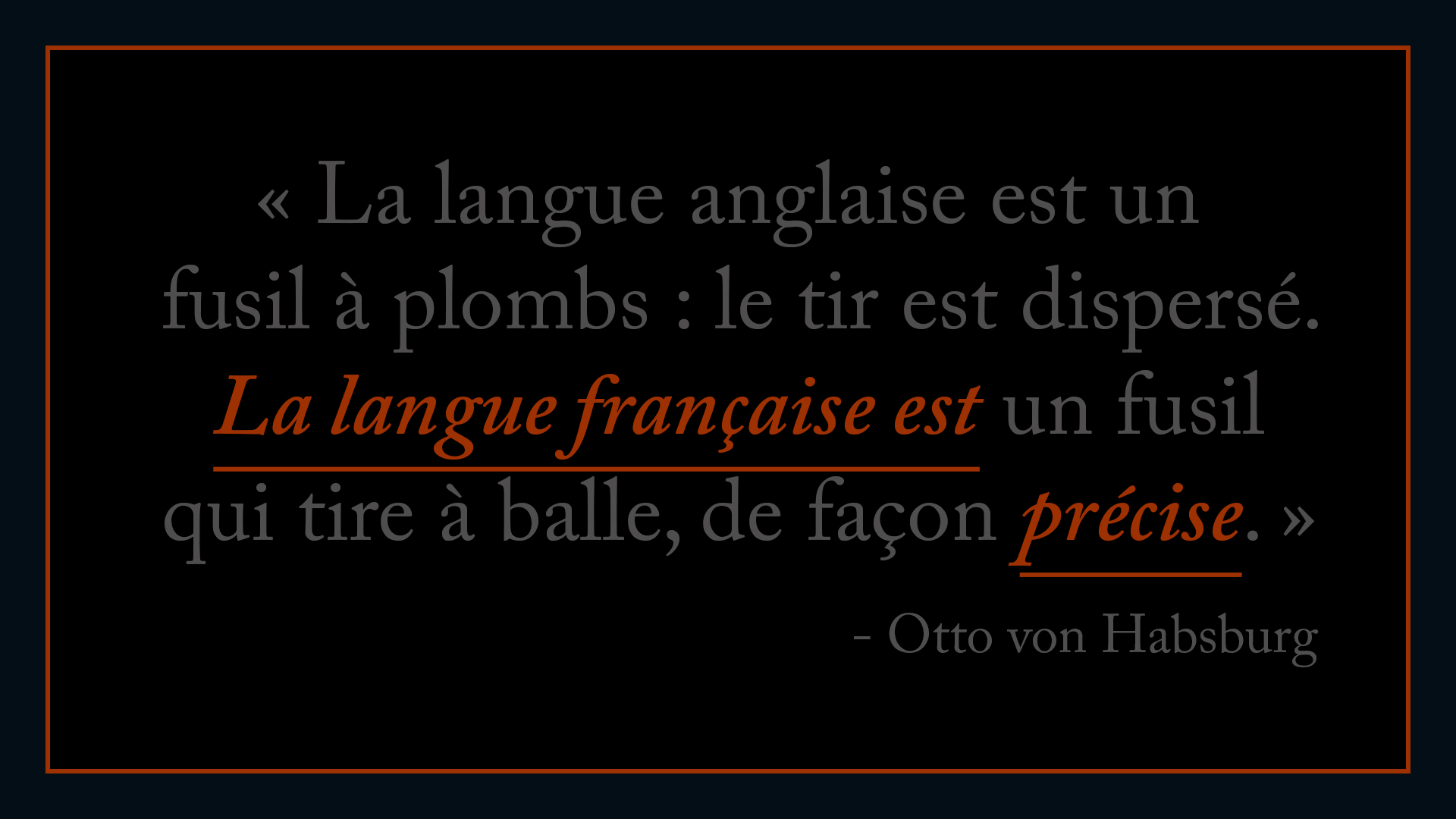
Traduction(EN): “The English language is a shotgun: the shot is scattered. The French language is a rifle that shoots bullets, precisely. » -Otto von Habsburg
Nietzsche rightly concluded that there are no superior groups, but only superior individuals that come from the wider human population and together these individuals constitute the force that shapes civilisation; this conclusion had unconsciously acknowledged what science would certify about a century later in 2018, as a genome-wide association meta-analysis in 267, 867 individuals identified 1,016 genes linked to intelligence, which is a highly heritable trait and a major determinant of human health and well-being (Savage, Jansen, Stringer et al., 2018). Before Nietzsche, no philosopher had placed so much emphasis on the individual perspective; he restored the existential mission of philosophy by detaching himself from all the irrational conventions of his time, abandoning lengthy theoretical papers to redact concise reflections on the way of living one’s own life. Nietzsche’s philosophy is centred around the personal sphere of the individual.
In modern times, with the advances of psychology, we can conclude that a superior psyche will include a superior understanding, judgement and vision as the French psychologist, Monique de Kermadec also pointed out regarding “l’adulte surdoué” [i.e. the gifted adult]. The criterion of authenticity always appears to be linked, in Nietzsche’s view, to the affirmation and creative power of life. Nietzsche uses the god Dionysus [whom the French orientalist Alain Daniélou connects to Shiva for his cycle of destruction and creation as an equivalent] as a symbol of life, the most overflowing being of life, who in Nietzsche’s thought embodies the process of “becoming” as destruction and creation; Dionysus is sensuality, the enjoyment of a force that destroys but also generates/creates. The term dyonysism refers to the identification with the principle of ecstasy and life. Thus arises the Übermensch (Overman/Surhomme) for Nietzsche, who faced with the death of the divine, nihilism and the “Last Man” [which designates what is most despicable in this world, the one who is powerless to create and love, i.e. the individual totally enslaved and enjoying a programmed and petty “happiness”, those who think that this symbolic death of the divine means nihilism and pure destruction], will have to face these despicable “Last Men”; one could therefore see the Übermenschen (Overmen/Surhommes) as agents of the divine rising to counter evil and the decline of the positive values of civilization; the concept of the Übermensch also seems to share some similarities to what Monique de Kermadec qualifies as l’« Adulte Surdoué » [The gifted adult].
Video: Monique de Kermadec : L’adulte surdoué : bien vivre sa douance (2012)

Traduction(EN): “Before you diagnose yourself with depression or low self-esteem, first make sure you are not surrounded by idiots.” – Sigmund Freud
For Nietzsche, the earth is no longer in the hands of the divine, but in the hands of those despicable “Last Men,” and the outrage against the earth is now what is the most dreadful. Nietzsche fights against immorality in the name of immoralism, and shows us that the death of the divine is not enough to animate the world with a new morality, and that without the will to power [if it is animated by a weak will], “morality” can turn into nihilism [a nothing, or the absence of sense that makes “becoming” a purposeless process where all traditional ideals lose their value]. The construction of a new morality will be so superior to the old one that it calls, according to Nietzsche, new men, Übermenschen (Overmen/Surhommes), and this new morality will be precisely the “Will to Power”. In order to clarify the concept of Übermensch (Overman/Surhomme) let us clear up misunderstandings by explaining what the Übermensch (Overman/Surhomme) is not, here is a negative definition:
« All beings up to now have created something beyond themselves that is superior to them. What is the ape for man? That is precisely what man must be for the Übermensch (Surhomme/Overman) »
Nietzsche in his time was not an evolutionist, which has changed in our time, and therefore not in possession of the data on the genetics of Übermenschen (Supermen/Surhommes), he conceived of the emergence of the Übermensch (Overman/Surhomme) by the man who surpasses himself: a transcendental man who surpasses himself to become what he really is deep down.

The notion of the Übermensch (Overman/Surhomme) is the backdrop of Nietzsche’s philosophy, it is from the Übermensch (Overman/Surhomme) that Nietzschean thought makes its entrance and all his other themes must be understood from this notion. Thus, to Nietzsche, by pushing back the forces of reaction, of simple negation, those linked to the “NO”, by surpassing himself towards those of life and positive creation, man transcends himself towards the Übermensch (Overman/Surhomme), towards a superior human type, free of mind and heart. The Übermensch (Overman/Surhomme) is for Nietzsche the meaning of the earth, the next term of evolution. It is also very important to avoid any misinterpretation of Nietzsche’s “Übermensch” (Overman/Surhomme) which has been wrongly caricatured over the years, it is not specifically or solely about the “blonde beast” of Germanic myths as it is often portrayed by ignorant and mediocre journalists and the masses. After Friedrich Nietzsche’s death, his sister Elisabeth became the curator and editor of Nietzsche’s manuscripts, reworking his unpublished writings to fit her own German nationalist ideology while often contradicting or obfuscating Nietzsche’s true philosophical orientation which were instead explicitly opposed to antisemitism and nationalism but promoted a more universal ideology. Through her published editions, Nietzsche’s work wrongly became associated with fascism and Nazism; 20th century scholars contested this interpretation of his work and corrected editions of his writings were soon made available. Nietzsche’s thought enjoyed renewed popularity in the 1960s and his ideas have since had a profound impact on 20th and early-21st century thinkers across philosophy—especially in schools of continental philosophy such as existentialism, postmodernism and post-structuralism—as well as art, literature, psychology, politics and popular culture. Nietzsche’s philosophy is thus organized around a few major concepts: that of the Übermensch (Overman/Surhomme), the Dionysian and, of course, the Will to Power.
Documentaire: Schmutte, H. (2016). Nietzsche : entre génie et démence. ARTE. [Notice: If the video cannot be viewed from your region, we recommend using HOLA VPN (Click Here, it is FREE!)]
Let us add, finally, the concept of the Eternal Return (any state of the universe returns periodically and this seems to be an intelligent metaphor that explains the state of matter in the universe, constantly being recycled and reshaped). Nietzsche thus (like Lucretia or Spinoza) drew a philosophy of joy, creation and vital fullness. Nietzsche celebrated life and stressed that the secret of the greatest enjoyment is to live intensely and dangerously. Today, Nietzsche’s work and intellectual contribution are considered as revolutionary for its time, however in the very beginning they were not appreciated and recognised for their true worth by his contemporaries; the philosopher struggled to live with his publications and found himself on the fringes of society without any income or fixed accommodation at 35 years old, which had turned out to be a point of no return for him after he put an end to his teaching activities, adopting a nomadic life and living in modest accommodations. An amazing achievement for Nietzsche was the fact that he was named professor even though he had not completed his thesis.
During Jacques Lacan’s studies at the Collège Stanislas he was introduced to the work of Baruch Spinoza & Friedrich Nietzsche, and draws from his years in uniform, the intimate conviction that the most violent psychological wounds and sufferings always arise within communities apparently subjected to the greatest normality. Lacan had felt misunderstood by his father, who had destined him to a business life. He thus enters the modernity of the twentieth century by way of an intellectual rebellion, eager to explore the essence of “madness” whose shadows he had perceived in his own family, Lacan turned to psychiatry. In 2001, Elisabeth Roudinesco said: “Il faut voir l’apport de Lacan comme un tableau moderne. Lacan n’est plus dans l’univers classique des représentations mais dans l’univers de la peinture moderne. C’est la peinture de Picasso par rapport à la peinture classique (…) toute la modernité est passée.” [French for: “Lacan’s contribution should be seen as a modern painting. Lacan is no longer in the classical universe of representations but in the universe of modern painting. It is Picasso’s painting in relation to classical painting… all modernity has passed.”]
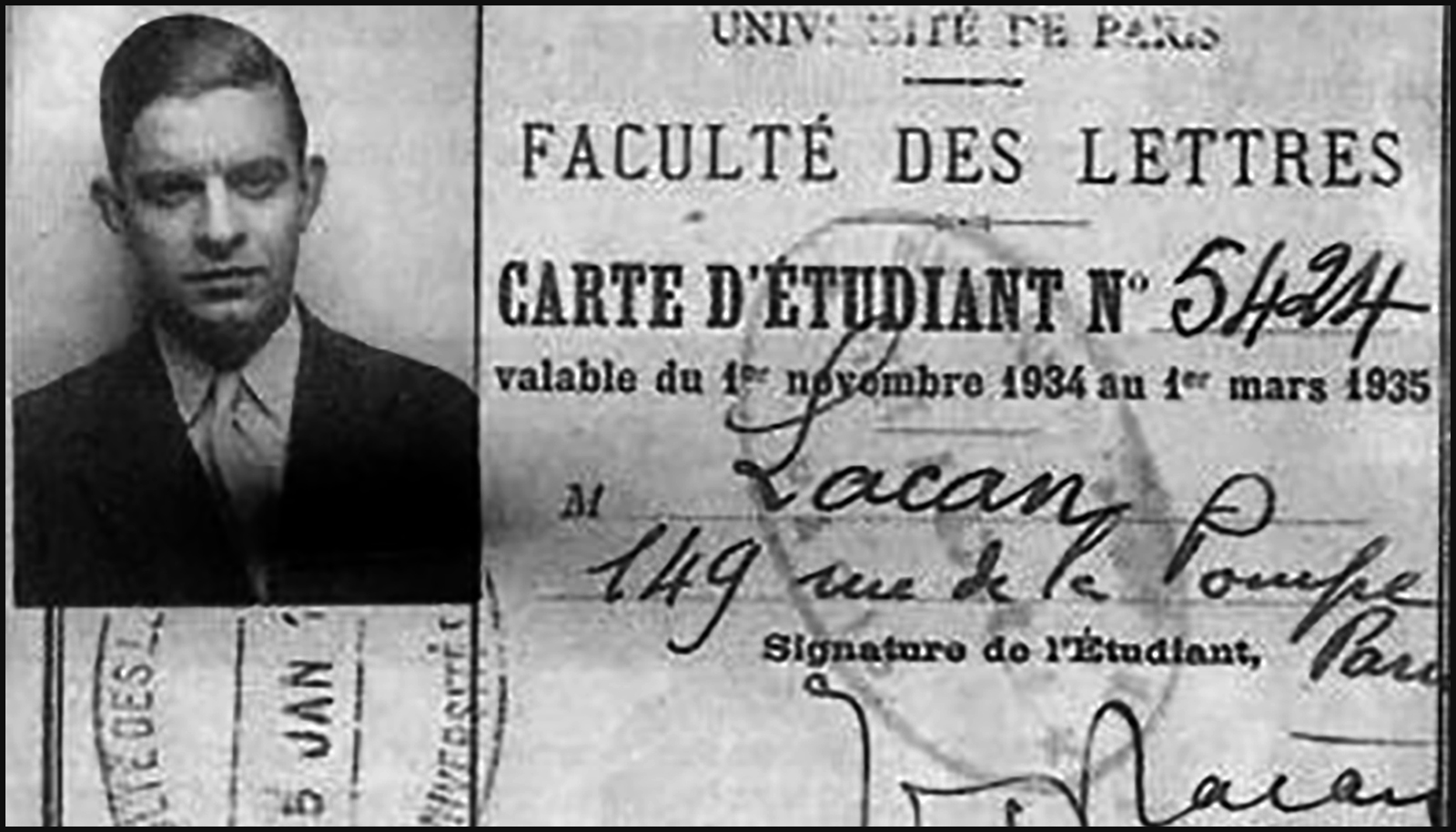
During the early 1920s, Lacan actively engaged with the Parisian literary and artistic avant-garde movements. Having met James Joyce, he was present at the bookshop where the first readings of passages from Ulysses in French and English took place, shortly before it was published in 1922. Lacan also had meetings with Charles Maurras, whom he admired as a literary stylist, and he occasionally attended meetings of Action Française (of which Maurras was a leading ideologue), of which he would later be critical on some aspects that he firmly disagreed and considered as outdated, such as the positivist sociology of Maurras which presents the subject as a simple product of his “milieu” [circle], derived from his culture which was even pushed to absurd extremes by Édouard Pichon to theorise about a “national unconscious”. Lacan was more avant-garde and perhaps unknowingly embraced future psychological advances of neuroscience by founding his logic on the thesis of German biologist and philosopher Von Uexküll who convincingly argued about the multitude of determining factors of the environment and not simply the basic evolution of species, but on the sophisticated elaboration of language [discourse / langage] which identifies the development of the individual psyche to a social structure.
In his famous “Rome Discourse,” Lacan stated: « Le symbolique, l’imaginaire et le réel, les trois registres par lesquels j’ai introduit un enseignement qui ne prétend pas innover, mais rétablir quelques rigeurs dans l’expérience de la psychanalyse, les voilà, jouant à l’état pur dans leurs rapports les plus simples. » [French for: “The symbolic, the imaginary and the real, the three registers through which I have introduced a teaching that does not claim to innovate, but to re-establish some rigour in the experience of psychoanalysis, here they are, playing in a pure state in their simplest relationships.]“ In that same discourse in Rome in 1953 addressed to the Société Française de Psychanalyse, Lacan denounced the way that the role of speech in psychoanalysis had come to be neglected by contemporary psychoanalytic theory, and argues for a renewed focus on speech and language. This remains one of the fundamental modification from Freudian conception: the human being is linked to language. The founding statement of Lacan’s theory defines psychoanalysis as a practice of speech and a theory of the speaking subject. Lacan asserted that psychoanalysis is distinguished from other disciplines in that the analyst works on the Subject’s speech [i.e. linguistic discourse], pointing out that Freud often referred to language when he was focusing on the Unconscious; after all language is the “talking cure” and is constitutive of the psychoanalytic experience. It would be impossible to understand the concept of “madness” without analysing the true reasoning behind it through language and to know if it is “madness” or subjective construction and interpretation that is stable in a particular Subject’s psychical realm. It is the emphasis on language [linguistic discourse] that is regarded as the most distinctive feature in Lacan’s theory which also criticises the way other forms of psychoanalysis tend to play down the importance of linguistic discourse and instead emphasise “non-verbal communication” of the analysand (e.g. body language, etc) at the expense of speech. To Lacan this is a fundamental error for the following main reasons. Firstly, all human discourse is inscribed in a linguistic structure [whatever the language]; even body language is a form of language with the same structural features. Secondly, the aim of psychoanalytic praxis is to articulate the truth of one’s desire in speech [i.e. linguistic discourse] rather than in other forms – the fundamental rule of psychoanalysis is based on the principle that linguistic discourse is the only way to the Subject’s “truth”. Thirdly, linguistic discourse through speech is the only tool and means of access that the psychoanalyst has, since no one can read minds. Any analyst who does not understand and master the way speech and linguistic discourse work does not understand psychoanalysis itself.
Lacan proposed that like the words uttered by God in Genesis, speech is a “symbolic invocation” which creates ex nihilo, “a new order of being in the relations between men.” Lacan distinguished “la parole pleine” [full speech] from “la parole vide” [empty speech] in 1953. La « parole pleine » [full speech] articulates the symbolic dimension of language; it is a speech that performs [qui fait acte]. La « parole pleine » [full speech] is defined by its identity with that which it speaks about, it is one full of meaning. “La parole vide” [empty speech] is one that simply has signification. The aim of psychoanalytic praxis is to articulate “la parole pleine” [full speech], which can be hard work; “la parole pleine” [full speech] can be quite laborious (pénible) to articulate. The speech act also contains the essence of efficacious transference, which involves an exchange of signs that transforms both the speaker and the listener. Each time a man speaks to another in an authentic and full manner, we find in a true sense, “symbolic transference” – a process that takes place and changes the nature of the two beings present. The Symbolic dimension of language is that of the signifier and full speech, the true discourse of the Other [Big Other / Grand Autre / Superego], the Unconscious. The Imaginary dimension of language is that of the signified, signification and empty speech, the wall of language which interrupts, distorts and inverts the discourse of the Other [Big Other / Grand Autre / Superego]; Lacan proposed that language is as much there to be found in the Other [Grand Autre / Superego] as to drastically prevent us from understanding him. It is important to note that language has both a Symbolic and an Imaginary dimension; there is something in the symbolic function of human discourse that cannot be eliminated, and that is the role played in it by the imaginary [which is shaped by the Symbolic]. Psychoanalytic theory claims that speech is the only means of access to the truth about desire; a particular type of speech without conscious control termed “free association”. The ethics of psychonalysis enjoin analysands [patients] to recognise their own part in their sufferings, so that the psychoanalyst can then help them work through their problems and psychical barriers.
Lacan developed psychoanalytic theory in radically new directions that relied heavily on linguistic theory and other intellectual trends in the late 20th-century France, such as the structuralist movement. It was proposed that the Unconscious is structured like a language, so that its operations can be likened to linguistic phenomena [e.g. repression was likened to a metaphor]. Hence, to uncover unconscious material the psychoanalyst must decipher a chain of clues with a great deal of verbal dexterity. Lacan also held that the ego [le Moi], although conscious and able to orchestrate a wide range of operations, is not a complete organ of self-control as Ego psychologists from the US claim, but largely also an unstable and ultimately illusory sense of personal unity. To Lacan, our sense of wholeness is a fiction and our selves are profoundly “de-centred” around a tissue of identifications with people [and characters] we have known [directly or indirectly exposed to – this extends to the arts, fictional characters, mentors, etc].
Lacan’s (1973/1977) version of Psychoanalytic Theory pointed out that Ego Psychologists [e.g. Anna Freud, Heinz Hartmann, Erik Erikson] and Object Relations Theorists [e.g. Melanie Klein, Donald Winnicott and Ronald Fairbairn] had strayed too far from Freud’s original (1900, 1923) original version of psychoanalytic theory. This is even in direct contrast to Jacques Lacan’s own mentor, Ego Psychologist Rudolph Loewenstein who was also a close associate and collaborator of Ego Psychologist Heinz Hartmann.
« Pendant un certain temps, on a pu croire que les psychanalystes savaient quelque chose, mais ça n’est plus très répandu (rires). Le comble du comble, c’est qu’ils n’y croient plus eux-mêmes (rires), en quoi ils ont tort, car justement ils en savent un bout, seulement, exactement comme pour l’inconscient dont c’est la véritable définition, ils ne savent pas qu’ils le savent. »
French for: “For a while, you might have thought that psychoanalysts knew something, but it’s not very common anymore (laughs). The worst thing is that they no longer believe it themselves (laughs), in which they are wrong, because they know a bit of it, only, exactly as for the unconscious, of which this is the true definition, they don’t know that they know it. »
-Jacques Lacan, Conférence de Louvain, 1972
Lacan, however, seems to have set the record straight in accentuating the fundamental and widely accepted foundations of psychoanalysis by advocating a “return to Freud” [not Anna Freud’s (1923) version of Ego Psychology], but rather to Sigmund Freud’s Topographic Model of the 1900 that defined the mind into 3 levels of awareness, i.e. the Unconscious [Le Ça], the Preconscious [Le grand Autre] and the Conscious [Le Moi].
Rocha (2012) noted that Lacan (1973/1977) was especially concerned with the Unconscious [l’inconscient, le “Ça”, the “It”, the ID] as the “ideal worker” within individuals’ personality structures. In a 1973 television interview, Lacan famously argued that the Unconscious does not “think, nor calculate, nor judge; the unconscious simply works!” Lacan contended that like the ideal worker in a capitalist society, the Unconscious generates a product in compliance with rigid, hierarchical rules and regulations – in particular, the product of unthinking and unquestioning in the fulfillment of individuals’ desire – which seems like something psychoanalysis should address and change for a humane, intelligent and creative civilisation.
As for dreams, Lacan stressed that dreams are important products of the Unconscious [l’inconscient, le “Ça”, the “It”, the ID] that allow individuals to “feel” [at least during the sleeping state] that they have fulfilled their desire, however, dreams may also contain anxiety-provoking contents that individuals do not desire. As Meyer (2001) interestingly pointed out, in Lacan’s psychoanalytic theory, the problem of the Unconscious [l’inconscient, le “Ça”, the “It”, the ID] in finding expression is the problem of discourse with the “Other” [Le grand “Autre”, the big “Other”, Preconscious Superego in the domain of the symbolic]. Indeed, infants enter the world without knowing how to communicate their desire to caregivers via language, with its own rules and structure. It is also to be noted that in Lacanian Theory of Psychoanalysis, infants’ desire arises from the “loss and longing” that they experience when they are separated from their caregivers [especially their mothers or mother-figure in most cases] – precisely the person from whom the infants first learn early forms of basic communication [language] since the helpless infant’s needs are met after his/her various demands are expressed in sounds and specific actions. Waintrater (2012) also pointed out that in Lacan’s Theory, individuals’ desire are not solely tied to infantile sexuality. If anything, Lacan’s concept of unconscious desire complements John Bowlby’s (1969) concept of infants’ need for attachment. Lacan uses the term “Manque“, French for “Lack” which is always related to desire. It is a lack which causes desire to arise [desire is the metonymy of the lack of being (manque-à-être)], however the precise nature of what is lacking [i.e. symbolic lack] varies from one individual to another. In 1955, when the term “Manque (Lack)” first appears, it designates first and foremost “manque-à-être” [want-to-be] which is the “lack of being“, hence what is desired is “being”, i.e. not the lack of this or that, but the lack of “being” whereby the being exists, this lack of being [manque-à-être] is the heart of analytic experience and the very field in which the neurotic patient’s passion is deployed. An important distinction to be noted is between the lack of being [Manque-à-être / want to be] which relates to desire, and the lack of having [Manque-à-avoir] which relates to demand.
Distinction between Need, Demand & Desire
Need
In the context of this distinction, “need” comes close to what Freud referred to as “instinct” (Instinkt); that is, a purely biological concept opposed to the realm of the drive (Trieb), it is an appetite which emerges according to the requirements of the organism and which abates completely (even if only temporarily) when satisfied. The human subject, being born in a state of helplessness, is unable to satisfy its own needs, and hence depends on the Other [usually a role occupied by the mother in most cases] to help it satisfy them. In order to get the Other’s help, the infant must express its needs vocally; need must be articulated in demand. The primitive demands of the infant may only be inarticulate screams, but they serve to bring the Other to minister to the infant’s needs. However, the presence of the Other soon acquires an importance in itself, an importance that goes beyond the satisfaction of need, since this presence symbolizes the Other’s love. Hence demand soon takes on a double function, serving both as an articulation of need and as a demand for love. However, whereas the Other can provide the objects which the subject requires to satisfy his needs, the Other [usually mother at this stage] cannot provide that unconditional love which the subject craves. Hence even after the needs which were articulated in demand have been satisfied, the other aspect of demand, the craving for love, remains unsatisfied, and this leftover is desire.
The concept of a pre-linguistic need is thus merely a hypothesis, and the subject of this pure need is a mythical subject; even the paradigmatic need of hunger never exists as a pure biological given, but is marked by the structure of desire. Nevertheless, this hypothesis is useful to Lacan for maintaining his theses about the radical divergence between human desire [which is inscribed in the Symbolic order] and all biological categories; need is thus an intermittent tension which arises for purely organic reasons and which is discharged entirely by the specific action corresponding to the particular need in question.
Demand
Lacan argues that since the infant is incapable of performing the specific actions that would satisfy its biological needs, and hence Lacan bases the distinction on the fact that in order to satisfy his needs the infant must articulate them in language; in other words, the infant must articulate his needs in a “demand” [for them to be met by the mother who will perform the specific actions]. However, in doing so, something else is introduced which causes a split between need and demand; this is the fact that every demand is not only an articulation of need but also an (unconditional) demand for love. Now, although the Other to whom the demand is addressed (in the first instance, the mother) can and may supply the object which satisfies the infant’s need [e.g. the breast to satisfy the child’s hunger], she is never in a position to answer the demand for love unconditionally, because she too is divided. The result of this split between need and demand is an insatiable leftover, which is desire itself. It is this double function which gives birth to desire, since while the needs which demand articulates may be satisfied, the craving for love is unconditional and insatiable, and hence persists as a leftover even after the needs have been satisfied; this leftover constitutes desire. In the seminar of 1956-7, Lacan argues that the cry of the human infant — its call (l’appel) to the mother — is not merely an instinctual signal but is “inserted in a synchronic world of cries organized in a symbolic system.” In other words, the infant’s screams become organized in a linguistic structure long before the child is capable of articulating recognisable words.
Demand is thus intimately linked to the human subject’s initial helplessness. By forcing the patient to express himself entirely in speech, the psychoanalytic situation puts him back in the position of the helpless infant, thus encouraging regression.
“Through the mediation of the demand, the whole past opens up right to early infancy. The subject has never done anything other than demand, he could not have survived otherwise, an we just follow on from there.” However, while the speech of the patient is itself already a demand (for a reply), this demand is underpinned by deeper demands (to be cured, to be revealed to himself). The question of how the psychoanalyst engages with these demands is crucial. Certainly the psychoanalyst does not attempt to gratify all of the patient’s demands, but nor is it simply a question of frustrating them.
Desire
Lacan follows Spinoza in arguing that “desire is the essence of man.” Desire is simultaneously the heart of human existence and the central concern of psychoanalysis. However, when Lacan talks about desire, it is not any kind of desire he is referring to, but always “unconscious” desire. This is not because Lacan sees conscious desire as unimportant, but simply because it is unconscious desire that forms the central concern of psychoanalysis. The aim of psychoanalytic praxis is to lead the patient to recognise the truth about his/her desire. It is only possible to recognize one’s desire when it is articulated in speech. Hence in psychoanalysis, “what’s important is to teach the subject to name, to articulate, to bring this desire into existence.” However, it is not a question of seeking a new means of expression for a given desire, for this would imply a expressionist theory of language. On the contrary, by articulating desire in speech, the patient brings it into existence.
“That the subject should come to recognise and to name his desire; that is the efficacious action of analysis. But it isn’t a question of recognising something which would be entirely given. … In naming it, the subject creates, brings forth, a new presence in the world.” [adds to reality what was previously not there through language]. This seems to have a link to Schopenhauer’s concept of the “Will” which he proposed can be understood through the potential of the human brain so that as it is kindled by a spark it brings the whole world as idea into existence [Freud was inspired by Schopenhauer and so was Lacan indirectly]; knowledge proceeds from the “Will” which here is “Desire” – knowledge that is either from the senses or is rational as it is destined to serve the will in its aim of expressing itself.
However, there is a limit to how far desire can be articulated in speech because of a fundamental “incompatibility between desire and speech; “it is this incompatibility which explains the irreducibility of the unconscious (i.e. the fact the the unconscious is not that which is not known, but that which cannot be known). “Although the truth about desire is present to some degree in all speech, speech can never articulate the whole truth about desire; whenever speech attempts to articulate desire, there is always a leftover, a surplus, which exceeds speech.”
It is important to distinguish between desire and the drives. Although they both belong to the field of the Big Other, hence are within the Symbolic field/order (as opposed to love which lies in the imaginary field/order but still has effects in the symbolic order, love requires reciprocity, whereas the drives only pure activity), desire is one whereas the drives are many. In other words, the drives are the particular (partial) manifestations of a single force called desire (although there may also be desires which are not manifested in the drives). There is only one object of desire, object (petit) a, which is represented in any object which sets desire in motion, especially the partial objects which define the drives [The “objet petit a” is the leftover behind the introduction of the Symbolic dimension in the Real, it denotes a surplus meaning and enjoyment which has no “use value” but persists for the mere sake of enjoyment; it is linked to the illusory/imaginary concept of semblance]. The drives do not seek to attain the objet petit a, but rather circle round it. The object (petit) a is not the object towards which desire tends, but that which sets desire in motion. It plays an increasingly important part in Lacan’s concept of psychoanalytic praxis, in which the psychoanalyst must situate himself/herself as the substitute for objet petit a, i.e. the cause of the analysand’s [patient’s] desire. The universal feature of desire is commonly evident in hysterics [hysteria has changed in appearance nowadays but has not disappeared], being people who unconsciously sustain another person’s desire and convert another’s desire into their own. So, in the psychoanalytic praxis/treatment of hysterics, the most important part for the psychoanalyst is to discover the place [i.e. not the physical or anatomical locality, but the psychical locality / The “Other” scene in Lacanian terms] from which the patient desires [i.e. the Subject with whom he/she identifies] and not simply the object of the patient’s desire. Desire is not a relation to an object, but a relation to a lack (Manque-à-être / Lack of being). A major point from Lacan’s discourse on desire is that desire is a social product constituted in a dialectical relationship [i.e. which is embedded in linguistic discourse] with the perceived desires of other subjects.
Alexandre Kojève, whose seminars were followed by Lacan and also other intellectuals de “premier plan” of the time such as Maurice Merleau-Ponty, Georges Bataille, Jean Hyppolite and Raymond Queneau gave the example of the Oedipus complex to point out that desire is essentially desire to be the object of another’s desire; Kojève argued that this is illustrated for the first “time” during the Oedipus complex, when the young developing subject desires to be the object of the desire of the first “Other” in his life [which is usually the mother or a mother figure in most cases], when the subject desires to be the object of desire [symbolic phallus] of the mother. Lacan argues that the child must detach himself from the imaginary relation with the mother in order to enter the social world; failure to do so can result in any one of various peculiarities ranging from phobia to perversion.
One of Lacan’s most often repeated formulas is: “man’s desire is the desire of the Other [i.e. the Big Other/Superego].” This can be understood in many complementary ways, of which the following are the most important. Desire is for the thing that we suppose the Other desires, which is to say, the thing that the Other lacks. Hence, the subject desires from the point of view of “another”; the object of man’s desire is simply an object desired by someone else, which in most cases is the main reason why the object becomes desirable, and unfortunately not because of the natural quality of the thing in itself [Note: this is of course applicable to the common majority, since the consciousness of individuals with superior reflective abilities and philosophical values will likely lead them to perceive, think and behave differently].
Desire is essentially the “desire of the Other‘s [i.e. Grand Autre’s / Superego’s] desire”, which implies both the desire to be the object of another’s desire, and the desire for recognition by another. Desire is essentially a desire for recognition.
Lacan takes this idea from Hegel, to state:
Desire is human only if the one desires, not the body, but the Desire of the other. . . that is to say, if he/she wants to be ‘desired’ or ‘loved’, or, rather, ‘recognised’ in his/her human value. . . . In other words, all human, anthropogenetic Desire . . . is, finally, a function of the desire for ‘recognition‘.
On love and desire, the former is a metaphor, while the latter is metonymy; love is located in the imaginary order but generates effects in the symbolic order where desire is located. We do find some similarities between love and desire in Lacan’s work since it is assumed that both can never be fully satisfied [i.e. insatiable]. The structure of love as “the wish to be loved” is also identical to the structure of desire in which the subject desires to become the object of the Other’s desire. Love involves an imaginary reciprocity, since to love is also to wish to be loved.
Desire is metonymy, and hence a constant force which can never be fully satisfied [because humans tend to have other desires once one is achieved and also because Desire may not only arise from Lack but may also be a productive force in itself]. Desire is the constant ‘pressure’ which underlies the drives and keeps individuals moving forward towards progress [with the right choice(s) and/or the right guidance]. As Elisabeth Roudinesco said: “Lacan est un penseur sceptique et en même temps passionné, c’est-à-dire l’engagement, la possibilité de croire encore en quelque chose, c’est-à-dire au désir, existe, donc il ne faut pas désespérer le Sujet mais la seule chose qui peut compter c’est l’éthique du désir, puisqu’il ne nous reste plus que ça : ne pas céder sur son désir ; ça c’est l’héroïsme Lacanien.” [French for: “Lacan is a sceptical and at the same time passionate thinker, that is to say commitment, the possibility of still believing in something, that is to say, in desire, exists, so one should not abandon the Subject, but the only thing that can count is the ethics of desire, since that is all we have left: not to give up on one’s desire; that is Lacanian heroism.”]
In order to achieve the desire for recognition all Subjects must impose the idea that they have of themselves on others (i.e. the rest of the humanity); this leads all individuals in a form of personal fight [which not necessarily violent, but rather a dialectical discourse] with the rest of humanity for recognition and pure prestige; Lacan argues that it is only by risking one’s life for recognition that one can prove that he is truly human. Lacan introduced « la dialectique du maître et de l’esclave », to use the metaphors “Master” and “Slave” to point out that human civilisation is only possible because we have those who direct (Masters/Maîtres) and those who receive directions (Slaves/Esclaves); civilisation would not be possible if it was composed of only masters or of only slaves, both are required and play a fundamental role in the advancement of civilisation. A Subject can both be a master and a slave, i.e. a master to one, but at the same time a slave for another in a different domain. To Lacan, the master signifier is that which represents a particular Subject for all other signifiers but can never represent the Subject completely since there is always some surplus which escapes representation.
The 3 Registers: Real, Imaginary and Symbolic
Firstly, the “Real” is not “reality”, and there is no “objective reality” because there is only a subjective “reality” that holds significance for any individual Subject, and this subjective reality takes shape by its knots with the Imaginary and the Symbolic register [both conceived from the Real, which also then ties itself to the 2 other registers] that the Subject identifies with linguistically. It is in this sense that Lacan is a formidable realist and ties himself to all the great Realist Schools of Philosophy. The Real is a domain outside the symbolic Subject, the Real is the domain of the inexpressible since it does not belong to language. The Lacanian “Real” contains the “Lack” which generally manifests itself in real nothingness. To indicate that something is lacking, requires the assumption that it is possible for it to be present, which introduces the Symbolic domain into the Real. The “Real” simply stands for what is neither symbolic nor imaginary and is never truly known; it is mediated by the 2 orders of the Imaginary and the Symbolic; thus while the Real is present, these uncanny objects are treated as alien, meaningless and reminders of the symbolic lack in the subject’s identity formation; and “lack” is what causes desire to arise, which leads to the Subject’s unique development and growth.
Lacan said:
« L’inconscient reste le cœur de l’être pour les uns, et d’autres croiront me suivre à en faire l’Autre (symbolique) de la réalité. La seule façon de s’en sortir, c’est de poser qu’il est le réel, ce qui ne veut dire aucune réalité, le réel en tant qu’impossible à dire, c’est-à-dire en tant que le réel c’est l’impossible, tout simplement . »
French for: “The unconscious remains the heart of the being for some, and others will believe they follow me to make it the Other (symbolic) of reality. The only way to get out of it is to pose that it is the real, which does not mean any reality, the real as impossible to say, that is to say as the real is the impossible, quite simply.”
Jean-Bertrand Pontalis who was psychoanalysed by Lacan, assisted to his presentations while also participating in the famous seminars that he transcribed the résumés. Pontalis said: “On est un peu perdu et on se dit c’est peut-être génial, c’est peut-être moi qui comprend rien, ça me rappelle que d’ailleurs Lacan disant – alors qu’il y avait au début de ses séminaire des gens comme Maurice Merleau-Ponty, Jean Hyppolite venait, Paul Ricœur et bien d’autres – je l’entends encore dire – peut-être pas s’adressant à eux mais l’auditoire en général : « Mais enfin, vous allez commencer à l’ouvrir votre comprenoire ? » Voilà, donc je ne peux pas dire que ça m’émeuve, parce qu’il a quand même un côté comédien même très comédien, il en remet un peu comme il en remettait dans sa vêture, avec ses vestes, ses cols Mao à l’époque et puis ensuite les fameux cigares torsadés.” [French for: “We’re a bit lost and we say to ourselves that maybe it’s great, maybe it’s me who doesn’t understand anything, it reminds me of Lacan saying – while at the beginning of his seminars there were people like Maurice Merleau-Ponty, Jean Hyppolite came, Paul Ricoeur and many others – I still hear him say, perhaps not addressing them but the audience in general: “But finally, you will begin to open your understanding?” So I can’t say I’m moved, because he still has a comedian side, even very comical, like he used to portray with his clothes, with his jackets, his Mao collars at the time, and then the famous twisted cigars.”].
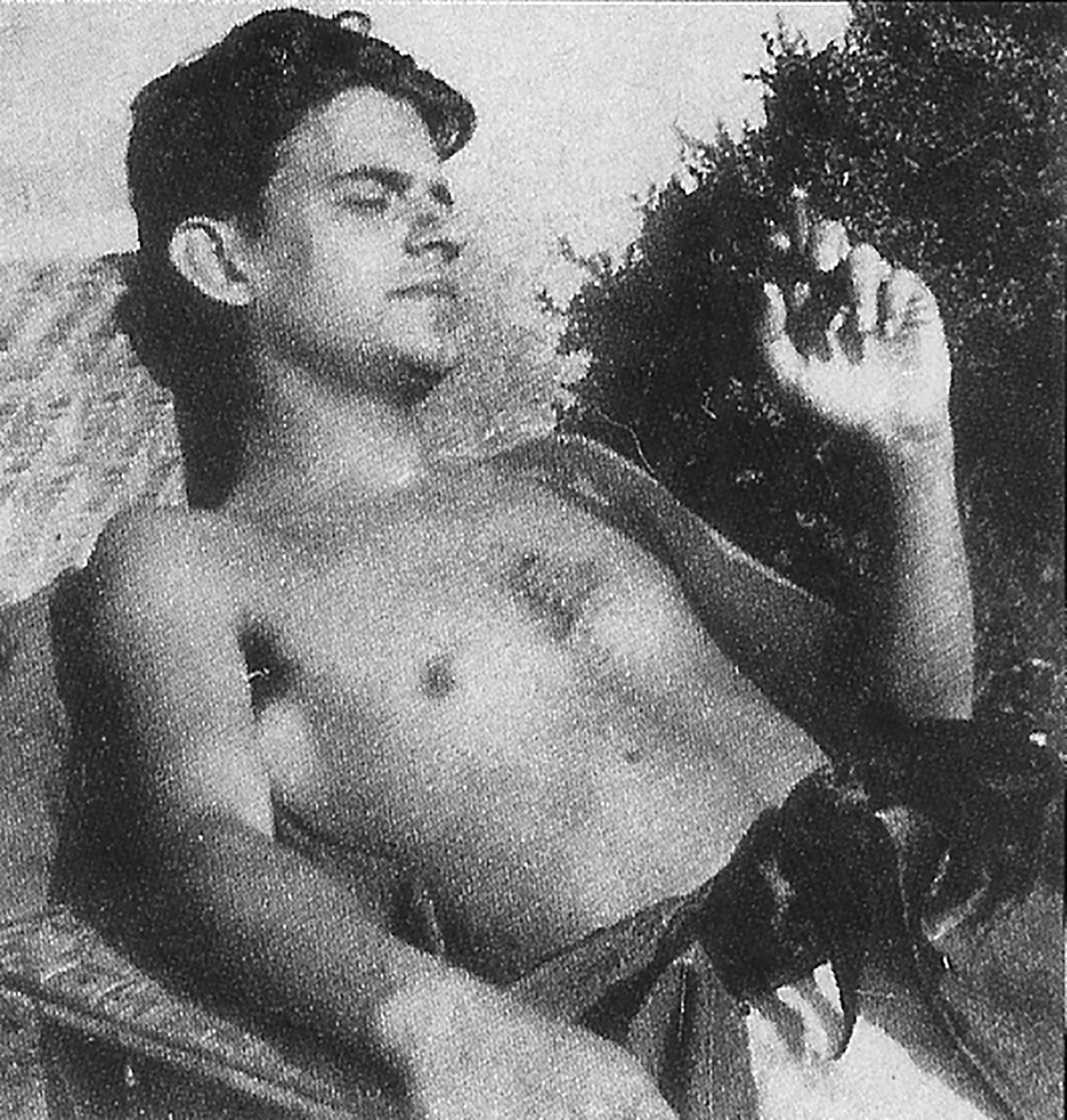
Jacques Lacan (1901 – 1981)
Christian Jambet explained how the real is “nothing”, but gets its subjective significance from knots with the imaginary and the symbolic register of the individual Subject: “Le nœud était là pour essayer de transmettre, pas simplement le réel comme vérité ou le réel comme indicible, mais le réel comme ce qui est là dans sa plus grande nudité et sa plus grande insignifiance. La chute d’une ficelle et en même temps son enroulement. Qu’est-ce qui reste quand ça se défait ? Un rien. Et en même temps que ce rien forme la chose la plus complexe, c’est-à-dire tous ces nœuds du langage ont quoi nous sommes pris et qui tissent notre vie.” [French for: “The knot (Borromean) was there to try to transmit, not simply the Real as truth or the Real as unspeakable, but the real as what is there in its greatest nakedness and insignificance. The fall of a string and at the same time its knots. What remains when it unravels? A nothing, and at the same time this nothing forms the most complex thing, that is to say, all those knots of language that we are caught in and that weave our lives.”].
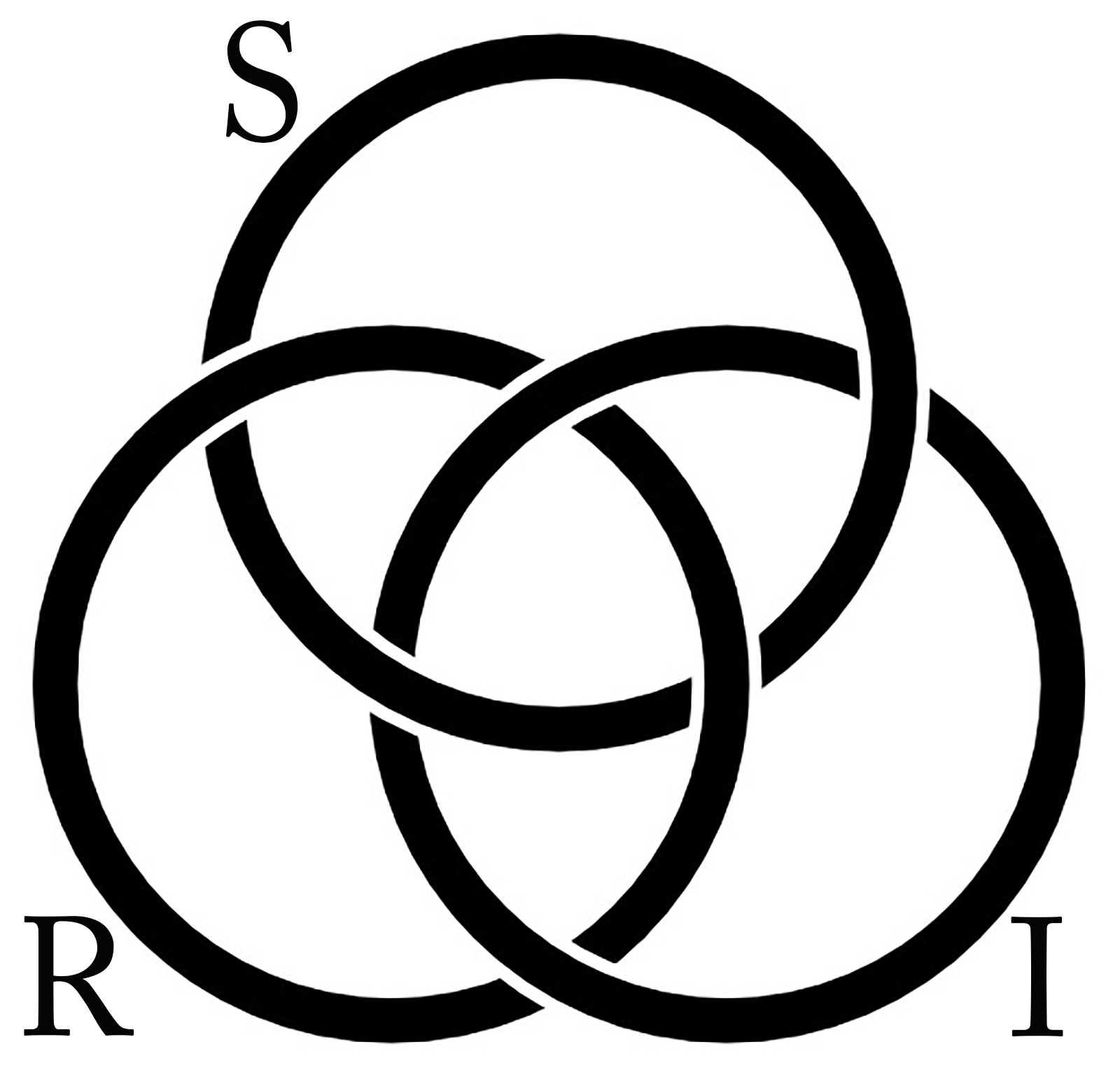
Le Noeud Borroméen (The Borromean Knot or Chain) / We could refer to this figure as a chain since it involves the interconnection of several different threads. Although a minimum of three threads or rings [Real, Imaginary & Symbolic] are required to form a Borromean chain, there is no maximum number; the chain may be extended indefinitely by adding further rings, while still preserving its Borromean quality
Secondly, we have the Imaginary register/order which is the domain of the formation of the Ego in the mirror stage by identification with the counterpart [or specular image, i.e. the little other (petit autre)] and this dual illusory relationship between the Ego and the counterpart is characterised by narcissism and alienation. Lacan also accused the major psychoanalytic schools of reducing psychoanalysis to the imaginary domain of the Ego. Although the imaginary is structured by the symbolic, the Imaginary register is the dimension of the human subject which is most closely linked to animal psychology; this means that in man’s imaginary, the relation has deviated from the realm of human nature and shifted to the realm of image and imagination, deception and lure [sexual behaviour is especially prone to the lure in animals, which is straightforward]. The principal illusions of the imaginary register are those of wholeness, synthesis, autonomy, duality and similarity, which is in fact untrue and deceptive. Jean Baudrillard, born in the peasantry, who eventually became one of the great names of post-modern philosophy, known for his analysis of modes of mediation and communication, proposed the concept of « simulacre » [simulacrum] and hyperreality. Although those are not connected to Lacan, they are great examples to show how the mainsteam masses are constantly living in an imaginary reality that Baudrillard called “hyperreality”; he argued that to the masses, the reality of our world at some point becomes indistinguishable from just a simple representation of it; that representation, or “simulacrum”, becomes completely detached from reality and ends up being an illusion that is perceived as truth by the average minds of the masses. The inability of the average minds to distinguish reality from the simulacrum is what Baudrillard referred to as “hyperreality” – a state of illusion he argued that the masses are constantly living in psychologically. The latter maintained that in the state the masses are made to live, there is no truth, only a simulacrum of it, and most fail to tell the difference. Like Chomsky, Baudrillard believed that a large amount of social ills can be attributed to the mainstream media, specially in the post-modern world with the constant 24-hour news cycle.

“Headline News” par Vladimír Takáč (2013)
The philosopher noted that the mainstream media is the chief perpetrator in the creation of hyperreality – the press, to Baudrillard, distorts the truth to fit its motive – and the average minds [lacking in self-reflective abilities] who are ignorant of the misrepresentation, accept the hyperreality generated by the simulacrum as the truth; this leads to an illusion far from reality that the average minds perceive as reality. Even the enigmatic Émile Zola concluded with an observation in the same line as Baudrillard, when in 1888, writing for Le Figaro littéraire he declared:
« Mon inquiétude unique, devant le journalisme actuel, c’est l’état de surexcitation nerveuse dans lequel in tient la nation
[…]
Aujourd’hui, remarquez quelle importance démesurée prend le moindre fait.
[…]
Quand une affaire est finie, une autre commence. Les journaux ne peuvent pas vivre sans cette existence de casse-cou. Si des sujets d’émotion manquent, ils en inventent. »
French for:
“My only concern with journalism today is the state of nervous overexcitement in which it holds the nation […] Today, notice the disproportionate importance of the smallest fact. […] When one case is over, another begins. Newspapers cannot live without this nerve-wracking existence. If there are no emotional topics, they have to invent them.”
– Émile Zola,
dans Le Figaro littéraire, 1888.
Being a figure of postmodern philosophy, in a state of hyperreality, truth to Baudrillard is hence a fluid concept that is more dependent on narrative, so any person can distort it – which clearly reveals its insignificance to individuals with self-reflective abilities.
For those who lack self-reflective abilities or have not developed them yet, it may be worth quoting Carl Jung, the psychoanalyst, who meticulously declared: “I am not what happened to me, I am what I chose to become.”

Traduction[EN]: “I am not what happens to me. I am what I choose to become.” – Carl Jung
The Imaginary register/order is where the Ego operates and also generates its own illusions. In a well adjusted psyche of the individual with self-reflective abilities, those illusions are synchronised with the Subject, the Symbolic and his/her desires.
Thirdly, we have the Symbolic register/order [which is constructed largely via language and discourse] and which is one of the aspects of the Subject that is revealed via the individual’s dreams. The Symbolic register is the fundamental cornerstone for Lacan; the Subject’s relationship with the Symbolic is at the heart of psychoanalysis. Psychoanalysts are essentially practitioners of the symbolic order [i.e. civilised culture and the symbolic are thus imposed on raw nature]. Lacan criticised the psychoanalysis of his day for ignoring the symbolic register and reducing everything to the imaginary order of the Ego, and this for Lacan is a betrayal of Freud’s most basic insights; “Freud’s discovery is that of the field of effects, in the nature of man, produced by his relationship to the symbolic order“. Lacan accurately pointed out that it is only by working in the Symbolic field that the psychoanalyst can produce changes in the subjective position of the patient and foster progress and growth.

« Si l’amour aspire au développement de l’être de l’autre, la haine veut le contraire, soit son abaissement, son déroutement, sa déviation, son délire, sa négation détaillée, sa subversion. C’est en cela que la haine, comme l’amour, est une carrière sans limite. » [French for: “If love aspires to the development of the other’s being, hatred wants the opposite, that is to say its abasement, its disruption, its deviation, its delirium, its detailed negation, its subversion. It is in this that hate, like love, is a career without limits.” – Jacques Lacan
We can feel the genuine ethics and sense of concern of Lacan towards positive change in the following declaration he made : « Si l’amour aspire au développement de l’être de l’autre, la haine veut le contraire, soit son abaissement, son déroutement, sa déviation, son délire, sa négation détaillée, sa subversion. C’est en cela que la haine, comme l’amour, est une carrière sans limite. » [French for: “If love aspires to the development of the other’s being, hatred wants the opposite, that is to say its abasement, its disruption, its deviation, its delirium, its detailed negation, its subversion. It is in this that hate, like love, is a career without limits.”].
The symbolic changes orchestrated by the psychoanalyst will also structure the illusions produced by the Ego [le “Moi”] in the Imaginary order, since the Imaginary is influenced by the Symbolic. As Elisabeth Roudinesco pointed out: “ces illusions existent, elles forment notre psychisme ; nous vivons dans un monde d’illusions, de représentations et qui nous marque à vie et qui resterons d’ailleurs” [French for: “these illusions exist, they form our psyche; we live in a world of illusions, of representations and which marks us for life and will remain so for the future…“].
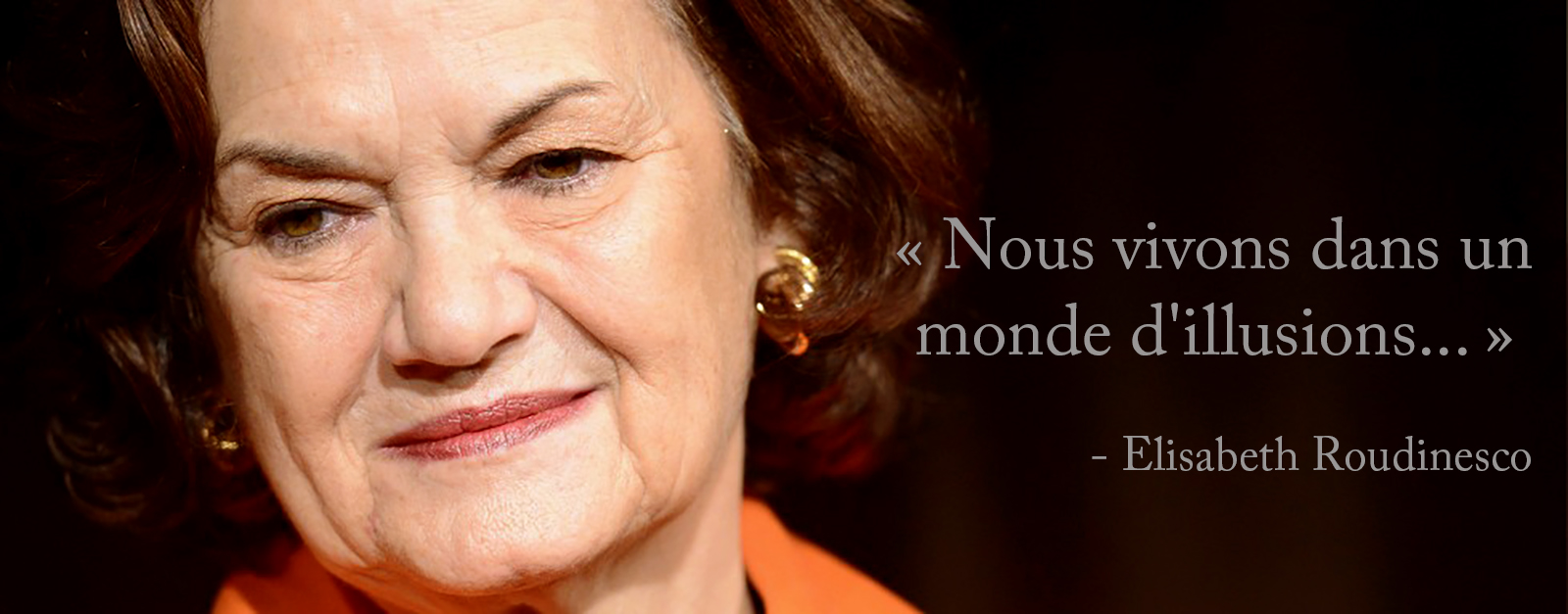
“We live in a world of illusions…” -Elisabeth Roudinesco, 2001
Hence, a well adjusted psyche will allow the Subject to generate the appropriate illusions in the imaginary register of the Ego [Le Moi] that are synchronized with the true Subject [i.e. true product of the Symbolic register tied by language(s)] and his/her desires which has its roots in and is structured by the “scene” [i.e. NOT physical or anatomical locality, but PSYCHICAL locality] of the Other [i.e. Big Other/Grand Autre/Superego] where language(s) and discourse originate. The well adjusted Imaginary of the Ego [le Moi] reflects the individual’s desires and unique personality, and contributes to growth since it allows the Subject to imagine creatively while regulating the wild desires of the Unconscious [ID / It / Ça / Inconscient] according to the symbolic laws of the Big Other [i.e. Grand Autre / Superego under the ID]. The balance between these 3 domains [ID – Superego – Ego] differs from one individual to the other leading to differences in personality.
Structural components [or registers/orders] of the Subject that are revealed via dreams are the Imaginary and the Real. Lacan argued that the psychanalyst’s interpretation of dreams can be viewed as analogous to a linguist’s translation of a language, unearthing the meaning that particular symbols hold for an individual [e.g. a client in psychotherapy or an individual seeking psychoanalytic guidance to enhance themselves]. Lacan noted that a specific difficulty that arises when psychoanalysts interpret the content of clients’ dreams is that, by the time the clients have awakened a large portion [if not most or all] of the dream has vanished, and this can be problematic if clients are reflecting on dreams that they experienced several year (decades?) ago. According to Lacanian Theory, Marder (2013) noted that dreams are oriented towards future interpretation, by dreamers themselves or by someone else (e.g. Psychoanalysts). Hence, truly important content are likely to survive clients’ transition from sleeping to waking states.
Lacan also pointed out as Stockholder (1998) noted, that Freud’s (1923) Structural model, i.e. the later version of his Psychoanalytic Theory with its dictinctions among Id, Super-Ego and Ego had distorded the true meaning of the first Topographic Model. And perhaps rightly observed, since the Ego which was meant to be conscious, revealed an unconscious element in its ability to instantly generate defence mechanisms outside the awareness of the patient, when before the function of the Ego was just one component present in the Conscious, i.e. the Ego [le Moi], was a part of the “Conscious”, as a level of consciousness and not assumed to be a distinct mental functions as part of the new 3 part dissection [ID, SuperEgo and Ego]. However, they can be synthesised and enhanced, as we are doing with Freud, Jung and Lacan along with other discoveries in the realms of Neuroscience and Cognitive-Psychology to explore the psychology of the singular organism and its powers of definition to a level that no other psychologist has attempted to before our endeavour.
Lacan’s theory relocates the ID [Ça / L’Inconscient / Symbolic], Super-Ego [Surmoi, Le grand Autre: the big Other / Symbolic] and the Ego [Moi / Imaginary order] across the Unconscious, Preconscious and Conscious.
The Subject: Uniqueness in the speaking being, le parlêtre
Although psychoanalytic praxis has powerful effects on the ego, it is the Subject, and not the ego, on which psychoanalysis primarily operates. Different from the ego, the Subject is a product of the symbolic Grand Autre, i.e. the “Big Other” [Superego under the influence of the ID]. The Subject means no more than “human being” and in 1953 Lacan establishes a clear distinction between the Subject and the Ego which remained a one of the most fundamental distinctions in his work. Whereas the Ego is part of the imaginary order, the Subject is part of the symbolic.
Lacan distinguished between 3 kinds of subject. Firstly, we have the impersonal subject, independent of the other, the pure grammatical subject, the noetic subject, the “it” of “it is known that”. Secondly, we have the anonymous reciprocal subject who recognises himself in equivalence with the other (ego reflection / petit autre / little other). Thirdly and finally, we have the personal subject in his uniqueness completely constituted by the act of self-affirmation. It is the third sense of the term subject, i.e. the personal subject in his uniqueness that constitutes the focus of Lacan’s work, and this also seems to be in line with our philosophy of construction and singularity in the creation of the individual. Lacan’s subject is the “subject of the unconscious”, i.e. it is a product of the expression of the unconscious through the symbolic “Grand Autre” [Superego]. Lacan argues that this distinction can be traced back to Freud: “[Freud] wrote Das Ich und das Es in order to maintain this fundamental distinction between the true Subject of the unconscious and the Ego as constituted in its nucleus by a series of alienating identifications. A complex and unique domain such as the subject should not be objectified or reduced to a thing; “What do we call a subject? Quite precisely, what in the development of objectivation, is outside of the object.” References to language come to dominate Lacan’s concept of the subject from the mid-1950s on; as he famously declared: « Pour libérer sa parole, le sujet est introduit, par la psychanalyse, au langage de son désir. » [French for: “To free his speech, the subject is introduced, through psychoanalysis, to the language of his desire”]
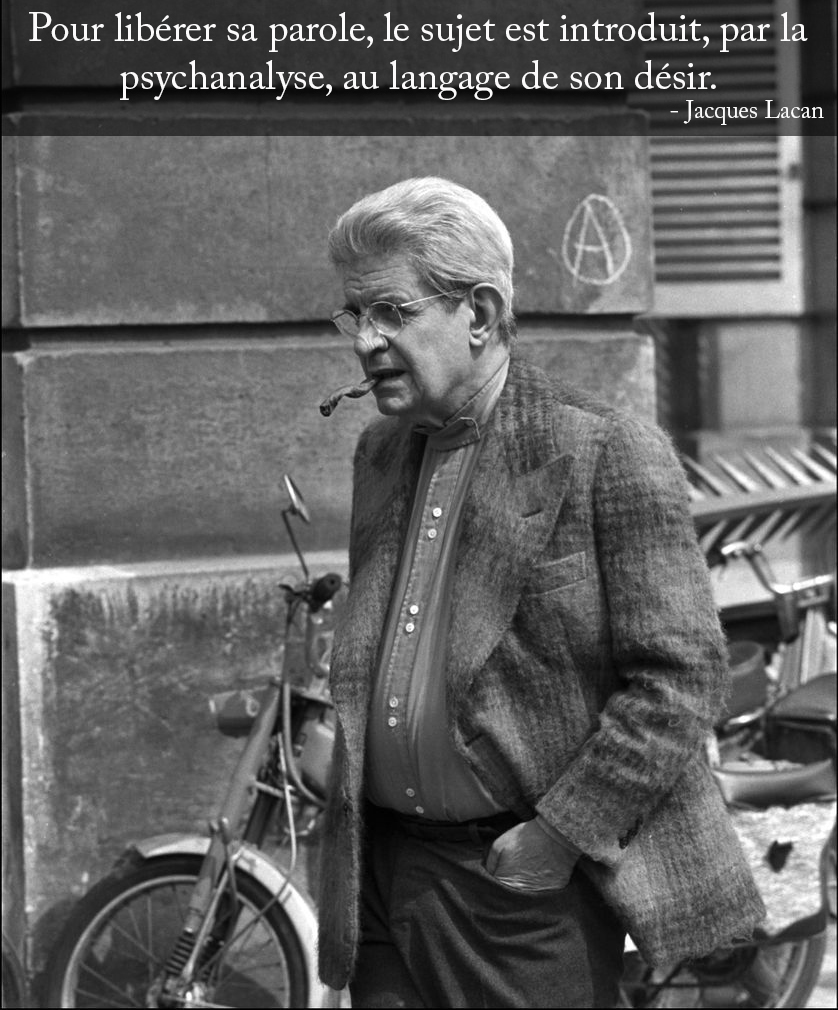
Traduction(EN): “To free his speech, the subject is introduced, through psychoanalysis, to the language of his desire.” – Jacques Lacan
It is very important however to distinguish the term “language” when reading the translations of Lacan’s work in English since the inexistence of some words in English make the translation from French inaccurate. Most importantly, in the French language we have two terms that both translate to “language” in English, those are the French terms “langue” [which refers a specific language, e.g. French or English] and “langage” [which refers to the prosody, expressive, grammatical and communicative structure of the language being used, the discourse of a particular Subject from any “langue” (specific language) since all “langues” (specific languages) come with different levels of structure, being a universal feature], it is the latter term “langage” referring to the general structure of the communicative pattern and linguistic discourse and not “langue” that is of interest to Lacanian psychoanalysis, i.e. the content of the discourse. So, it is important to note that in English, the term “language” in Lacan’s writings most often refers to the French term “langage” [i.e. the structure and content of the communicative pattern or discourse] and not “langue”. Linguistic discourse (le langage) is a single paradigm of all structures and the basic units are the signifier; the unconscious is a treasury of signifiers in the Symbolic structured like language that finds expression to define the Subject where discourse becomes a social bond. Lacan distinguishes the Subject of the enunciation [i.e. how words are pronounced] from the Subject of the statement [i.e. the genuine message of the discourse] to show that because the Subject is essentially a speaking being (parlêtre), he/she is inescapably divided [i.e. by different forms of communicative patterns]. Language is a constantly evolving domain and not a nomenclature [i.e. not complete, sealed, strictly and methodically organised], beyond its use for conveying information, language is foremost an appeal to an interlocutor. In the early 1960s Lacan defines the subject as that which is represented by a signifier for another signifier; in other words, the subject is an effect of language and in philosophical “discourse” it denotes an individual self-consciousness; linguistic discourse is a mediating element that allows the Subject to attain his desired recognition from others [i.e. the rest of humanity] while creating a social bond; this perfectly illustrates Lacan’s thesis about the determination of consciousness by the Symbolic register. “The subject is a subject only by virtue of his subjection to the field of the Other [Grand Autre / Big Other / Superego / from the Symbolic register].”The philosophical connotations of the term “Subject” are particularly emphasised by Lacan, who links it with Descartes’s philosophy of the cogito: « Je pense donc que je suis » [I think therefore, I am] – “in the term subject . . . I am not designating the living substratum needed by this phenomenon of the subject, nor any sort of substance, nor any being possessing knowledge in his pathos . . . nor even some incarnated logos, but the Cartesian subject, who appears at the moment when doubt is recognised as certainty.” The fact that the symbol of the subject, S, is a homophone of the Freud’s term Es (‘Id’) illustrates that for Lacan, the true subject is the subject of the unconscious [i.e. the impact of the expression of the instincts and language of the unconscious through the SuperEgo/Big Other/Grand Autre on the subject and ego – which differs in individuals. Lacan forced us to admit that we all have mental automatism. We all have, deep inside us, this inner voice that will inhabit the language [or languages] with which we will speak. Perhaps a good example of the expression of the unconscious inner voice is through music, which Lacan saw as a fundamental language of our unconscious thoughts, and therefore the bearer of an enigmatic knowledge, i.e. a form of language that would therefore have a meaning, corresponding for example to that of the different emotions that satisfy the various states of mind and that possibly supports an imaginary form of communication]. In 1957 Lacan strikes through this symbol to produce the symbol $, the “barred subject,” thus illustrating the fact that the subject is essentially divided; the division of the subject by different forms of communicative patterns.

Déssins: “Niklos Koda” par Olivier Grenson & “Mort et Déterré” par Jocelyn Boisvert et Pascal Colpron
L’Autre [Grand Autre / Big Other / Superego] as an early form of conscience from the Symbolic order/register & the mysterious origins and social bond of language [Speech / Linguistic discourse]
Lacan distinguishes between the Superego and the ego-ideal and argues that in most cases the primary function of the Superego is to repress sexual desire for the mother or mother figure in the resolution of the child’s early Oedipus complex and following Freud he also argues that the Superego is an early form of conscience that develops from the Oedipal identification with the father but also incorporates the maternal origins of an archaic form of the superego [conscience] derived from Melanie Klein’s thesis. Hence, Lacan proposed that in most people, the Oedipus complex is a process which imposes Symbolic structures on sexuality and allows the Subject to emerge – the imposition of culture on nature. When Lacan returned to the subject of the Superego [Grand Autre / Big Other] in his 1953-4 seminar, he located it in the symbolic order, as opposed to the imaginary order of the ego: the superego [i.e. Grand Autre] is essentially located within the symbolic plane of speech and has a close relationship with the “law” [law here does not refer to a particular piece of legislation, but to the fundamental principles which underlie social relations, i.e. a set of universal principles which makes social existence possible, the structures that govern social exchange, for e.g. gift giving or the formaton of pacts. Since the most basic form of exchange is communication [e.g. the exchange of words, the gift of speech], the symbolic “law” is fundamentally a linguistic entity/dimension, it is the law of the signifier. This law then is revealed with an order of language – the symbolic order itself. Lacan argues that the “law” is human because it separates man from other animals by regulating sexual relations that are among animals, unregulated. It is the law of the pleasure principle which commands the subject to “Enjoy as little as possible” and maintains the subject at a safe distance from the “Thing” (the forbidden object of desire), making the subject circle round it without ever attaining it because if the subject transgresses, it is experienced as suffering/evil – it is fortunate then that the thing is usually inaccessible and/or out of direct reach; the thing is impossible to imagine, it is unknowable and beyond symbolisation]. The “law” as such is a symbolic structure which regulates subjectivity and in this sense prevents disintegration of the wholeness of the individual’s psyche. The law of the superego however is believed to have a senseless and blind character of pure imperativeness and simple tyranny, so it is at one and the same time the law and its destruction, the Superego [only partially conscious] is thus the “big Other” which imposes a purely oppressive morality on the neurotic subject but also the will-to-enjoy and is related to the voice. The big “Other” must be considered a locus in which speech is constituted, it is thus only possible to speak of the “big Other” as a subject in a secondary sense where a psychoanalyst may occupy this position and thereby “embody” the “Big Other” for a patient / analysand.
In arguing that speech originates not in the Ego or even in the Subject, but in the partially unconscious “Other” [i.e. Big Other / Grand Autre / Superego], Lacan is stressing that speech and language are beyond conscious control, they come from an other place/scene [i.e. psychical localities], outside consciousness, and hence “the unconscious is the discourse of the big Other” [i.e. the effect on the subject of speech that is addressed to that subject from elsewhere, by another subject (forgotten or unknown) from another “scene”, i.e. psychical locality] and belongs wholly to the symbolic order. As Christian Jambet pointed out, this means that the fragments of discourse that the individual will articulate has its roots in the big Other’s scene(s) [i.e. NOT physical or anatomical locality, BUT PSYCHICAL localities], which is precisely the treasure of signifiers where language – which is very real – is structured, along with the individual’s desires. In 1969, Lacan begins to use the term “discourse“ to denote a “social bond” founded in language; an incredibly rational observation because there is nothing more social than language – the vital ingredient in any form of social activity. [Note: This leads to individuals not sharing anything in common with others in their direct geographical environment, because different individuals will be connected to different psychical localities.]

Gillett (2001) noted that, in Lacan’s view, language does not perfectly convey individuals’ desire to other persons, partly because individuals do not fully understand their own desire, and partly because language is an inherently social medium that can lead to misunderstanding as well as understanding between individuals and other persons. Language however is a very powerful social medium [as can be seen also from the essay, The Concept of Self]

Traduction(EN): « There will always be something special about language because language creates reality. Language reveals the truth of the subject and adds to reality what was not there before. Hence, the difference between truth and reality is that truth adds to reality what was not there before. Empiricists who study traits should never forget that constructs would not exist if they had not first been created through language. Hence language, creates reality! » -D.J. d’Purb
Jacques Lacan saw the unconscious [ID / Le Ça] as a structure of language whose formal logic unfolds in the manner of a Bach flute or a poem by Mallarmé and argued that the unconscious is structured like language. In the unconscious [i.e. the place where the treasure of signifiers is] as well as in the acquisition of language, individuals may follow rules regarding the use of symbols without having deliberately learned [and without having overtly been taught] those rules [something “special” and even “mystical” about language]. In addition the unconscious [like language] is regarded as a “network of signifiers”, a history of signifiers that shape the subject; the term signifier (le significant) referring to any symbol that is used [on its own, or in combination with other symbols] to stand in for, or to represent, something else [the signified – le signifié]. In conceiving the “big Other” as a place/scene, Lacan alludes to Freud’s concept of not physical or anatomical locality, but “psychical locality“, in which the unconscious is described as “the other scene”. In Lacanian terms the “other scene” is the big Other. The term “scene” was used by Lacan to denote the imaginary but also symbolic theatre in which the Subject plays out his fantasy; a fantasy which is however firmly built on the edifice of the Real [i.e. the world] and shaped by the symbolic order. The scene of fantasy is a virtual space which is framed, similarly to the scene of a play which is framed by the proscenium arch in a theatre, whereas beyond the frame lies the “real” space where the world is. Lacan uses the notion of “scene” to distinguish between 2 processes: (i) Acting out, and (ii) Passing to the Act. Since, the scene is symbolic and built on the real, the process of “Acting Out” takes place within the frame, i.e. inside the scene and is inscribed in the symbolic order; whereas the process of “Passing to the Act” is an exit from the scene, a crossing over from the symbolic into the real. It is highly likely that the impact of the arts, education, exposure and personal development has an important role to play in the development of the partially unconscious “big Others” and “the other scene”. The greatest child psychologist of all time, Jean Piaget argued that all forms of social interaction [which also includes artistic exposure] in the process of learning play an important role in « cognitive growth ».

[FR] Au XXIe siècle, les industries des arts, de la culture et de l’éducation s’appuient principalement sur les médias numériques pour toucher des clients dans le monde entier / [EN] The industries of the arts, culture and education in the 21st century, mainly rely on digital outlets to reach customers across the planet
This also leads to the important question of the “use” of art. Art is a very lucrative business in the 21st century with the wide range of outlets available digitally to deliver the works to the consumer/audience; but what are we consuming? What is the effect that we look for when we fully process the artworks that we choose? What happens after complete psychical digestion by the different psyches among us? Art is used to mark history, to leave a trace, not of the events, but of the line of thought of those living at the time it is focusing on. Back to the fundamentals of philosophy, the famous quote “je pense donc je suis” [French for: “I think therefore I am”] from Descartes explains to us that man is gifted with a conscience unlike animals. It is because we are organisms with the ability to think that we are human beings. Spinoza argued that we all have a conatus, an identity that is unique to each of us; the horse runs, the human being thinks. It is hence essential to question oneself, to meditate on a particular topic or another in order to blossom and thrive as human beings. Art is praxis, like philosophy it is an activity that produces no added value and has no other purpose other than the “perfecting of the agent” as Aristotle put it – it is an activity that allows for this work of reflective meditation. In this sense, a painting cannot be considered as a mere decoration as it is not a question of finding it “beautiful” or “ugly”, but it implies a work of reflection and a particular mental visualisation. Of course, art does not speak to everyone. Serge Gainsbourg pointed out that we have 2 types of art: major and minor ones. Major art forms are those that only the trained mind can understand: architecture, painting, the classics and poetry; For example, this piece by the French philosopher and winner of the 1927 Nobel Prize in literature, Henri Bergson ( – ):
« L’état suprême de la beauté, c’est la grâce. Or, dans le mot grâce, on entend aussi la bonté. Car la bonté, c’est la générosité d’un principe de Vie qui se donne indéfiniment. »
– Henri Bergson
Then we have the Minor art forms, which are those that speak to everyone. It is obviously difficult to perceive, interpret and explore the knowledge, layers of meaning and wisdom in artistic literary compositions if we do not have a good vocabulary and a deep understanding of literary voice [i.e. tone and mood], linguistic style [i.e. Imagery, Simile, Metaphor, Personification] and aural imagery [i.e. Alliteration, Assonance and Onomatopoeia] ; similarly it would be hard to understand all the hard work behind the construction of a cathedral if we do not have any understanding of architecture, although nothing prevents us from appreciating its grandeur and contemplating it at length; this is also applicable to painting which is linked to a profound understanding of scales, light, reflections, shadows, colours, paints, textures and brush strokes. Going by Metry Sephora’s straightforward way to understand a work of art, we can firstly ask ourselves what it is about; what is the painter presenting to us? What do we see in the distance? Secondly, how is it all represented? [Techniques, colours, materials, movements] What do we see from up close and what feelings are elicited? Thirdly, it is about the moment the art work mirrors us. Sometimes we are already touched and are able to evade by imagining the setting presented to us, we reminisce about moments experienced and we reflect on a particular topic. In some other cases, the art work does not touch us and we have to question ourselves deeper, through the life of the artist; why did the artist represent this? What was going on in his/her life at that particular time? In what context did he/she realise it? What was the train of thought of the time?
![Les Fenêtres [Windows] par Robert_Delaunay (1912)](https://dannydpurb.files.wordpress.com/2018/11/les-fenc3aatres-windows-par-robert_delaunay-1912.jpg)
“La Fenêtre” par Robert Delaunay. 1912 [de la série “Les Fenêtres”] / Musée de Grenoble
The above painting is “La Fenêtre” [The Window]” by the French painter Robert Delaunay (1885 – 1941) completed between 1911 and 1912 which is part of the series, “Les Fenêtres [Windows]“, which include 13 paintings inspired by the reading of “La loi du contraste simultané des couleurs” written in 1839 by Gustave Chevreuil; we know that the Delaunays created a cultural movement on their own and Blaise Cendrars (1887 – 1961) and Guillaume Appolinaire (1880 – 1918) were great admirers of their work which is part of the Cubist movement. This painting also inspired Apollinaire for his poem also entitled “Les Fenêtres” [Windows] where the writer tried to create a simultaneity between words as Delaunay does with colours. The painter seeks the original essence of colour, while the poet seeks the original essence of words. If we were to analyse this work, we could first observe the mixture and contrast of colours, it is not linear as a Mondrian art work, but still keeps a sense of organisation since the shapes do not spread in every direction, with different shades of blue and orange dominating the work. Secondly, we can conclude that it is rectangular and is a work of oil on canvas measuring 45.8 x 37.5 cm kept at the Musée de Grenoble and that the paint is smooth with movements executed naturally making it pleasant and relaxing to the eyes. Thirdly, based on the life of the painter we know that Robert Delaunay was part of a generation of avant-garde artists who were particularly prolific on the artistic scene between 1912 and 1914, representing the cubist and neo-impressionist movement, and that he was inspired by the scientific works of Chevreul on colours, by the work of Seurat and also that of Cézanne. At that time in the early 20th century, modern painting had tended towards abstraction, and in 1912 Apollinaire diagnosed the birth of a new pictoral art: “The new painters paint paintings where there is no longer a real subject”. By 1912, Delaunay had turned to orphism which led to the series of painting containing “La Fenêtre” [The Window]. More specifically orphic cubism had been distinguished from scientific cubism in 1912 by Apollinaire during the exposition of the Section d’Or, with the term orphism clearly linked to his poem “Orphée” (1908) which deals with pure poetry – a sort of “luminous language”. Another interpretation of this term is proposed: the name makes the analogy of the painting with music.
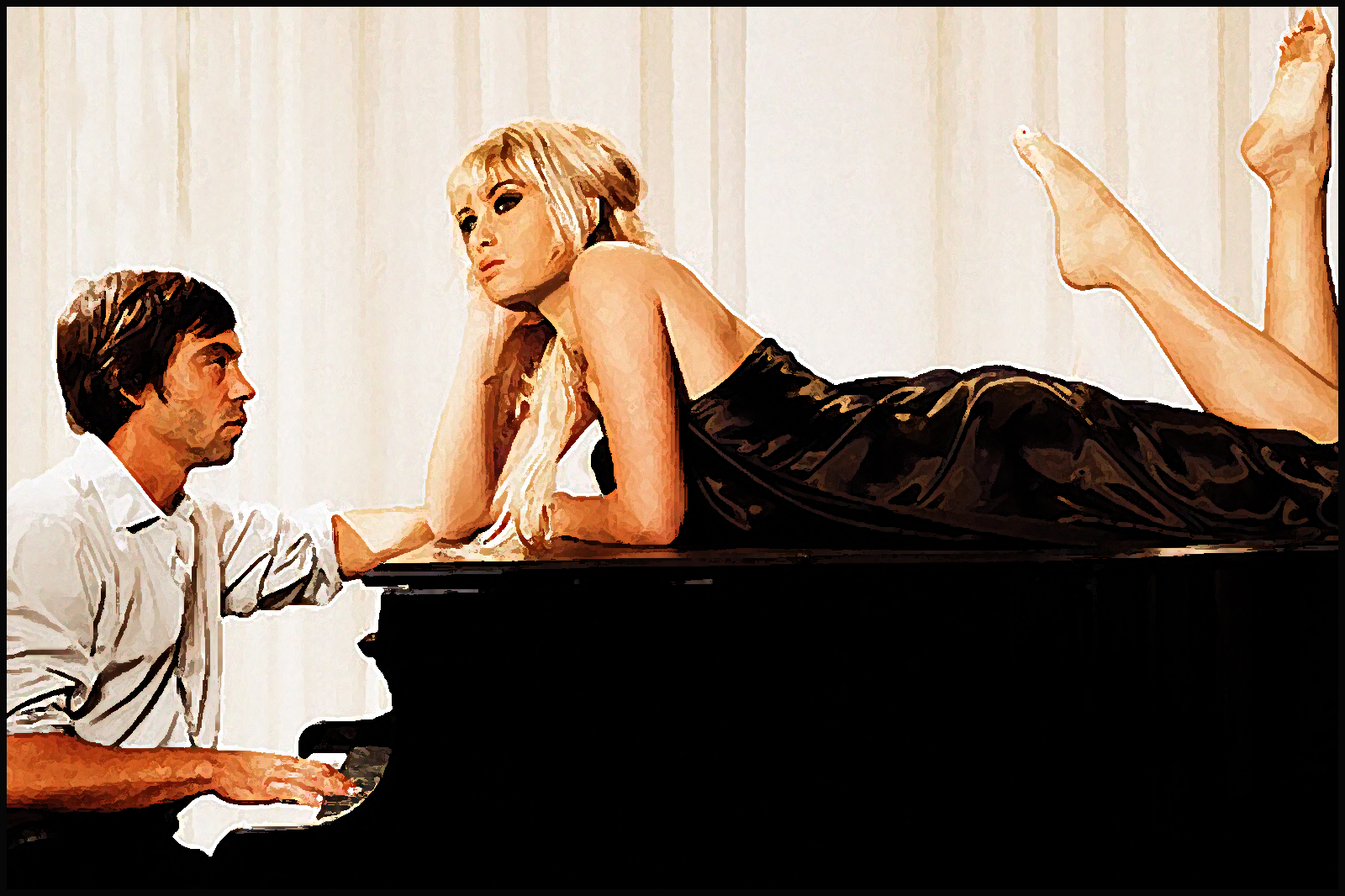
Indeed, at the start of the 20th century, music represented modern art par excellence, perfectly abstract, therefore pure as a universal art form, with a totalising function. Music could unite all the arts, as in Wagner’s operas with the concept of the Gesamtkunstwerk [i.e. A total work of art characterized by the simultaneous use of many media and artistic disciplines, and by the symbolic, philosophical or/and metaphysical significance it holds. This use stems from the desire to reflect the unity of life]. Robert Delaunay and his wife indeed created a cultural movement around them, through works concentrated on the arrangement of colours on the canvas seeking pictorial harmony. We all have a conatus, for some it is art, for others it is literature, drama and poetry, readers out there should perhaps try to find theirs?
So, getting back to the big Other [SuperEgo / Grand Autre], it is is always “lacking” something for the subject and the mythical complete and perfect Other does not seem to exist. In 1957, when Lacan introduces the algebraic symbol for the barred Other (A), lack comes to designate the lack of a signifier in the Other [It is Lack that causes Desire to arise]. Lacan introduces the symbol S(A) to designate “the signifier of a lack in the Other. [Note that Lacan uses the term “Grand Autre” with capital A which here is referred to as the “Other” with capital O, i.e. the “big Other” and not the “petit autre” which is the reflection or projection of the Ego [counterpart and specular image] in the imaginary order referred to as the “other” or “little other”, “o” “petit autre” “a”.]
Lacanian Terms: L’Inconscient [Id], L’Autre [Grand Autre/Big Other/Superego] & Le Moi [Ego: its birth and the Mirror Stage]
To clarify Lacanian terms, firstly, we have the “inconscient“; being the unconscious ID in the domain of the symbolic which is the unconscious origin of the individual’s discourse, the symbolic “it” or “Ça” beyond the imaginary ego: man is lived and spoken by the unconscious “it” or “Ça”. Hence the phrase which Lacan frequently uses when discussing the unconscious ID, “it speaks” (le “Ça” parle). Hence, Lacan argued that the concept of the unconscious was badly misunderstood by most of Freud’s followers who reduced it to being “merely the seat of instincts“, and against this simplistic biological mode of thought Lacan argued that the unconscious is not simply the seat of instincts but is also and primarily linguistic because we can only grasp the unconscious when it is explained and transformed into words. One should see in the unconscious the effects of speech on the subject, as it is the determination of the subject by the symbolic order. The unconscious is a kind of memory in the sense of a symbolic history of signifiers [i.e. a treasure chest full of signifiers where discourse originates] that have determined the subject in the course of his/her life. Psychoanalysis involves unearthing the meaning that particular symbols hold for an individual. What this seems to suggest is that the unconscious absorbs a wide range of signifiers (signifiants) [that symbolise something else, “le signifié” or “signified” in a deeper exploratory sense] throughout the subject’s life and these later find expression and guide desires through the Superego [Grand Autre / Big Other / the symbolic discourse of the unconscious] and in turn symbolically shapes the imaginary creations of the Ego [Moi] and define the Subject according to his abilities to achieve his desires – the outcome differs depending on the subject’s individual creativity and intelligence.
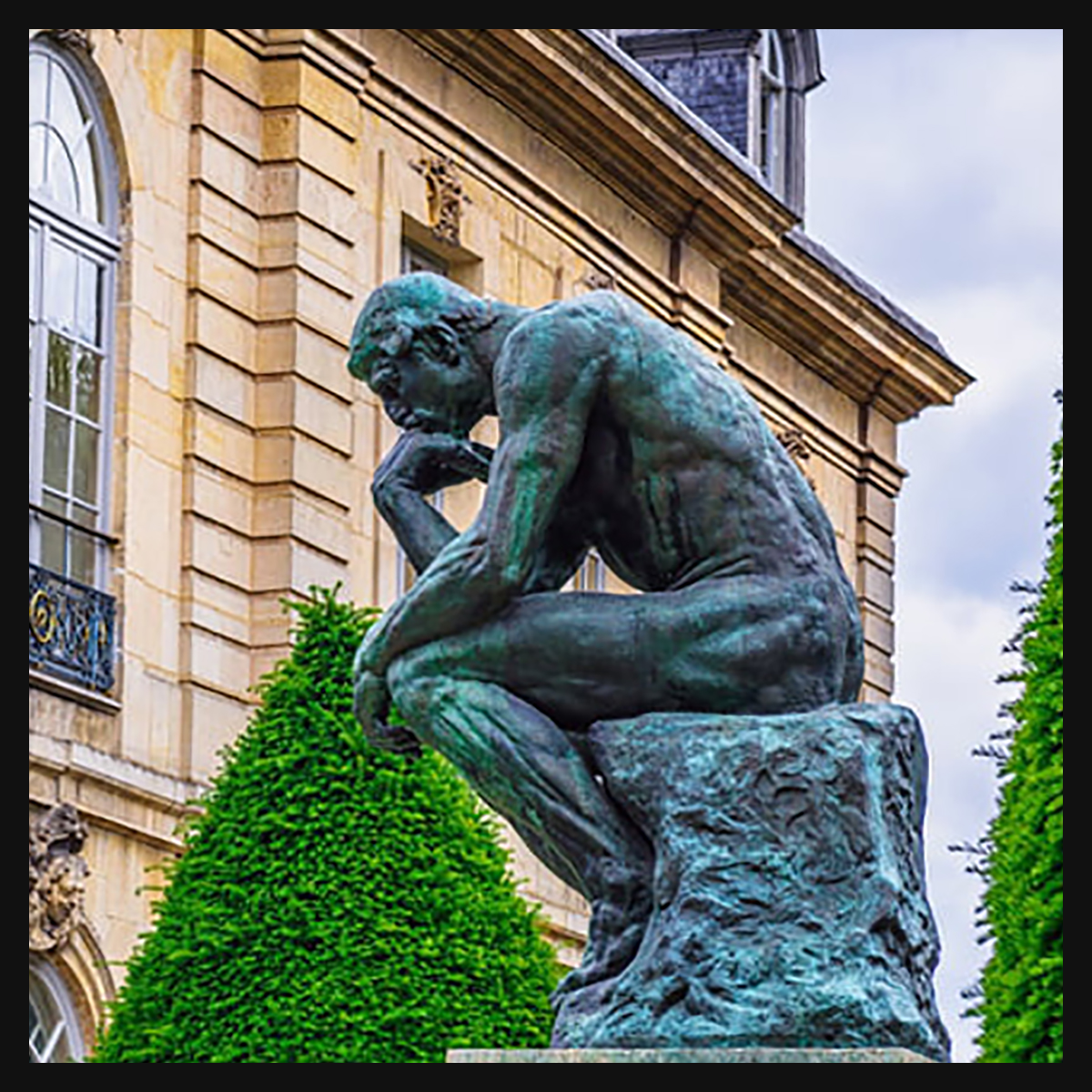
«Le Penseur» par Auguste Rodin (1882) représente un homme dans une réflexion profonde, semblant utiliser toute son intelligence pour résoudre un problème.
Since it is an articulation of signifiers in a signifying chain, the unconscious is a kind of knowledge (symbolic knowledge, or savoir) – an “unknown knowledge.” For the Cognitive-Behavioural mind, these signifiers may be considered as “stimuli” [received in different forms, e.g. visual, auditory, mental] however their reception and their responses are completely unconscious and generate effects in the depth of the mind [unconscious] that cannot be measured or seen [the nightmare of the empiricist]. Hence, the unconscious is the location of a chain of signifiers [that stand for something else in a signifying chain] that define the subject through the course of his/her life and where linguistic discourse originates.
We then have the “Moi”, which is the equivalent of the Ego, a formation in the imaginary order as opposed to the Subject [le parlêtre as explained above, which is the true product of the symbolic order]. The Ego is a méconnaissance [a failure to understand/recognise, which is also the structure of paranoiac delusions] of the Symbolic, the Ego is the seat of resistance and is structured like a symptom at the heart of the Subject, the human symptom par excellence, the mental illness of man. Méconnaissance is to be distinguished from ignorance: whereas ignorance is a passion for the absence of knowledge, méconnaissance is an imaginary misrecognition/misconstruction of a symbolic knowledge (savoir) that the Subject does possess somewhere. The structural homology between the ordinary constitution of the Ego and paranoiac delusions is what leads Lacan to describe all knowledge (connaissance), in both neurosis and psychosis, as “paranoiac knowledge.” Lacan also argued that the proponents of Ego-psychology betrayed Freud’s radical discovery by relocating the ego as the center of the subject. In opposition to this school of thought, Lacan maintains that the ego is not at the center, that the ego is in fact an object. ‘ The ego is a construction which is formed by identification with the specular image in the Mirror stage and is thus the place where the subject becomes alienated from himself, transforming himself into the counterpart. Malin (2011) pointed out that in Lacanian Theory, a major event in infants’ personality and social development is the mirror stage, when infants enter into language as a uniquely human form of interaction with all caregivers in the child’s environment [although infants are not likely to consciously experience language prior to age 2]. As Luepnitz (2009) noted, Lacan believed that infants often enter into language at a crucial point when they literally recognise themselves in a mirror, with caregivers [i.e. can include others such as teachers rather than direct parents] pointing to the reflection and approvingly saying to the infants, “Look, that’s you!” – even if infants are unlikely to remember the event in itself.
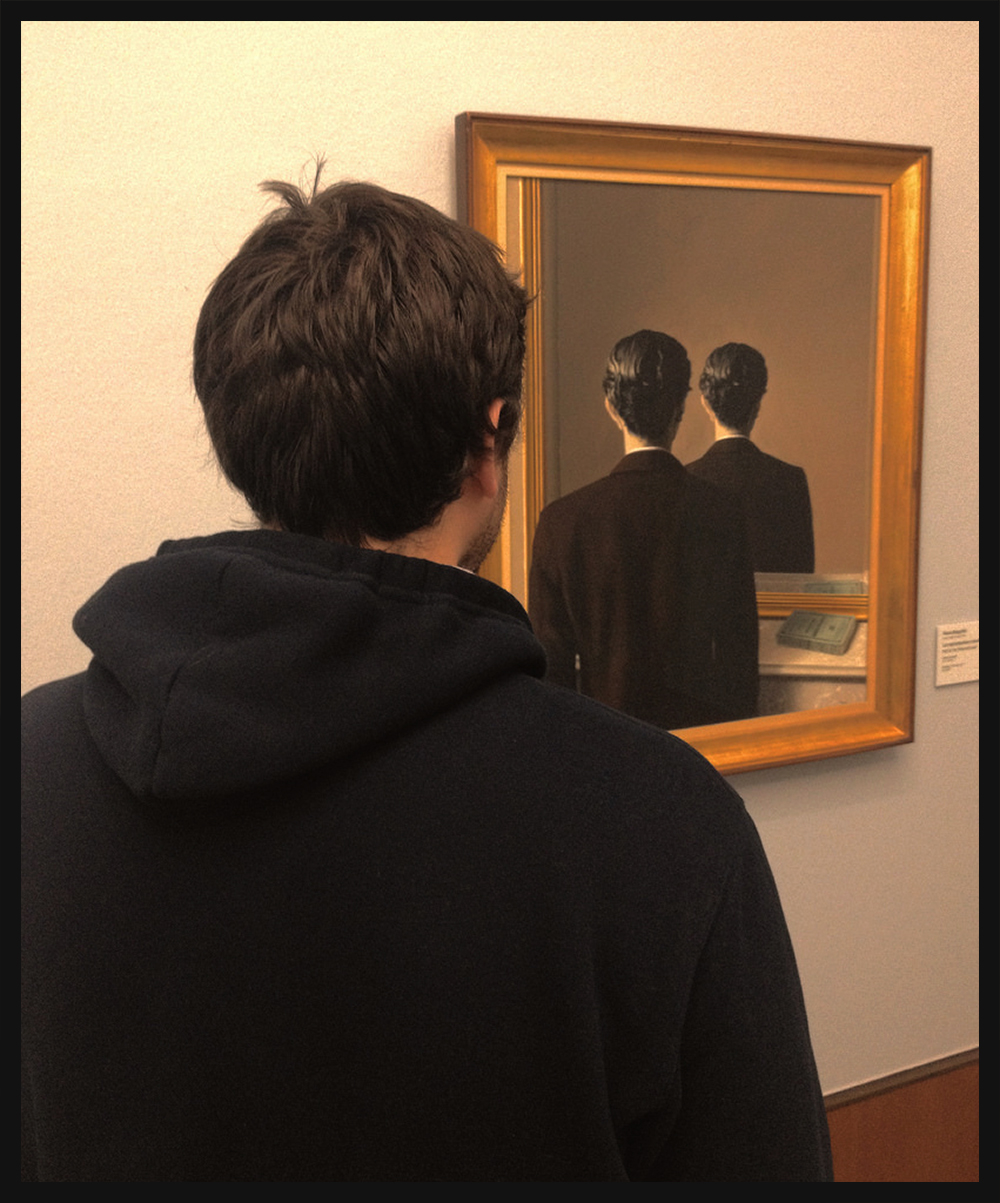
“Not to be reproduced” by René Magritte, 1937
And as Hivernel (2013) noted, the 2 major outcomes of the mirror stage are the emergence of the Subject, a product of the symbolic order (i.e., individuals’ gradual awareness regarding their uniqueness) and the others (i.e. individuals’ gradual awareness regarding the rest of humanity, to whom they are connected to varying degrees). The other major outcome of the mirror stage is the birth of the Ego [Le Moi, the imaginary formation], and infants may experience joy at this moment, which occurs (and, in fact, is necessary) before infants can truly understand the power of symbols in language. However, one of the unfortunate outcomes of the mirror stage was that infants gradually begin to look outward, and not inward in search for identity; and such external orientation toward individuals’ own identity is doomed to fail.

French for: “There is nothing besides yourself that can make you better, stronger, richer, faster or smarter. Everything is within you, everything exists. Do not look for anything outside yourself.” -Miyamoto Musashi
This seems to make perfect sense, even from the objective perspective that the Organic Theory of Psychical Construction, i.e., any organism whose reality or sense of it is based on the geographical mental conditioning of a group of organisms [about 4 or 5] will have a limited perspective of reality and lack a wider outlook of the world as it truly is. Unlike US Ego psychologists who considered the Ego as the dominant component that should be worked on and strengthened, Lacan argued against such irrational therapy because the ego is the “seat of illusions” and to increase its strength would only increase the subject’s alienation, the ego is the source of resistance to psychoanalytic treatment and strengthening it would increase those resistances [i.e. all obstacles that arise during psychoanalytic praxis and interrupt its progress, when the subject breaks the fundamental rule of saying everything that comes into his mind]. Lacan argued that the true goal of psychotherapy should be therapists’ unearthing the clients’ unconscious desire via the “talking cure” of psychoanalysis – not strengthening the Ego mindlessly, as this may leave individuals in a state of delusion without an Ego adjusted to their abilities – and may even lead to individuals allowing their Ego [imaginary moi] to dominate the Super-Ego [Grand Autre, Big Other] and favour irrational release of the ID’s [Inconscient / Ça] psychic energy without any remorse or rational control. Because of the imaginary fixity of the Ego, it is resistant to all subjective growth and change and to the dialectical movement of desire, hence, by undermining the fixity of the ego, psychoanalytic treatment aims to restore the dialectic of desire and reinitiate the “coming into being” of the Subject, a product of the Symbolic. This is in direct contrast to the Ego Psychologists’ perspective. Lacan criticised ego-psychology as practised in the US for confusing the concept of “Resistance” with that of “Defence”, and his distinction differs from Anglo-American psychoanalysis. Lacan explained that Defence is on the side of the subject whereas Resistance is on the side of the object. Defences are relatively stable symbolic structures of subjectivity while resistances are rather transitory [periodic / like a phase] forces which prevent the object from being absorbed in the signifying chain [of signifiers]. Resistance belongs to the “imaginary” order of the Ego and not to the symbolic level of the true Subject, because in the symbolic order of the Unconscious, there is no resistance, but only a tendency for repetition. Hence, resistances are “imaginary lures” of the Ego which the analyst must be wary of being deceived by. This is why Lacan maintained that the aim of analysis can never be to strengthen the Ego because this would increase imaginary resistances. Ego psychology shifted emphasis on overcoming the resistances of patients and this was heavily criticised by Lacan who thought that this lead to an “inquisitorial style” of psychoanalysis that sees resistances as based on the “fundamental ill will” of the patients, which is not always the case; this to Lacan overlooked the structural nature of resistance and reduces analysis to an imaginary dual relation. Lacan encourages the “analysis of resistances” but only on the condition that this phrase is properly understood, in the sense of “knowing at what level the answer should be pitched“; what Lacan means is that the crucial thing is that the psychoanalyst should be able to distinguish between interventions that are primarily oriented towards the Imaginary and those that are oriented towards the Symbolic and know which are appropriate at each moment during psychoanalytic praxis with patients. Lacan argued for “Structural Resistance”, which is not a question of ill will on the part of the patient but is a resistance that structures, and it is inherent in the analytic process. Resistance is due to a structural incompatibility between desire and human speech [i.e. discourse] and hence Lacan points out to a certain irreducible level of resistance which can never be overcome, that is, even after the reduction of resistances, there is a residue – which may be what is truly essential for a particular Subject. This irreducible “residue” is essential since it is respect for this residue by psychoanalysts that distinguishes true psychoanalysis from mere suggestion. Psychoanalysis to Lacan, respects the right of the patients to resist suggestion and indeed values that resistance. When the Subject’s resistance opposes suggestion, it is only a desire to maintain the Subject’s true desire, and as such it would have to be placed in the realm of “positive transference”. Lacan points out that while psychoanalysts cannot and should not try to overcome “all resistances”, they can minimise them or at least avoid exacerbating them. To do this, psychoanalysts could recognise their own part in the resistances of their patients since to Lacan, there is no other resistance to analysis than that of the analyst himself. The patient’s resistance is always that of the analyst, and when a resistance succeeds it is because the analyst is in it completely, i.e. because the analyst understands. Hence, the analyst should always follow the rule of neutrality; psychoanalytic treatment works on the principle that by not forcing the patient, resistance is reduced to the irreducible minimum, thus, analysts should avoid all forms of suggestion.
Finally, as already explained above, we have the “Grand Autre” or simply “Autre” [Capital A] or “Big Other” which is the preconscious Superego also in the domain of the symbolic register; being the discourse of the unconscious. The big “Other” designates an otherness that transcends the illusory otherness of the imaginary because it cannot be assimilated into the psyche through identification, Lacan equates the big “Other” with language and the “law” [i.e. the structures that govern social exchange] and hence the big “Other” is inscribed in the symbolic register, and indeed the big “Other” is symbolic because it differs for each subject and is the symbolic order which mediates the relationship with a particular subject. The little “other“ is a reflection or projection of the ego [le Moi], it is the counterpart and the specular image, unlike the “big Other” which is in the symbolic order, the little “other” is inscribed in the imaginary order of the Ego.
The concept of Adaptation and Psychoanalysts as the Grand Autre [Big Other / Superego]
Lacan also questioned whether the ego of the psychoanalyst gives the measure of reality to the patient in trying to adapt the latter. Because if so, this would turn the analyst [who are also different in terms of talent, creativity and vision from one person to another] into the arbitrer of the patient’s adaptation to reality, hence the analyst’s own understanding [or lack of understanding] of reality would be assumed to be absolute and perfect where he would be considered as the perfection of adaptation compared to the patient [as is the case in Ego-psychology practiced in the USA]. This to Lacan turns psychoanalysis as an exercise of power and social control where the analyst forces his own particular view of reality onto the patient and this is not psychoanalysis but suggestion. This Lacanian refusal to force an adaptation of the ego to reality is in direct opposition to the “Ego-psychology” of the US psychoanalytic movement that Lacan accused of wrongly reading the works of Freud. Lacan regards it as simple to understand why the adaptation theme was developed by European and Jewish psychoanalysts who had emigrated to the USA in the late 1930s, and this is simply because these analysts felt not only that they had to adapt to life in the USA, but also that they had to adapt psychoanalysis to American tastes [i.e. to fit the average american psyche]. One of Lacan’s fiercest criticism is based on the following argument: the notion of “adaptation to reality” is founded on the creatively irrational and naive empiricist epistemology that wrongly assumes an unproblematic notion of “reality” for all Subjects, as an objective and self-evident given, this discards what psychoanalysis has discovered about the construction of reality by the Ego on the basis of its own “méconnaissance” [i.e. subjective understanding of reality]. So when the analyst assumes that he is better adapted to the vague notion of “reality” than the patient, he has no other option but to fall back on his own Ego’s interpretation of reality, since it is the only “reality” he knows, this leads to the distorted and simplistic definition of “the part that thinks as we do” as being the healthy part of a Subject’s Ego. This practice of Ego-psychology turns psychoanalysis as an exercise of prepackaged suggestion to mould the psyche of individuals to these analysts’ own “idea” of reality in order to fit a simplistic mainstream model in line with the requirements of the mechanical philosophies of empiricist epistemology and industrialisation. The inability of the analyst to sustain a praxis authentically, as is usually the case, results in an exercise of power.
The simplistic biological concept of adaptation [as often assumed in simple deterministic animal psychology] can be problematic when applied to psychoanalysis since in evolutionary biology it is assumed that organisms/animals are driven to “adapt” themselves to fit their environment and hence implies a harmonious relation between the Innenwelt (inner world) and Umwelt (surrounding world). The observation of animals in nature or in laboratories tends to guide the reasoning of many empirical scientists who are simplistic and biologically oriented, it is important to ask a few questions. For example, which animals to focus on as models to be inspired by? In nature, we have many animals who mate for life and are monogamous [e.g. albatrosses, bald eagles, barn owls, penguins, beavers, shingleback skinks, gibbons (primates), wolves, swans & french angelfish]. On the other hand, we also have other animals such as common pheasants, lions, gorillas, tigers, red deers, elks, and hamadryas baboons (primates) who have a different mating system, where the fittest male mates with multiple females to ensure the constant enhancement and fitness of future generations; and hence are polygamous.
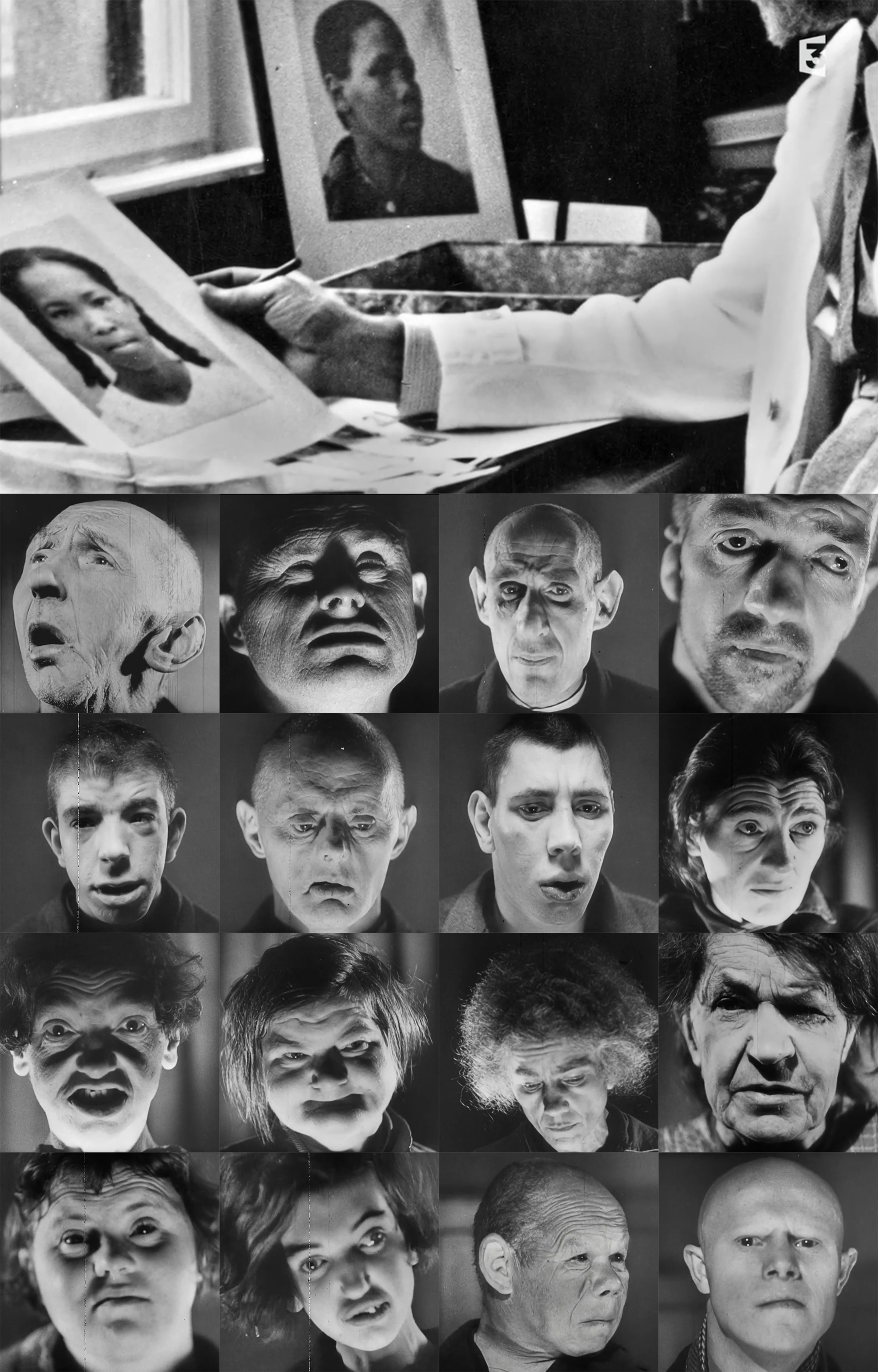
Image: Degenerates / Some controversial doctors under the Third Reich proposed that the curse of diseased genes destroy entire families, and that degenerates can only give birth to their similars. It lead to sterilisation that was supposed to prevent them from spreading their misery to innocent children [as the aim was a strong and genetically healthy people], and also the “Aktion T4” program which was mass involuntary euthanasia. Certain German physicians were authorised to select patients “deemed incurably sick, after most critical medical examination” and then administer to them a “mercy death” (Gnadentod). From September 1939 until the end of the war in 1945; from 275,000 to 300,000 people were euthanised in psychiatric hospitals in Germany and Austria, occupied Poland and the Protectorate of Bohemia and Moravia (now the Czech Republic). The Holy See announced on 2 December 1940 that the policy was contrary to the natural and positive Divine law and that “the direct killing of an innocent person because of mental or physical defects is not allowed” but the declaration was not upheld by some Catholic authorities in Germany. In the summer of 1941, protests were led in Germany by the Bishop of Münster, Clemens von Galen, whose intervention led to “the strongest, most explicit and most widespread protest movement against any policy since the beginning of the Third Reich”, according to historian Richard J. Evans.
Hence, this poses questions to the simplistic biological perspective of adaptation: should humans follow the latter polygamous animal model and select the fittest and smartest males through physical and intelligence tests and use their sperm to inseminate all women on earth desiring to have children [or vice-versa or in combination with the eggs of the fittest and smartest females to help couples conceive]; could this reduce malformations and other ugly diseases?
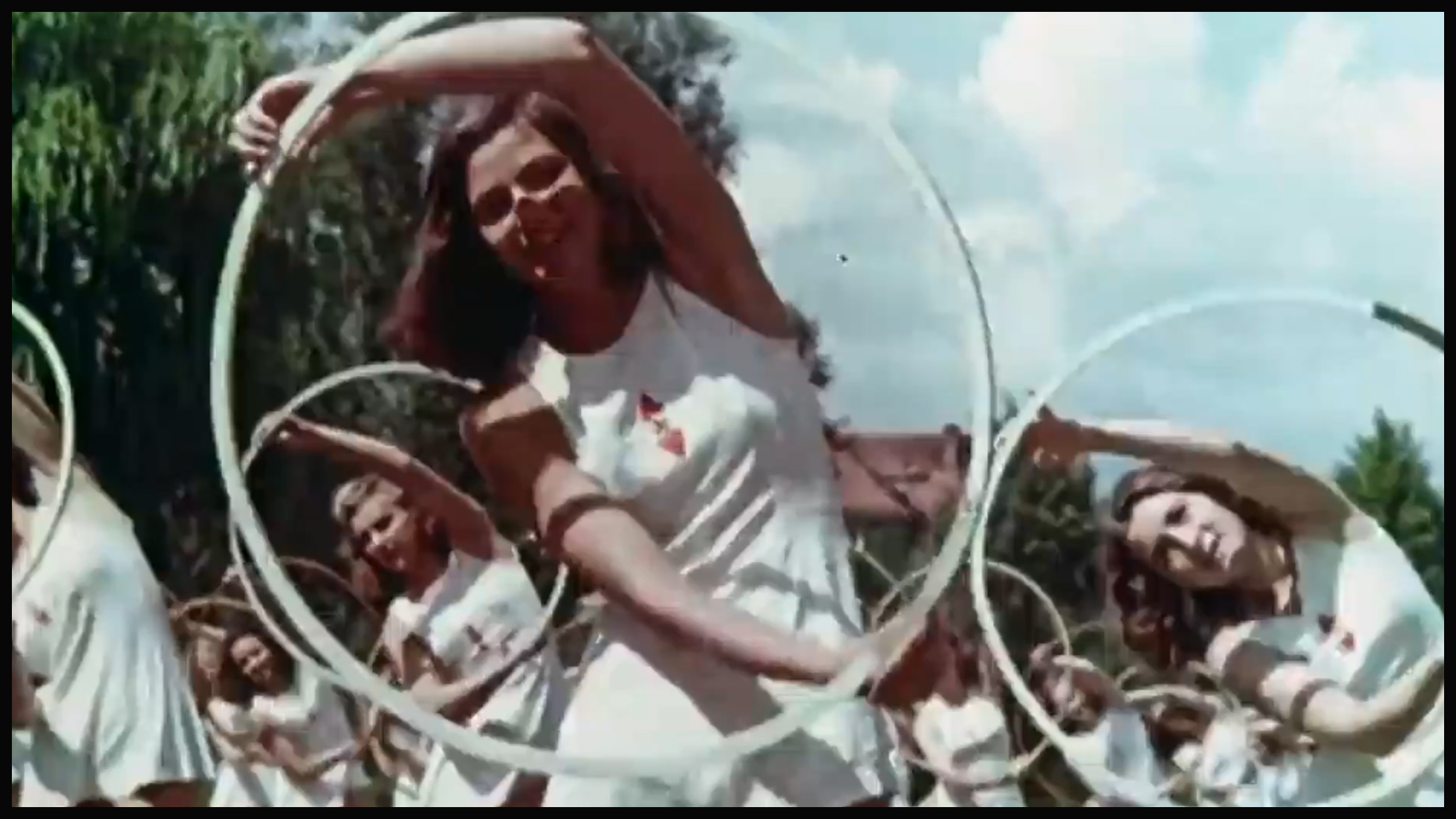
Image: Physically healthy females exercising
Or should we follow the monogamous model of the bald eagle, penguin, barn owl, swan, wolf and French angelfish? Based on our evolutionary history, it seems that we humans are monogamous by design due to the size of our brains that allow us to build sophisticated relationships and also experience complex emotions [that animals cannot due to the limited biological architecture of their brain that is optimised for survival and hunting], and hence, humans should not follow animals blindly but use some aspects that we may learn from the study of animals in nature with great precautions to help humans live a better life [for example: giving a choice of healthy sperm and egg donors to couples who cannot conceive or fear passing down incurable and other debilitating diseases] and gradually create a genetically healthy civilisation.
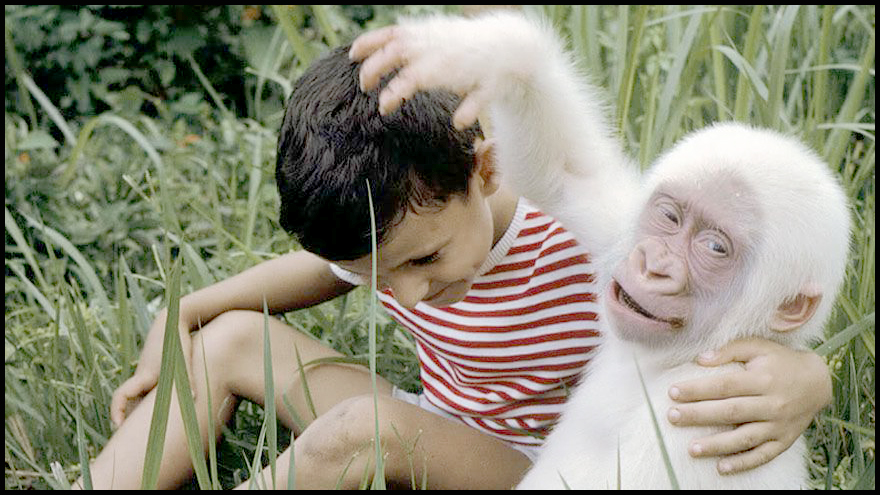
Image: Baby Albino Gorilla with his friend
François Rabelais, the french doctor, writer, monk & priest seems to have phrased it well in his magnum opus, Pantagruel (1694): “Science sans conscience n’est que ruine de l’âme.” [French for: « Science without conscience is nothing but the ruin of the soul »]
So, the idea of harmony between the inner world (Innenwelt) of the organism and its environment (Umwelt) which is implicit in the concept of adaptation from the simplistic biological perspective [e.g. in animal psychology] is innaplicable to human beings since man’s inscription in the symbolic order re-shapes and restrains his natural behaviours and instincts [i.e. because of civilised society and the sophisticated and multi-layered aspects of human life, man cannot allow himself to follow his wild instincts blindly as animals do in nature], and this means that “in man, the imaginary relation [to nature] has deviated” [the nurture VS nature debate]. This is different for all animal machines who tend to be strictly riveted to the conditions of the external environment, whereas in the human being we have a “certain biological gap”. So, compared to the simplistic biological perspective of animal adaptation where the organism follows its wild instincts and not human reasoning, we can suggest that humans are essentially “maladaptive animals” and this may well be for the betterment of our lives since we live in a sophisticated society and not in the wild nature (la nature sauvage) like animals, where meeting basic needs is a constant struggle in a matter of life and death.
Yet, adapting to the Umwelt (surrounding world) in human psychology is not the ultimate path of perfection because it is not designed to meet all of the true desires of human beings [as Freud suggested, intrapsychic conflict is inescapable because of the demands of society] and hence does not guarantee the complete satisfaction and enhancement of the individual [being highly complex beings with huge brains and different personalities that seek different goals], especially when the Umwelt (surrounding world) itself which is assumed to be “reality” is not a simple objective thing [such as for animals in nature] but is itself a product of the Ego’s fictional misrepresentations and projections. Therefore to Lacan it is not a question of adapting the Ego to reality, but of showing the imaginary “Ego” that it is only too well adapted since it assists in the construction of that very reality and hence the task of the psychoanalyst is rather to subvert the patient’s illusory sense of adaptation since it blocks access to the unconscious, and hence gain access to it. In 1955 Lacan states that “the dimension discovered by analysis is the opposite of anything which progresses through adaptation” and hence refused to explain human phenomena and mental life in terms of adaptation. To Lacan, and many inspired by his views, it is more about “adjusting” than adapting, i.e. adjusting to be functional in our chosen path/field based on our individual characteristics and abilities. Lacan maintained that psychoanalytic intervention should not aim to adapt the Ego to reality, and this seems reasonable since “reality” is a social construct under constant change as we primates are evolving and adapting to the discoveries of our constantly changing civilisation, but also because the Ego is an imaginary formation as opposed to the Subject which is the true product of the symbolic. To Lacan, psychoanalysts should adopt the role of the “big Other” [Grand Autre / Super-Ego] in therapeutic interventions as a counterpart to the client’s “Subject”, thus making it possible for clients to peer beneath their own conscious (typically not completely true narratives), into their unconscious (and “true”) desire(s) [and perhaps guide or help the patient to realise their dreams within the realms of reality in civilised society].
Lacan’s suggestion seems to give the individual the creative freedom to create himself through language and discourse, exist and be unique within the reasonable limits of a mentally adequate and healthy person, while only adjusting his behaviour to be able to function and exist in his chosen individual world without losing his individuality. Since reality and culture are social constructs that are always changing through collaboration, the individual can both be shaped by them and also shape them [for e.g. human culture teaches a child how to use a fork and a knife to eat, but it can also be shaped by an individual if he invents/discovers something or adopts a philosophy that affects/inspires human cultures. In the past smoking was allowed everywhere and it was common culture to see people and even doctors smoking in public buildings, but since we found about the harmful effects of cigarette smoke, today culture has been reshaped and smoking is banned indoor in most public places. The invention of the mobile phone has also affected human culture and behaviour when before people used public phone boxes]; this concept of being shaped by and also shaping human cultures is known as mutual constitution and is reflected in the artefacts of all societies through the arts, literature and languages [as we explained in the Essay: The Concept of Self].
Challenging the established procedures of Psychoanalytic Practice
Lacan was also innovative and challenged the established procedures of Psychoanalytic practice [which promoted multiple sessions lasting an hour or more apiece, across several years] to advocate brief, impromptu [i.e. unscheduled] therapy that could be completed in a matter of minutes.
As early as 1950, Lacan had questioned the ritual of the 55-minute timed sessions imposed by the IPA as intended to preserve patients and students in training from the all-powerful transference of the masters; Lacan pulverized this rule. He invented the rule of the session of variable duration that leads the analyst to intervene in the cure by caesuras or by interpretations so that the analysand explores his unconscious fantasies more rapidly and wastes less time in uttering empty words.
« La psychanalyse est une pratique délirante, mais c’est ce qu’on a de mieux actuellement pour faire rendre patience à cette situation incommode d’être homme. C’est en tout cas ce que Freud a trouvé de mieux. Et il a maintenu que le psychanalyste ne doit jamais hésiter à délirer »
French for: “Psychoanalysis is a delirious practice, but it is the best we have at the moment to make this uncomfortable situation of being a man bear with patience. It is in any case the best Freud found. And he maintained that the psychoanalyst should never hesitate to be delirious”
Ornicar. (1977). Ouverture de la section clinique. Bulletin périodique du champ freudien. 9, 13.
The decision of Lacan to adapt sessions according to the Subject’s abilities and individuality seems logical and is based on Lacan’s concept of “the time for understanding“. Lacan’s approach to the questions of time remains one of his distinctive features. In Lacan’s paper “Logical Time” (1945), he distinguished between logical time and chronological time. Logical time has a tripartite structure, the 3 moments of which in every subject are:
(i) the moment of seeing [i.e. perceiving]
(ii) the time for understanding
(iii) the moment of concluding
Lacan explains that these 3 moments are not constructed in terms of objective chronometric units, but in terms of an intersubjective logic based on a tension between hesitation and urgency. Logical time is the intersubjective time that structures human action and varies from one individual to another based on their abilities. This seems logical since the main factors that influence successful therapy are the relationship between the therapist and the client, but also the aptitudes of the client [which varies from one individual to another depending on their intelligence, reflective abilities, understanding and will power].

Traduction(EN): « Us in France, we are different from others. To live, we have to drink, eat, but also to cultivate ourselves. » -Nicolas Sarkozy
Since Lacan’s theory is mainly based on French society – one with a history of challenging the limits of the individual in the name of excellence – it seems fair to acknowledge his opinions [in a sense that not all patients require multiple sessions depending on their individual characteristics, response to the relationship with the psychoanalyst, understanding of their own mental condition and desires and reflective abilities] as rational, economical, time-saving and flexible in accommodating individual differences.
In 1971, Maria Belo, a Portuguese psychoanalyst, had decided to do an analysis with Lacan after her sister’s suicide, which turned her life upside down. She would say:
“La qualité de sa présence faisait que ça déclenchait un travail, chaque séance déclenchait un énorme travail analytique en moi et quand j’arrivais chez moi, j’écrivais des lettres de plusieurs pages que chaque fois j’allais mettre dans sa boîte à lettres (…) Je pense aussi que ce que Lacan faisait avec les séances très courtes était très lié à ce qu’il était. Si on pense à cette époque, la grande époque de l’école Freudienne où il était mythifié par beaucoup de gens que, il avait vraiment besoin, par rapport au transfert, de secouer les gens et de faire des trucs que personnes d’autres n’a eu raison de faire après.”
French for: “The quality of his presence meant that it triggered work, each session triggered an enormous analytical work in me and when I arrived home, I wrote letters of several pages that each time I would go to put in his mailbox (…) I also think that what Lacan did with the very short sessions was very much linked to what he was. If we think back to that time, that great era of l’École Freudienne where he was mythified by many people that, in relation to transference, he really needed to shake people up and do things that no one else did afterwards.”
« Le transfert c’est l’amour. On se demande simplement : pourquoi est-ce qu’on aime un être pareil ? Pour l’instant je laisse la question en suspens…”
French for: “Transference is love. We simply ask ourselves: why do we love such a being? For the moment I leave that question open…”
-Jacques Lacan
However, partly as a reaction to Jacques Lacan’s criticism of Ego Psychoogy [as practiced in the United States], and partly as his advocacy of brief, impromptu therapy, the US-oriented International Psychoanalytic Association, majorly Anglophone and not very open to the virtuosity of Lacanian speculation, barred Lacan from training future psychoanalysts. For the IPA, brief therapy is unacceptable, they wanted to consider accepting Lacan’s teaching as long as he remained in the IPA as a philosopher and/or a theorist but definitely not as a trainer of students.
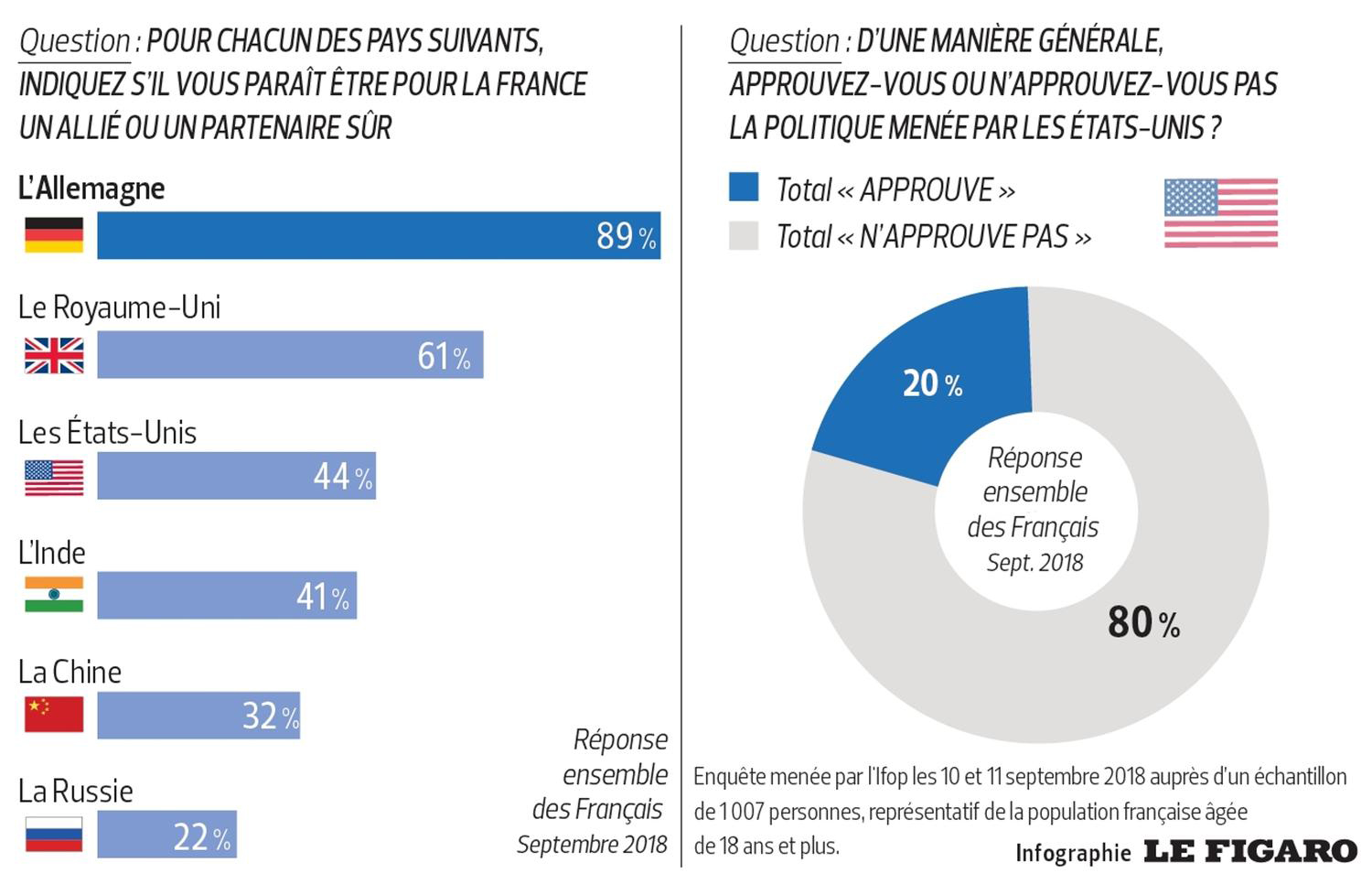
A majority of 80% of French citizens are wary of the US and do not approve its politics / Source: Le Figaro
Lacan found himself in a situation that had never been that of Freud: he found himself in a situation where he would become the director of his school, that is to say that by later founding l’École Freudienne de Paris in 1964 he would exercise functions that Freud never exercised. Lacan was at the same time the master of thought, the analyst, the political leader of his school, and was responsible for all the functions, whereas Freud had delegated political power to his disciples.
« Je fonde – aussi seul que je l’ai toujours été dans ma relation à la cause psychanalytique – l’École Française de Psychanalyse (…) dont rien dans le présent ne m’interdit de répondre personnellement la direction…»
French for: “I am founding – as alone as I have always been in my relationship to the psychoanalytic cause – the École Française de la Psychanalyse (…) whose direction I am personally responsible for as nothing in the present prevents me to do so….”
– Jacques Lacan
Hence, criticized by the IPA, proponents of a rigid legislation, Lacan left the Société Psychanalytique de Paris which was frequented by Marie Bonaparte who thought she was the only heiress of Freud whose memory she piously celebrated with the support of the IPA.
Lacan then participated in 1953 with Daniel Lagache, François Perrier, Serge Leclerc and Wladimir Granoff in the creation of the Société Française de Psychanalyse ; his friend Françoise Dolto, founder of a new psychoanalytical approach to childhood, gave him her support. La Société Française de Psychanalyse would become a sophisticated cultural melting pot for all the youth of that generation and Lacan would train them by being, in the words of Elisabeth Roudinesco, “l’analyste, le contrôleur, le maître, l’initiateur, l’éveilleur” [French for: “the analyst, the controller, the master, the initiator and the awakener”] through his seminars which took place at the Sainte Anne Hospital followed by the presentation of the mentally sick. Lacan became the great renovator and the great re-inventor of psychoanalysis in France. That generation felt like the pioneers of something new around Lacan, but they would have also liked to remain in the IPA, in its Freudian legitimacy, of which they were no longer a part of since their masters had resigned. The characteristic of Lacan was that he contested the whole practice of the IPA that was trying to be Freud. Lacan is the only one to suggest a return to the origins of Freudian theory, i.e. not post-Freudism. Thus at that point, Lacan posed himself as the re-founder, and an intellectual who was transgressive since Lacan would not respect any irrational IPA rule, which of course humiliated the IPA who could not digest Lacan and his perspectives, and perhaps also unable to grasp the sophisticated subtleties of Lacan’s theory which had its origins in the French heritage. Unique in its kind, the École Freudienne de Paris would allow Lacan to place the desire to be an analyst at the heart of the training of didacticians. Jean-Bertrand Pontalis declared: “Comme si lui-même (Lacan), dans ces années-là était en train d’inventer et de s’inventer. Nous participions en accord avec lui en résonance avec lui à un mouvement inventif.” [French for: “As if he himself (Lacan), in those years was inventing and inventing himself. In agreement with him, we were participating in an inventive movement in resonance with him.“]
Furthermore, despite [or perhaps because of?] the IPA’s decision to bar Lacan from training future psychoanalysts, the proportion of Psychoanalysts adopting a Lacanian perspective has only grown since Lacan’s death in 1981 – with half or more of the world’s psychoanalysts adopting Lacanian concepts. Jardim, Costa Pereira and de Souza Palma (2011) applied Lacanian Theory to understanding the personality disorder of Schizophrenia [formerly known as “madness”], interpreting a case study [along with fictional examples from literary works] in terms of failure to achieve an integrated Ego from infancy onwards. McSherry (2013) argued that Lacan’s Theory of Psychoanalysis could benefit mental health nursing practice since various forms of personality disorders [including but not limited to Schizophrenia] can be understood readily in terms of Lacan’s theory.
Lacan described woman as a “symptom of man” that enters the psychic economy of men as the cause of their desire. This has led to debates among feminists: some saw his theories as a way of challenging fixed concepts of sexual identity while others believe that the concept of symbolic order reinstates the inequality of the sexes, and the privileging of the phallus simply repeats alleged misogynies of Freud.
The British psychoanalyst Juliet Mitchell who was one of the first to introduce Lacan’s system of thought to the Anglophone crowd thought that his work was misinterpreted and misused for a political purpose for the left and for feminism; Mitchell suggested that a possible reason for this could have been due to the “stupidity” of the English crowd, unable to grasp the subtleties of Lacan. Malone (2012) noted that Lacan was ambivalent towards the growing tendency for empirical clinical psychologists to align their discipline with the hard sciences [e.g. Biology, Medecine, Physics, Chemistry, Astrophysics, Material Science, etc] and not with the humanities [e.g. Literature, Poetry, Music, Art (Sculpture, Painting and others), Drama (Theatre), etc], and viewed psychoanalysis as ideally informed by both the humanities and by the sciences.
Documentaire: Jacques Lacan, La Psychanalyse Réinventée (2001)
Lacan has been hailed as the “French Freud” who has established a tradition of French psychoanalysis that rivals American and British psychoanalysis in terms of international influence. Although Lacan’s theory has been cast as a uniquely French theory [culturally and linguistically speaking], it has nonetheless struck a chord with many [and, perhaps, most] of the world’s most influential modern day psychoanalysts, shattering perceptions across languages and cultures worldwide. Perhaps unsurprisingly, a decade later, much psychoanalytic research in the US itself will seem to confirm Lacan’s perspectives as discussed above.
After the publication of his writings in 1966, Lacan became a recognized thinker, admired by his students and hated by his opponents. At L’École Normale, the salle Dussane, a large crowd flocked to listen to him.
« Quand je comprenais je trouvais ça génial… »
French for: “When I figured it out, I thought it was great…”
-Françoise Dolto
The writer Philippe Sollers lyrically describes the harmonies and dissonances of the main stage of Jacques Lacan’s seminar:
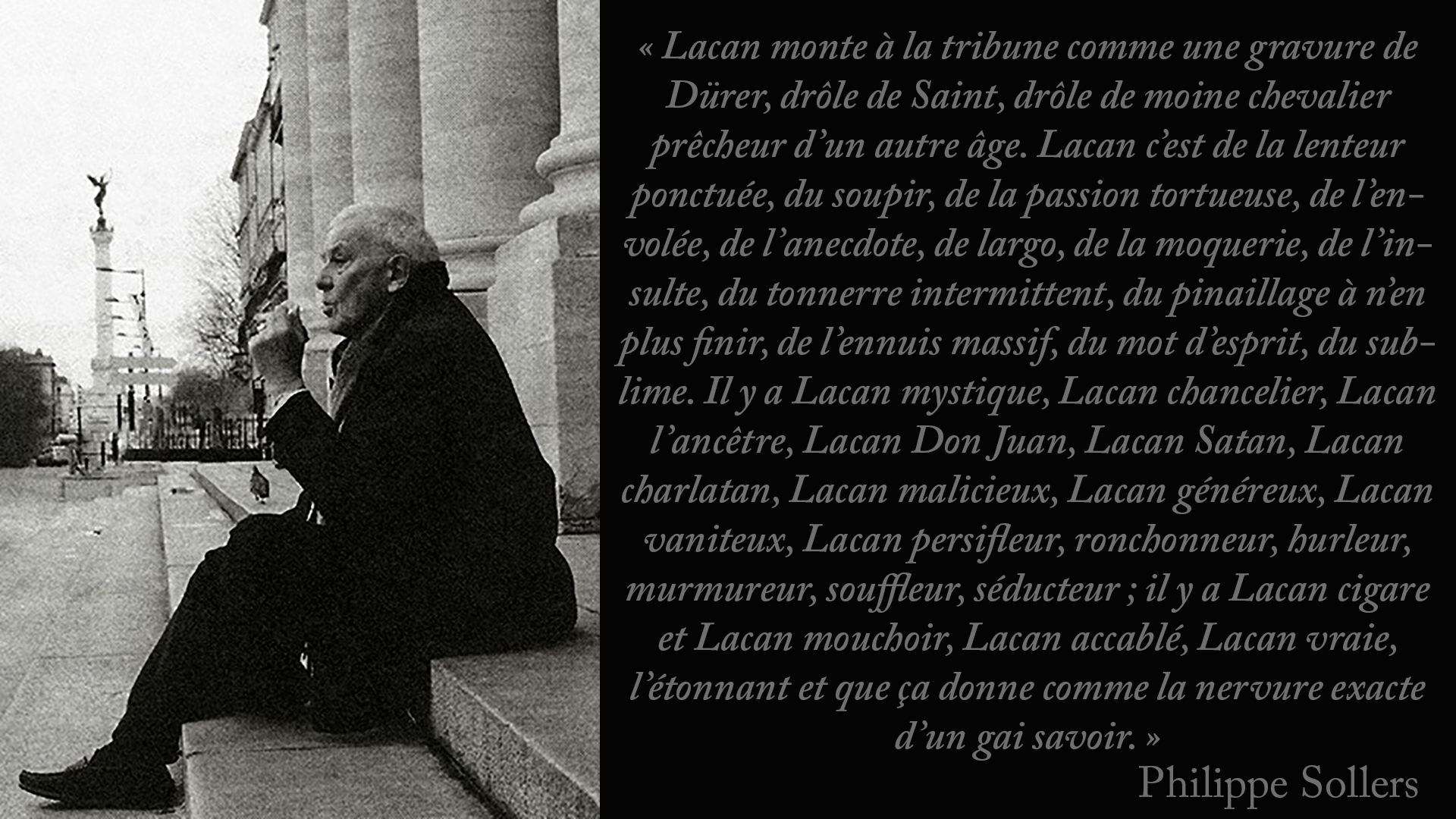
“Lacan monte à la tribune comme une gravure de Dürer (Albrecht), drôle de Saint, drôle de moine chevalier prêcheur d’un autre âge. Lacan c’est de la lenteur ponctuée, du soupir, de la passion tortueuse, de l’envolée, de l’anecdote, de largo, de la moquerie, de l’insulte, du tonnerre intermittent, du pinaillage à n’en plus finir, de l’ennuis massif, du mot d’esprit, du sublime. Il y a Lacan mystique, Lacan chancelier, Lacan l’ancêtre, Lacan Don Juan, Lacan Satan, Lacan charlatan, Lacan malicieux, Lacan généreux, Lacan vaniteux, Lacan persifleur, ronchonneur, hurleur, murmureur, souffleur, séducteur ; il y a Lacan cigare et Lacan mouchoir, Lacan accablé, Lacan vraie, l’étonnant et que ça donne comme la nervure exacte d’un gai savoir.” -Philippe Sollers
French for: “Lacan rises to the platform like an engraving by Dürer (Albrecht), a strange Saint, a strange knightly monk preacher from another age. Lacan is punctuated slowness, sighing, tortuous passion, flight, anecdote, largo, mockery, insult, intermittent thunder, endless nitpicking, massive trouble, witty words, the sublime. There is mystical Lacan, Chancellor Lacan, Lacan the ancestor, Lacan Don Juan, Lacan Satan, Lacan charlatan, malicious Lacan, generous Lacan, vain Lacan, Lacan persifleur, grumbler, howler, whisperer, blower, seducer; there is Lacan cigar and Lacan handkerchief, overwhelmed Lacan, true Lacan, the astonishing and that which gives like the exact vein of a cheerful knowledge.” -Philippe Sollers
Jacques Derrida would say:
« Je n’imagine pas que quelqu’un qui était engagé comme il l’a été avec une telle passion de la vérité là où le sens même du mot vérité était si difficile à faire entendre, je n’imagine pas qu’une telle personne ait pu vivre autrement que tragiquement (…) ce qui m’a aidé à résister à toute réponse agressive à Lacan, je pensais que cet homme avait une responsabilité tragique à assumer et quel que soit sa parade, son paraître, son apparat, etc… les scènes qu’il faisait, il devait y avoir de la blessure secrète là et je l’ai ressenti et je l’ai respecté. »
French for: “I cannot imagine that someone who was engaged as he was with such a passion for the truth where the very meaning of the word truth was so difficult to convey, I cannot imagine that such a person could have lived any other way but tragically (…) which helped me to resist any aggressive response to Lacan, I thought that this man had a tragic responsibility to assume and whatever his parade, his appearance, his pomp, etc., the scenes he made, there must have been some secret wound there and I felt it and I respected it.”
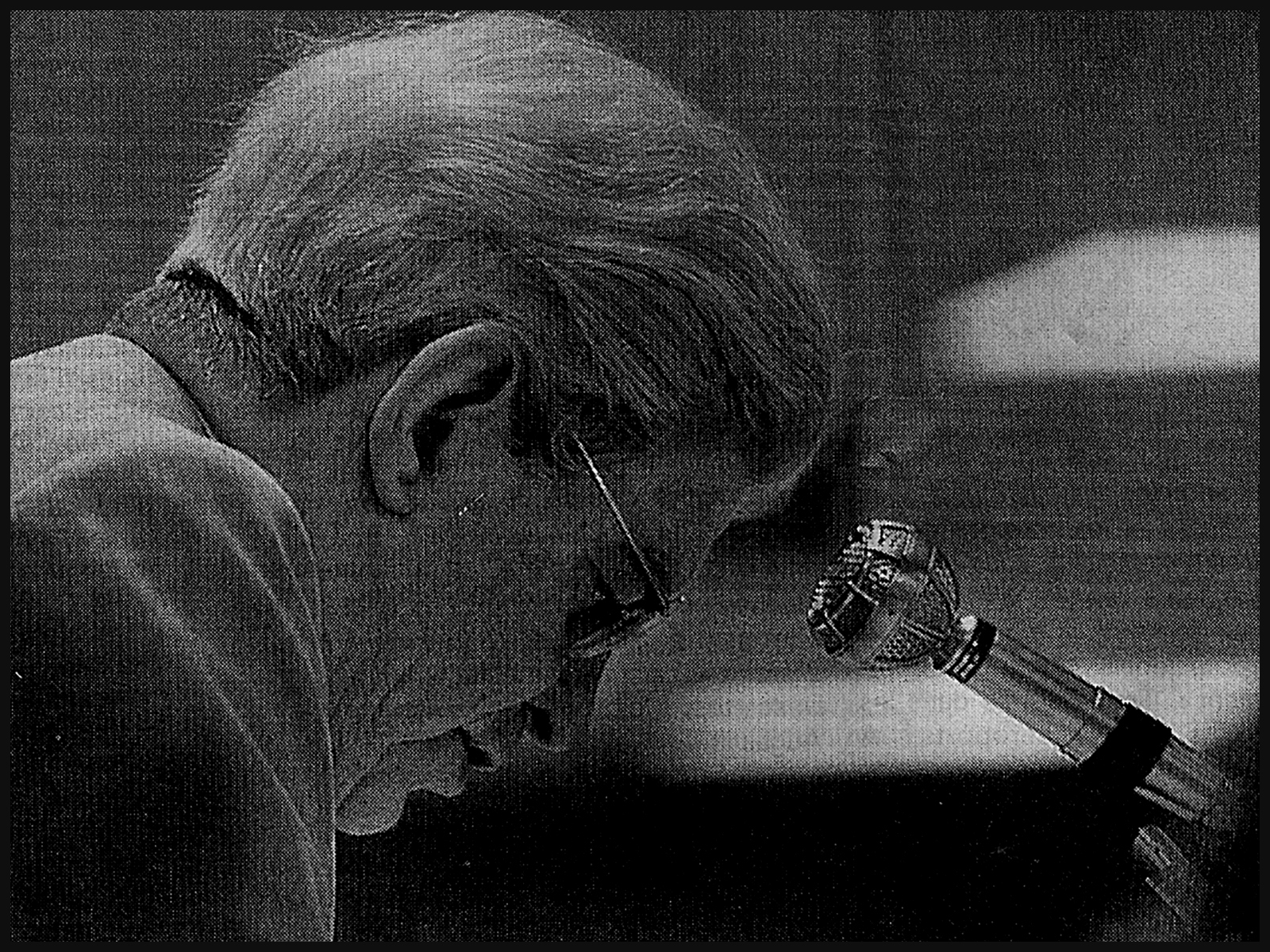
Jacques Lacan (1901 – 1981)
Jacques Lacan addressing the audience of the Grande Rotonde of the University of Louvain, the 13th of October 1972:
« La mort est du domaine de la foi, vous avez bien raison de croire que vous allez mourir bien sûr ; ça vous soutient ; si vous n’y croyez pas, est-ce que vous pourriez supporter la vie que vous avez ? Si on n’était pas solidement appuyés sur cette certitude que ça finira ? Est-ce que vous pourriez supporter cette histoire ? »
French for: “Death is a matter of faith, you have good reason to believe that you are going to die of course; it sustains you; if you don’t believe in it, could you bear the life that you have? If you weren’t firmly supported by the certainty that it will end? Would you be able to bear it?”
Lacan’s work is incredibly versatile and renowned for its complexity, and it remains alive and open to continuity since it is founded on a logic of infinite creativity associated with the human psyche. Jacques Lacan’s work is relatively fresh in the field of psychoanalysis and can easily synthesize a range of concepts from the simplified models of other schools of psychology that are mostly focused on the conscious aspects of human cognition. Lacanian heritage remains alive also because in our times, it has still not been completely studied, understood and absorbed by the body of mainstream academic knowledge, and remains mostly articulated within the psychoanalytic community and among scholars who make the effort to understand its logic, and who are not intimidated by the scope and complexity of his psychoanalytic heritage and influences.
Conclusion: Legacy, Impact & Evolution of Psychoanalysis
Psychoanalysis is a unique movement in psychology that grew out of the same German model of mental activity that produced act psychology and the Gestalt movement. However, psychoanalysis received its immediate expression through the needs of the mentally ill. Psychoanalysis was born as a clinical discipline, not an academic development based on empirical methodology to fit a particular field’s reductionist requirements for acknowledgement. For this reason, psychoanalysis, especially as proposed by writers after Freud, gives the impression of an ad hoc movement that develops as particular problems arise – it could be seen as adaptive and constantly evolving. Psychoanalysis did not adhere to the commitment to the reductionist empirical methodology expressed in those mechanical systems of behavioral studies generated by academic research. Psychoanalysis set out not to simply study basic observable behaviour [e.g. in animals studies], but to study the psychic apparatus that constitutes the human mind which obviously guides and impacts behaviour. Hence, there was and still is little interaction between psychoanalysis and those systems grounded on empiricism and reductionist methodologies that are stubborn in trying to capture an entity as the mind when most of the constructs cannot be seen or touched, or accurately measured. Stated quite simply, psychoanalysis and the other schools of psychological models do not speak the same language.
Although different and hardly understood by common mainstream empirical and academic psychology, psychoanalysis did assume a dominant role in psychiatry. This is completely understandable in light of the origins of psychoanalysis as a response to clinical problems as they manifested themselves. Indeed, psychoanalytic writings enjoyed an almost exclusive position in psychiatry and clinical psychology until the 1960s, when behaviour modification and mechanical and reductionist Pavlovian derivatives based on Behaviourism [such as Cognitive Psychology] began to compete as an alternate model of therapy for behavioural adjustment [Read: the Essay on the Origins of the Cognitive Behavioural Model: Biological Constraints in Learning, which also suggests an unconscious drift in other animals].
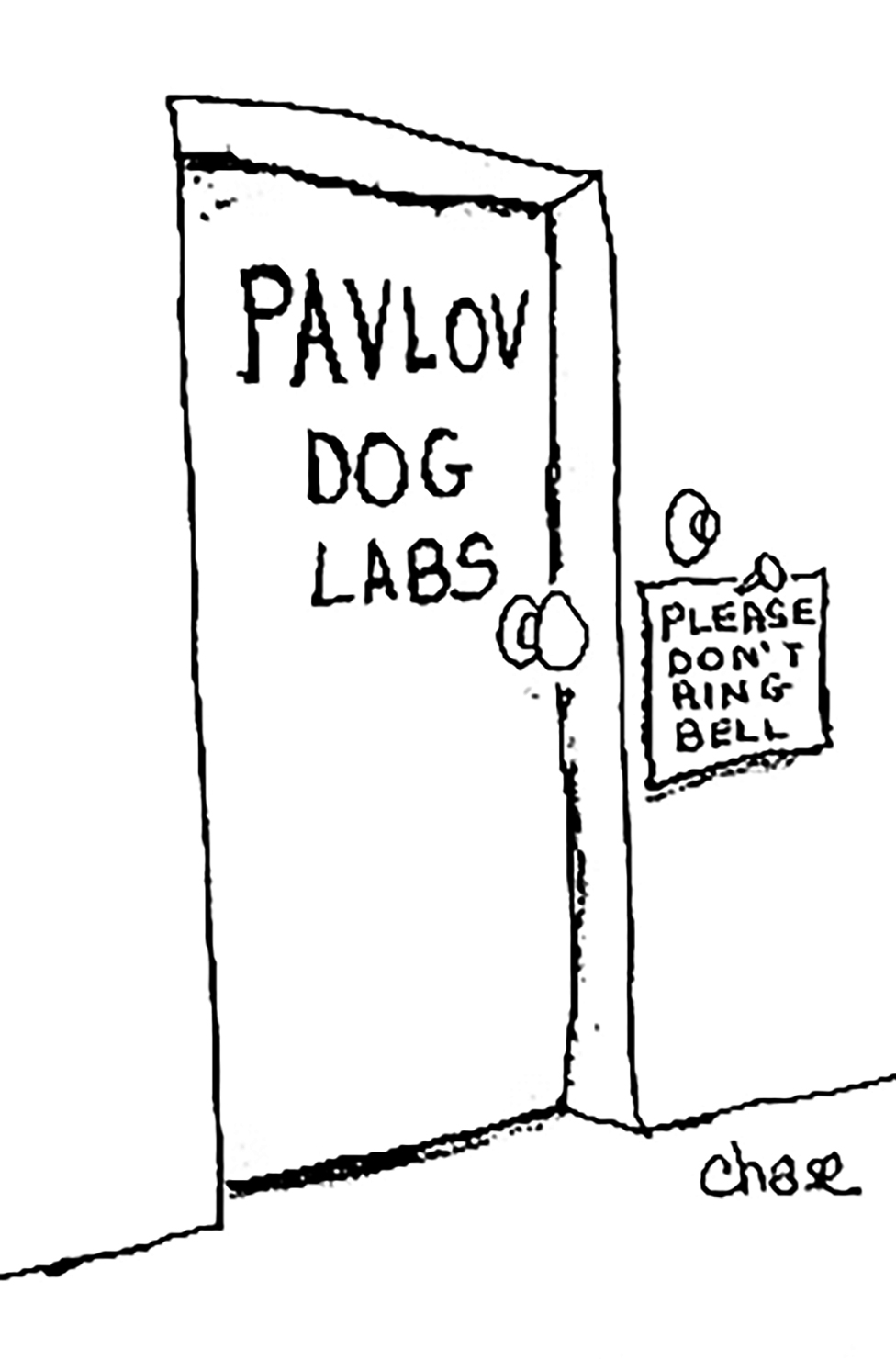
Psychoanalysis continues to exert a marked influence on art, literature, and philosophy. This influence reflects major contributions of Freud: his comprehensive analysis of the unconscious. On the same line, literary and artistic expressions are interpreted in light of the unconscious activities of the artist as well as the unconscious impressions of the perceiver. Psychologists today may choose unconscious motivations or simply to refer to subliminal or subthreshold activities. However, any truly comprehensive theory of psychological activity can no longer be limited to conscious aspects of behaviour. Although some psychologists may disagree with some Freudian concepts and interpretations, Freud did identity some dynamic processes that influence the activity of the individual: processes that psychology cannot ignore anymore.
As mentioned earlier, psychoanalysis has a unique position in the history of psychology. Freud did not develop a theory that generated testable hypotheses or other empirical implications. Yet, on another level, Freud accomplished what few other theorists have: He revolutionised attitudes and created a new set for thinking about personality. The findings of other more empiricist theories of personality disturbance have often confirmed many of Freud’s observations. If his views do not meet the criteria of empiricistic study, they nevertheless mark a man of genius and insight, whose influence pervades people’s thinking about themselves in ways that few others have achieved.
The psychoanalytic theory is an enormously complex and ambitious one, and it aims to make sense of a much broader array of psychological and social phenomena than other theories, and does so with a collection of explanatory concepts. Hence, the sheer range and scope of psychoanalytic theory, and its aspiration to be a total account of mental life, should be recognised and applauded. In comparison, all other schools of psychology to study personality look decidedly timid and limited in focus. Even if other approaches tend to have more empirical foundations and hence more credential in academic psychology, they tend to leave out much of what we might want to include in a comprehensive theory of human behaviour. To many intellectuals and lay people alike, any account of personality that does not acknowledge that humans are like psychoanalytic theory portrays us, i.e., driven by deeply rooted motives, inhabiting bodies that bring us pleasure and shame, shaped by our early development, troubled by personal conflicts, and often a mystery to ourselves – is fundamentally limited.
While the empirical limitations are a fact, some of these problems are due in part to the intrinsic difficulty of what psychoanalytic theory tries to explain. Others could be partially overcome if researchers made a more concerted effort to determine which psychodynamic ideas stand up to closer, “scientific enquiry”. However, psychoanalysis cannot be judged only by empirical perspectives, and it would be a mistake to abandon it impatiently, given how much a suitably revised and empirically updated theory of psychodynamics in the future might deepen the studies of personality.
Even for all its failings to the empirical scientist, on some aspects, psychoanalysis is at least partly responsible for several important and scientifically respectable ideas that has always had a kernel of truth and was later developed by other researchers. While Freud’s idea of the dynamic unconscious remains controversial, it can no longer be disputed today that unconscious cognition is now a fact and an uncontroversial idea in cognitive and social psychology, where huge volumes of research now explore non-conscious or “implicit” attitudes. We now know from neuroscientific research that the brain has networks for both explicit and implicit [unconscious] learning as Yang and Li (2012) found after examining the neural correlates for these 2 types of learning on artificial grammar sequences. We have brain networks of different connectivity that underlie explicit and implicit learning. While both processes involve activation in a set of cortical and subcortical structures, the study found that explicit learning engages a network that uses the insula as a key mediator whereas implicit learning evokes a direct frontal-striatal network. Individual differences in working memory also differentially impact the two types of sequence learning.
*****
Bibliographie
- Adams, H. E., Wright, L. W., & Lohr, B. A. (1996). Is homophobia associated with homosexual arousal? Journal of Abnormal Psychology, 105, 440-5.
- Adler, A. (1956). The individual psychology of Alfred Adler. L. Ansbacher & R. R. Ansbacher (Eds.). New York. Basic Books.
- Adler, A. (1958). What life should mean to you. New York: Capricorn Books.
- Berger, P.L. and Luckmann, T. (2022) La construction sociale de la réalité. 3e edn. Malakoff, France: Armand Colin.
- Bornstein, R.F. (2005). Reconnecting psychoanalysis to mainstream psychology. Psychoanalytic Psychology, 22, 323-340.
- Bradley, B.P., Mogg, I. & Millar, N. (1996). Implicit memory bias in clinical and non-clinical depression. Behaviour Research Therapy, 34, 865-879.
- Bradley, B.P., Mogg, I. & Williams, R. (1994). Implicit and explicit memory for emotion-congruent information in depression and anxiety. Behaviour Therapy and Research, 32, 65-78.
- Bradley, B.P., Mogg, I. & Williams, R. (1995). Implicit and explicit memory for emotion-congruent information in depression and anxiety. Behaviour Therapy and Research, 33, 755-770.
- Brennan, J. (2014). History and Systems of Psychology (6th Ed).
- Carr, A. (2012). Clinical psychology. 1st ed. New York: Routledge.
- Chambless, D.L., Sanderson, W.C., Shoham, V., Bennett Johnson, S., Pope, K.S., Crits-Cristoph, P. et al. (1996). An update on empirically validated therapies. Clinical Psychologist, 49, 5-18.
- Dupuy, C. (2016). Journalistes, des salariés comme les autres?: Représenter, Participer, mobiliser. Rennes, France: Presses universitaires de Rennes.
- Eagle, M. (1987). The psychoanalytic and cognitive unconscious. In R. Stern (Ed.), Theories of the unconsciousness and theories of the self, 155-189. Hillsdale, NJ: Analytic Press.
- Ellenberger, H. F. (1970). The discovery of the unconscious. New York: Basic Books.
- Fairbairn, W.R.D. (1952). An object relations theory of personality. New York: Basic Books.
- Fazio, R., Jackson, J. R., Dunton, B., & Williams, C. J. (1995). Variability in automatic activation as an unobstrusive measure of racial attitudes: A bona fide pipeline? Journal of Personality and Social Psychology, 69, 1013-27.
- Fordham, F. (1953). An introduction to Jung’s psychology. London: Penguin.
- Freud, S. (1920). The psychopathology of everyday life. New York: Mentor.
- Freud, S. (1938). The history of the psychoanalytic movement. In A. A. Brill (Ed. And Trans.), The basic writing of Sigmund Freud. New York: Random House.
- Freud, S. (1955). The interpretation of dreams. In J. Strachey (Ed.), The standard edition of the complete works of Sigmund Freud (Vols. IV and V). London: Hogarth.
- Freud, S. (1965). New introductory lectures on psychoanalysis. New York: W. W. Norton.
- Gabbard, G.O. (2000). Psychodynamic psychotherapy in clinical practice (3rd). Washington, DC: American Psychiatric Press.
- Gabbard, G.O. (2004). Long-term psychodynamic psychotherapy. Washington, DC: American Psychiatric Publishing Incorporated.
- Gay, P. (1988). Freud: A life for our time. New York: Norton.
- Gillett, G. (2001). Signification and the unconscious. Philosophical Psychology, 14, 477-498.
- Gorog, J. (2009). Le réel et le travail de l’inconscient. Analyse Freudienne Presse, 16(1), p.115.
- Gravitz, M. A., & Gerton, M. I. (1981). Freud and hypnosis: Report of post-rejection use. Journal of the History of the Behavioural Sciences, 17, 68-74.
- Greenberg, J. (2001a). The analysts’s participation: A new look. Journal of the American Psychoanalytic Association, 49, 359-381.
- Greenberg, J.R. (1986). Theoretical models and the analyst’s neutrality. Contemporary Psychoanalysis, 22, 87-106.
- Hale, N. G. (1971). Freud and the Americans. New York: Oxford University Press.
- Hall, C. S., & Lindzey, G. (1970). Theories of personality (2nd). New York: Wiley & Sons.
- Hall, C. S., & Lindzey, G. (1970). Theories of personality (Rev. ed.). New York: Wiley
- Haslam, N., Smilie, L., & Song, J. (2017) An Introduction to Personality, Individual Differences and Intelligence (2 Eds.). Sage Publications Ltd.
- Hivernel, F. (2013). “The parental couple”: Franciose Dolto and Jacaues Lacan: Contributions to the mirror stage. British Journal of Psychotherapy, 29, 505-518.
- Huprich, S. K. (2008). Psychodynamic Therapy: Conceptual and Empirical Foundations. Routledge
- Ittleson, W.H. & Kilpatrict, F.P. (1981). Experiments in perception. Scientific American, 185, 50-55.
- Jaquet, C. and Bras, G. (2018). La Fabrique des transclasses. Presses Universitaires de France. Paris, France.
- Jardim, L. L., Costa Pereira, M. E., & de Souza Palma, M. (2011). Fragments of the Other: A psychoanalytic approach to the ego in schizophrenia. International Forum of Psychoanalysis, 20, 159-166.
- Jones, E. (1955). The life and work of Sigmund Freud. New York: Basic Books.
- Jones, R. L. (1994). An Empirical Study of Freud’s Penis-Baby Equation. The Journal of Nervous and Mental Disease, 182(3), 127–135
- Jung, C. G. (1933). Modern man in search of a soul. New York: Harcourt Brace.
- Jung, C. G. (1953). Psychological reflections (J. Jacobi, Ed.). New York : Harper & Row.
- Jung, C. G. (1959). The basic writings of C. G. Jung. New York: Random House.
- Kainer, R. G. (1984). Art and the canvas of the self: Otto Rank and creative transcendence. American Imagi, 14, 359-372.
- Kapnist, E. (2001). Jacques Lacan : La psychanalyse réinventée. ARTE France, INA
- La-Philosophie.com : Cours, Résumés & Citations de Philosophie. (2020). La philosophie de Nietzsche. [online] Available at: https://la-philosophie.com/philosophie-nietzsche [Accessed 20 Jan. 2020].
- La-Philosophie.com : Cours, Résumés & Citations de Philosophie. (2020). La philosophie de Spinoza. [online] Available at: https://la-philosophie.com/philosophie-spinoza [Accessed 20 Jan. 2020].
- LeDoux, J. (1989). Cognitive-emotional interactions in the brain. Cognition and Emotion, 3, 267-289.
- LeDoux, J. (1995). Emotion: Clues from the brain. Annual Review of Psychology, 46, 209-235.
- Leichsenring, F. & Rabung, S. (2011). Long-term psychodynamic psychotherapy in complex mental disorders: A meta-analysis. British Journal of Psychiatry, 199, 15-22.
- Leichsenring, F., Rabung, S. & Leibing, E. (2004). The efficacy of short-term psychodynamic psychotherapy in specific psychiatric disorders: A meta-analysis. Archives of General Psychiatry, 61, 1208-1216.
- Lewis, J.L. (1970). Semantic processing of unattended messages during dichotic listening. Journal of Experimental Psychology, 85, 225-228.
- Luepnitz, D. A. (2009). Thinking in the space between Winnicott and Lacan. International Journal of Psychoanalysis, 90, 957-981.
- Macmillan, M. (1985). Souvenir de la Salpêtrière: M. le Dr. Freud à Paris, 1885. New Zealand Journal of Psychology, 14, 41-57.
- Malin, B. D. (2011). Kohut and Lacan: Mirror opposites. Psychoanalytic Inquiry, 31, 58-74.
- Malone, K. R. (2012). Lacan, Freud, the humanities, and science. Humanistic Psychologist, 40, 246-257.
- Marder, E. (2013). Real dreams. Southern Journal of Philosophy, 51, 196-213.
- McSherry, A. (2013). Jacques Lacan’s theory of the subject as real, symbolic and imaginary: How can Lacanian theory be of help to mental health nursing practice? Journal of Psychiatric and Mental Health Nursing, 20, 776-781.
- Meyer, P. (2001). Freud and the human sciences. Annals of Psychoanalysis, 29, 247-258.
- Miller, J. and Lacan, J. (2017). Jacques Lacan : Conférence de Louvain. La Cause Du Désir, N° 96(2), p.7.
- Milner, B., Corkin, S. & Teuber, H.L. (1968). Further analysis of the hippocampal amnesic syndrome Fourteen year follow-up study of H.M. Neuropsychologia, 6, 215-234.
- Mogosanu, L., (2013). L’intime à l’oeuvre. Presses Academiques Francophones. Hachette.
- Morrison, C., Bradley, R., & Westen, D. (2003). The external validity of efficacy trials for depression and anxiety: A naturalistic study. Psycology and Psychotherapy: Theory, Research, and Practice, 76, 109-132.
- Norcross, J.C. (2002a). Empirically supported therapy realationships. In J.C. Norcross (Ed.), Psychotherapy relationships that work. New York: Oxford.
- Nouvel, P. (2008) “Philosophie de la stimulation,” Les Cahiers du Centre Georges Canguilhem, 2(1), pp. 283–311. Available at: https://doi.org/10.3917/ccgc.002.0283.
- Orlinsky, D. & Howard, K.E. (1977). The therapist’s experience of psychotherapy. In A.S. Gurman & A.M. Razin (Eds.), Effective psychotherapy: A handbook of research, 566-589. New York: Pergamon.
- Pine, F. (1998). Diversity and direction in psychoanalytic technique. New haven, CT: Yale University Press.
- Rocha, G. M. (2012). The unconscious: Ideal worker? International Forum of Psychoanalysis, 21, 17-21.
- Roudinesco, E. (1993). Jacques Lacan : Esquisse d’une vie, histoire d’un système de pensée. Fayard.
- Samuels, A. (1994). The professionalisation of Carl G. Jung’s analytical psychology clubs. Journal of the History of the Behavioural Sciences, 30, 138-147.
- Savage, J.E., Jansen, P.R., Stringer, S., et al. (2018). Genome-wide association meta-analysis in 269,867 individuals identifies new genetic and functional links to intelligence. Nat Genet 50, 912–919
- Schick, A. (1968 – 1969). The Vienna of Sigmund Freud. Psychoanalytic Review, 55, 529-551.
- Schmutte, H. (2016). Nietzsche : entre génie et démence. ARTE. [online] Available at: https://www.youtube.com/watch?v=25uLlN5uNF0 [Accessed 9 Feb. 2020].
- Sephora, M. (2018). A quoi ça sert l’art ?. Ap.D Connaissances. [online] Available at: https://apdconnaissances.com/2018/04/02/a-quoi-ca-sert-lart/ [Accessed 20 Jan. 2020].
- Shevrin, H. & Dickman, S. (1980). The psychological unconscious: A necessary assumption for all psychological theory? American Psychologist, 35, 421-434.
- Shevrin, H. & Fisher, C. (1967). Changes in the effects of a waking subliminal stimulus as a functioning of dreaming and non-dreaming sleep. Journal of Abnormal Psychology, 72, 362-368.
- Shevrin, H. (1973). Brain wave correlates of subliminal stimulation, unconscious attention, primary and secondary-process thinking and repressiveness. Psychological Issues, 30, 56-87.
- Shevrin, H. (1986). Subliminal perception and dreaming. Journal of Mind and Behaviour, 7, 379-395.
- Shevrin, H. (1988). Unconscious conflict: A convergent psychodynamic and electrophysiological approach. In M. J. Horowitz (Ed.), Psychodynamics and cognition, pp, 117-167. Chicago, IL: University of Chicago Press.
- Shevrin, H. (1990). Subliminal perception and repression. In J.L Singer (Ed.), Repression and dissociation: Implications for personality theory, psychopathology, and health, 103-119. Chicago, IL: University of Chicago Press.
- Shevrin, H. (1996). Psychoanalytic research: Experimental evidence in support of basic psychoanalytic assumptions. In E. Nersessian & R.G. Kopff, Jr. (Eds.), Textbook of psychoanalysis, 575-603. Washington, DC: American Psychiatric Press.
- Shevrin, H. (2006). The contribution of cognitive behavioural and neurophysiological frames of reference to a psychodynamic nosology of mental illness. In Alliance of Psychoanalytic Organisations, Psychodynamic diagnostic manual (PDM), 483-509. Silver Spring, MD: Alliance of Psychoanalytic Organisations.
- Shevrin, H., Bond, J., Brakel, L, Hertel, R., & Williams, W.J. (1996). Conscious and unconscious processes: Psychodynamic, cognitive, and neurophysiological convergences. New York: Guilford.
- Shevrin, H., Williams, W.J., Marshall, R.E., Hertel, R.K., Bong, J.A. & Brakel, L.A.W. (1992). Event-related potential indicators of the dynamic unconscious. Consciousness and Cognition, 1, 340-366.
- Sichère, B. (2004). “« Nous sommes déjà très suffisamment une civilisation de la haine »,” La pulsion de mort entre psychanalyse et philosophie, pp. 127–148. Available at: https://doi.org/10.3917/eres.reyfl.2004.01.0127.
- Silverman, D.K. (1986). Some proposed modifications of psychoanalytic theories of early child development. In J. Masling, (Ed.), Empirical studies of psychoanalytic theories, 49-72. Hillsdale, NJ: Erlbaum.
- Silverman, L.H., Bronstein, A. & Mendelsohn, E. (1976). The further use of psychodynamic activation method for experimental study of the clinical theory of psychoanalysis: On the specificity of the relationships between symptoms and unconscious conflicts. Psychotherapy: Theory, Research, and Practice, 13, 2 -16.
- Silverman, L.H., Kwawer, J.S., Wolitzky, C. & Coron, M. (1973). An experimental study of aspects of the psychoanalytic theory of male homosexuality. Journal of Abnormal Psychology, 82, 178-88.
- Silverman, L.H., Lachman, F.M. & Milich, R.H. (1982). The search for oneness. New York: International University Press.
- Silverman, L.H., Ross, D.L., Adler, J.M. & Lustig, D.A. (1978). Simple research paradigm for demonstrating subliminal activation effects: Effects of Oedipal stimuli on dart-throwing accuracy in college males. Journal of Abnormal Psychology, 87, 341-347.
- Silverman, L.S. (1983). The psychodynamic activation method: Overview and comprehensive listing of studies. In J. Masling (Ed.), Empirical studies of psychoanalytic theories (Vol. 1), pp. 69-100. Hillsdale, NJ: Erlbaum.
- Sirkin, M., & Fleming, M. (1982). Freud’s “project” and its relationship to psychoanalytic theory. Journal of the History of the Behavioural Sciences, 18, 230-241.
- Solms, M. (2000a). A psychoanalytic contribution to contemporary neuroscience. In G.vandeVijver&F.Geerardyn(Eds.), The pre-psychoanalytic writings of Sigmund Freud, 17-35. London: Karnac Books.
- Solms, M. (2000b). Preliminaries for an integration of psychoanalysis and neuroscience. Annals of Psychoanalysis, 28, 179-200.
- Solms, M. (2001). The interpretation of dreams and the neurosciences. Psychoanalytic History, 3, 79-91.
- Solms, M. (2002). An introduction to the neuroscientific works of Sigmund Freud. In M Velmans (Ed.), Investigating phenomenal consciousness: New methodologies and maps. Advances in Consciousness Research Series (M. Stamenov, Seried Ed.), pp. 67-95. Amsterdam: John Benjamins Publishing.
- Solms, M. (2004). Is the brain more real than the mind? In A. Casement (Ed.), Who owns psychoanalysis?, 323-324. London: Karnac.
- Solomon, H. M. (2003). Freud and Jung: An incomplete encounter. Journal of Analytical Psychology, 48, 553-569.
- Spence, D.P. (1980). Narrative truth and historical truth: Meaning and interpretation in psychoanalysis. New York: W.W. Norton.
- Stockholder, K. (1998). Lacan versus Freud: Subverting the Enlightenment. American Imago, 55, 361-422.
- Stolorow, R.D., Atwood, G.E. & Brandchaft, B. (1994). The intersubjective perspective. Northvale, NJ: Aronson.
- Task Force on Promotion and Dissemination of Psychological Procedures (1995). Training in and dissemination of empirically validated psychological treatments: Report and recommendations. Clinical Psychologist, 48, 2-23.
- Task Force on Psychological Intervention Guidelines (1995). Template for developing guidelines: Interventions for mental disorders and psycho-social aspects of physical disorders. Washington, DC: American Psychological Association.
- Thompson-Brenner, H., Glass, S., & Westen, D. (2003). A multidimensional meta-analysis of psychotherapy for bulimia nervosa. Clinical Psychology: Science and Practice, 10, 269-287.
- Waintrater, R. (2012). Intersubjectivity and French psychoanalysis: A misunderstanding? Studies in Gender and Sexuality, 13, 295-302.
- Wallerstein, R.S. (2002). The growth and transformation of American ego psychology. Journal of the American Psychoanalytic Association, 50, 135-169.
- Wampold, B.E. (2001). The great psychotherapy debate: Models, methods, and findings. Mahwah, NJ: Erlbaum.
- Weinberger, J. & Hardaway, R. (1990). Separating science from myth in subliminal psychodynamic activation. Clinical Psychology Review, 10, 727-756.
- Weitz, L. WJ. (1976). Jung’s and Freud’s contributions to dream interpretation: A comparison. American Journal of Psychotherapy, 30, 289-293.
- Westen, D. & Gabbard, G.O. (2002b). Developments in cognitive neuroscience: II. Implications for theories of transference. Journal of the American Psychoanalytic Association, 50, 99-134.
- Westen, D. & Morrison, K. (2001). A multidimensional meta-analysis of treatments for depression, panic and generalised anxiety disorder: An empirical examination of the status of empirically supported therapies. Journal of Consulting and Clinical Psychology, 69, 875-899.
- Westen, D. (1999). The scientific status of unconscious processes: Is Freud really dead? Journal of the American Psychoanalytic Association, 47, 1061-1106.
- Westen, D., Novotny, C.M., & Thompson-Brenner, H. (2004). The empirical status of empirically supported psychotherapies: Assumptions, findings, and reporting in controlled clinical traits. Psychological Bulletin, 130, 633-663.
- Yang, J. and Li, P. (2012). Brain Networks of Explicit and Implicit Learning. PLoS ONE, 7(8), p.e42993.
D.J. d’Purb | dpurb.com
____________________________________________________
While the aim of the community at dpurb.com has been & will always be to focus on a modern & progressive culture, human progress, scientific research, philosophical advancement & a future in harmony with our natural environment; the tireless efforts in researching & providing our valued audience the latest & finest information in various fields unfortunately takes its toll on our very human admins, who along with the time sacrificed & the pleasure of contributing in advancing our world through sensitive discussions & progressive ideas, have to deal with the stresses that test even the toughest of minds. Your valued support would ensure our work remains at its standards and remind our admins that their efforts are appreciated while also allowing you to take pride in our journey towards an enlightened human civilization. Your support would benefit a cause that focuses on mankind, current & future generations.
Thank you once again for your time.
Please feel free to support us by considering a donation.
Sincerely,
The Team @ dpurb.com
P.S.
– If you are a group/organization or individual looking for consultancy services, email: info[AT]dpurb.com
– If you need to reach Danny J. D’Purb directly for any other queries or questions, email: danny[AT]dpurb.com [Inbox checked periodically / Responses may take up to 20 days or more depending on his schedule]
Stay connected by linking up with us on Facebook and Twitter




 It has been noted that those with frontal lobe area damage often continue to sort according to only one particular sorting principle for 100 or more trials even after the principle has been deemed as incorrect (Demakis, 2003). The ability to correctly remember new instructions with for effective behaviour is near impossible for those with brain damage: a problem known as ‘perseveration’.
It has been noted that those with frontal lobe area damage often continue to sort according to only one particular sorting principle for 100 or more trials even after the principle has been deemed as incorrect (Demakis, 2003). The ability to correctly remember new instructions with for effective behaviour is near impossible for those with brain damage: a problem known as ‘perseveration’.


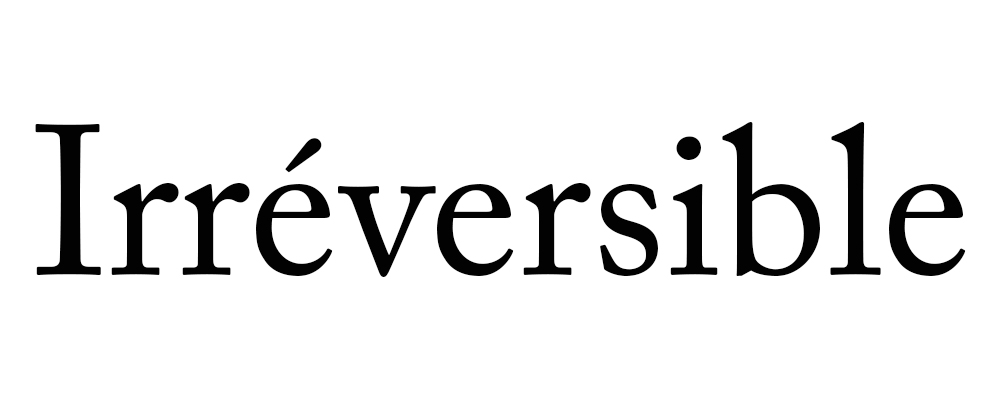















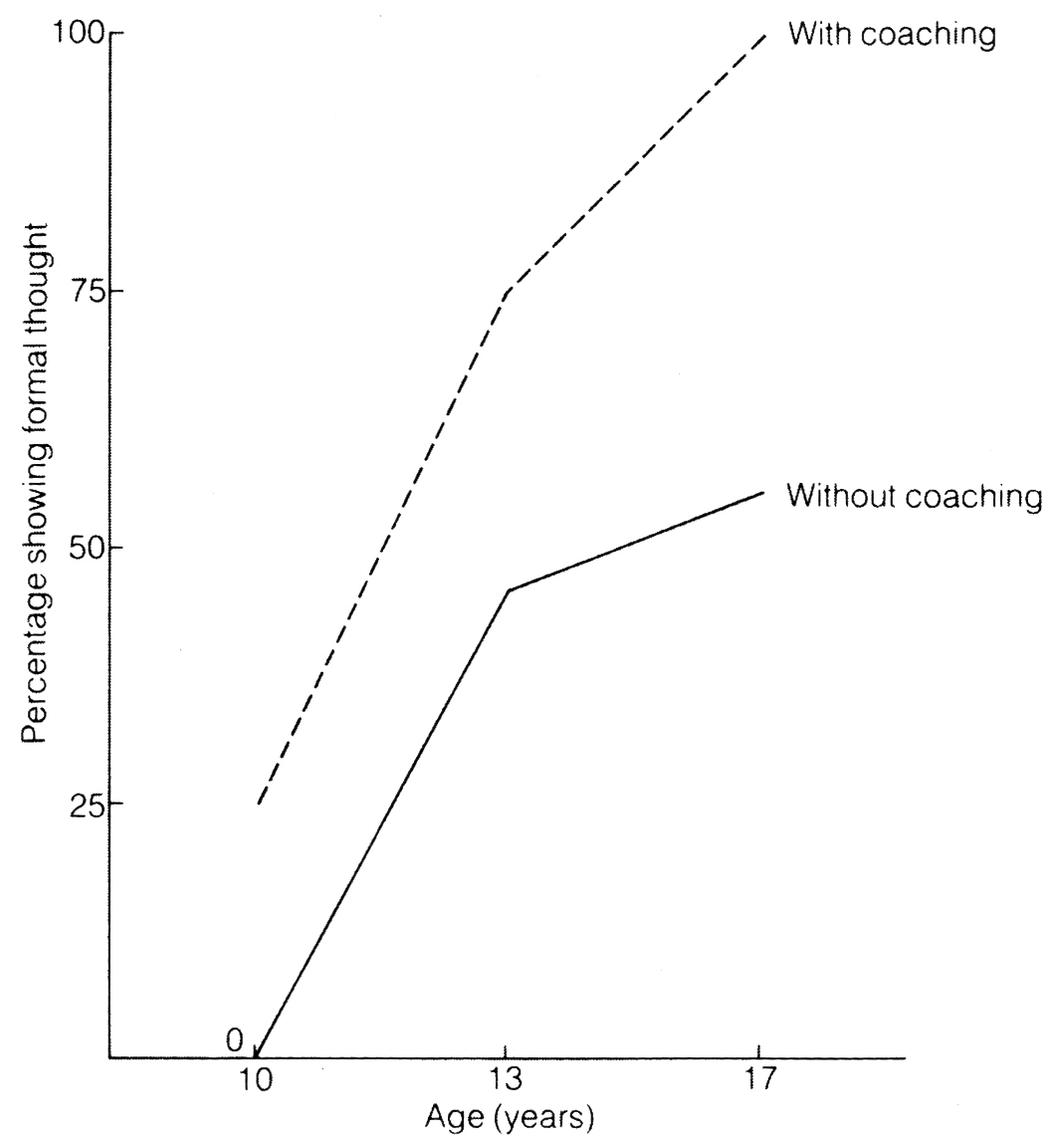




















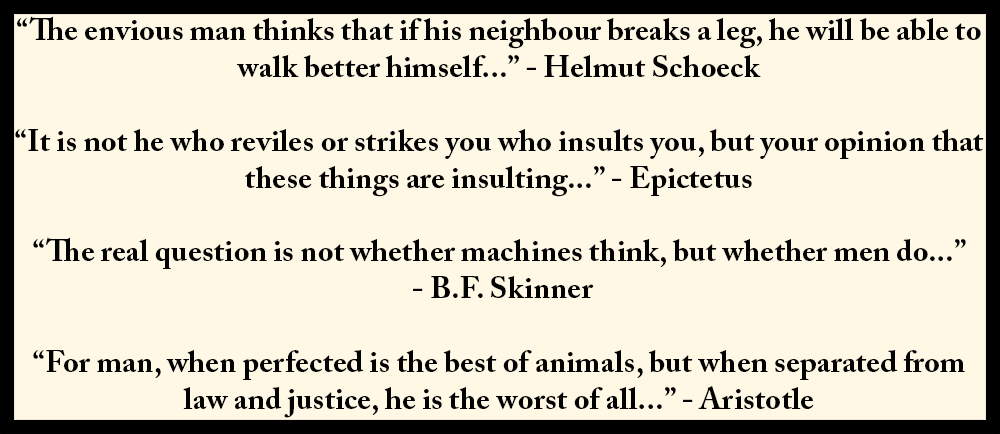


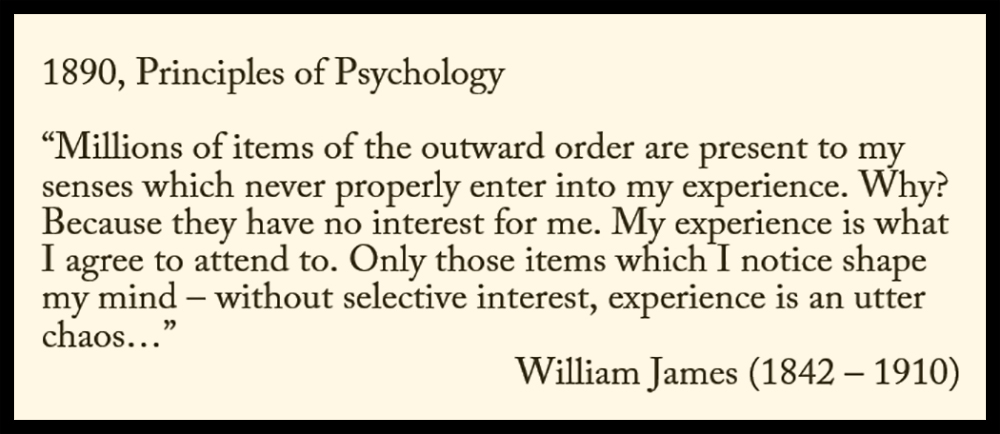








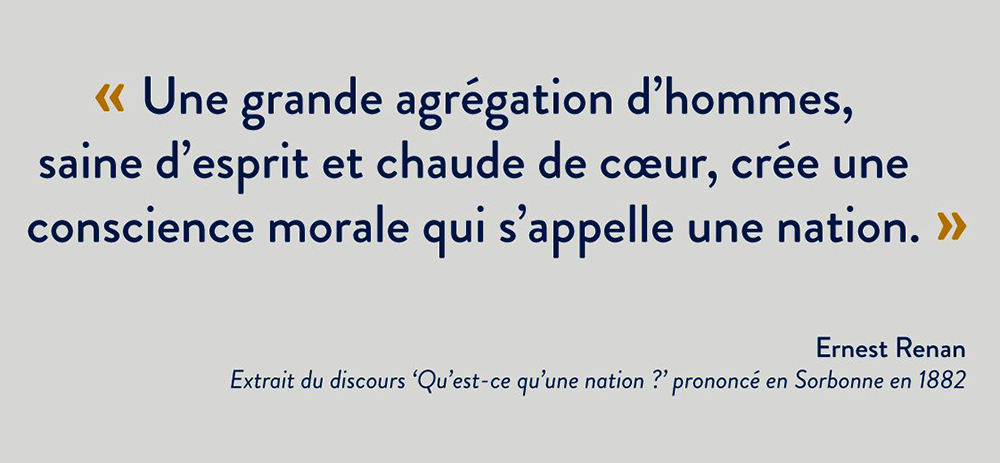






















































































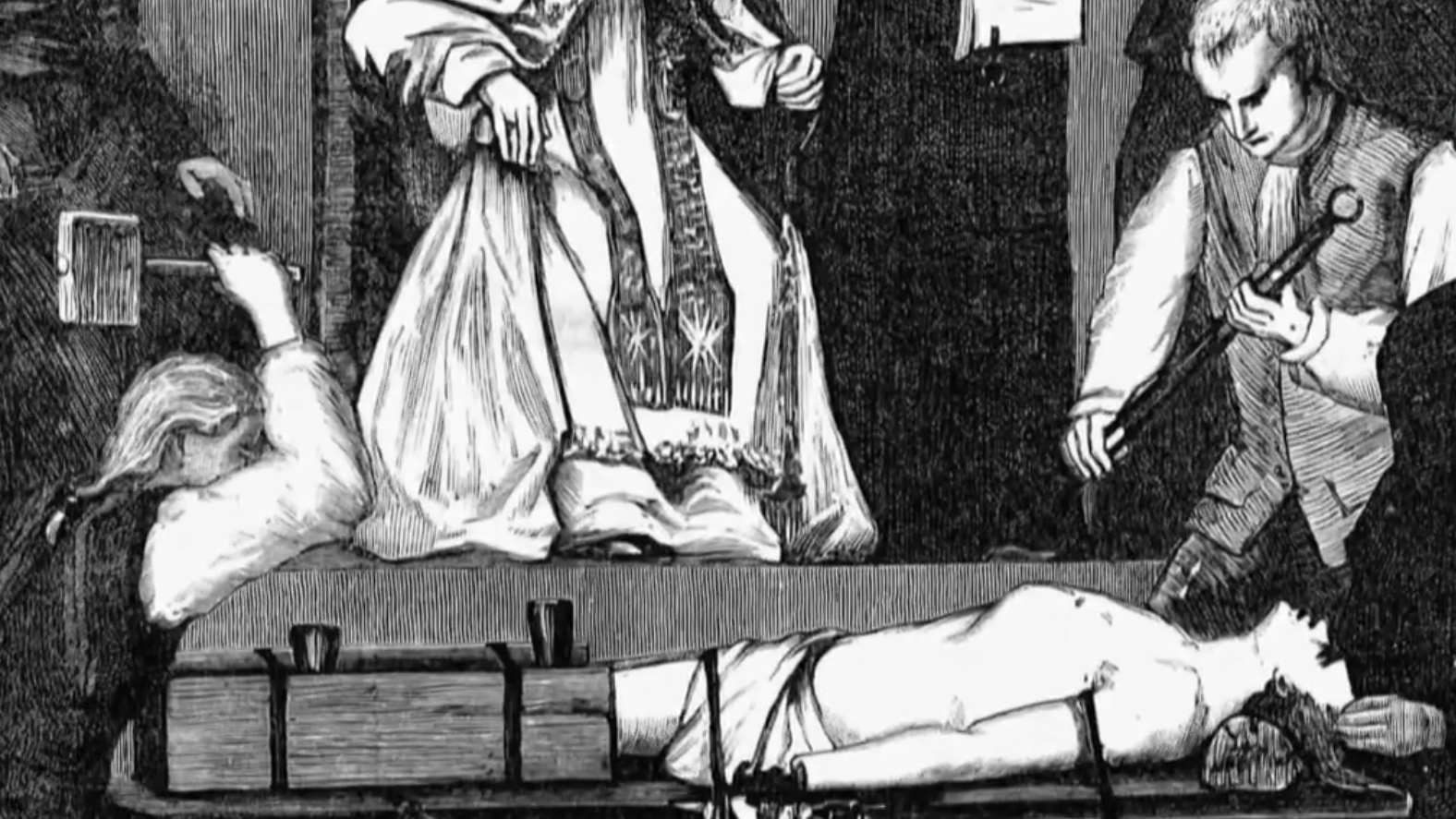




















![Dieu et mon droit [Royal_Coat_of_Arms_of_the_United_Kingdom]](https://dannydpurb.files.wordpress.com/2019/04/dieu-et-mon-droit-royal_coat_of_arms_of_the_united_kingdom.jpg)

